- Skip to global NPS navigation
- Skip to the main content
- Skip to the footer section


Exiting nps.gov
Thing to Do
Walk the Freedom Trail
Boston National Historical Park
Originally conceptualized in the 1950s, the Freedom Trail ® is an iconic symbol of Boston. Its red brick line snakes through some of the oldest parts of the City, navigating visitors to some of the most significant historic sites in the Downtown, North End, and Charlestown neighborhoods of Boston. The trail itself does not necessarily tell a narrative. Rather, it aids tourists with a starting point—an opening sampler of Boston's storied, complicated, and multi-faceted history. While many sites are primarily recognized for their role in the American Revolution, all the sites on the Freedom Trail ® remained significant because of the role they played in subsequent social, political, and religious movements, controversies, and challenges.
Exploring Boston's History
Some choose to walk the entire 2.5 mile trail, end to end. Others select a handful of sites of particular interest and focus on those places. Visits can be as short as a few hours—however those who wish to enter every historic site and explore what each site has to offer can spend a full weekend along the Freedom Trail.
Guided tours are available seasonally from both National Park Service staff and through private organizations. Generally, few public tours walk the entire trail. Many sites are part of Boston National Historical Park, however they are independently owned and operated and may charge admission fees.
Free Self-Guided Audio Tour
The National Parks of Boston have developed a FREE Freedom Trail ® Audio Tour for visitors. This tour is available online on our Freedom Trail® Audio Tour webpage , or by downloading the NPS App. Once downloaded, search "Boston National Historical Park" and select "self-guided tours."
- Stairs to the 54th Massachusetts/Robert Gould Shaw Memorial: When in the Boston Common, head toward the Park Street MBTA station at the intersection of Park and Tremont Streets. Follow the sidewalk up Park Street toward Beacon Street.
- Stairs to enter the Granary Burying Ground can be bypassed by entering an at-grade entrance off Beacon Street. When at the main entrance at Tremont Street, continue down Tremont to the intersection with Beacon Street. Turn left to head up Beacon Street. The first alleyway to the left ends with an at-grade entrance to the Burying Ground.
- Old State House can only be entered via stairs.
- When following the trail from Paul Revere Park to the Old North Church, a detour around the block on Tileston Street is required.
- Copp's Hill is only accessible by stairs.
- USS Constitution and USS Cassin Young are historic ships with stairs, ladders, and gangways that move with the tide.
- boston national historical park
- freedom trail
Sort By: Relevance Recently Updated Date Released Title
Show 10 40 per page
Last updated: May 22, 2023
Your browser is not supported for this experience. We recommend using Chrome, Firefox, Edge, or Safari.
GET YOUR FREE
Visitor guide, subscribe to our, e-newsletter, online store, the freedom trail®, walk through america’s history.
The famous Freedom Trail is a 2.5-mile red-brick trail through Boston’s historic neighborhoods that tells the story of the American Revolution and beyond. From the Old North Church to Faneuil Hall, and through resonant burying grounds, visit the temples and landmarks of the Revolutionary Era.
Freedom Trail Sites | Map of the Freedom Trail | Freedom Trail Walking Tours | FAQ
Freedom trail sites.
Begin your journey at the Boston Common Visitor Information Center located at 139 Tremont Street and conclude at the USS Constitution in Charlestown.
BOSTON COMMON
Massachusetts state house, park street church, granary burying ground, king’s chapel & burying ground, boston latin school site/benjamin franklin statue, old corner bookstore, old south meeting house, old state house museum, boston massacre site, faneuil hall, paul revere house, old north church, copp’s hill burying ground, uss constitution - old ironsides, bunker hill monument.
The Boston Common is America’s oldest public park, purchased from Wm. Blackstone in 1635 to be used as common grazing land for the feeding of cattell . The British militia used it as a trayning field.
The Common has also been the site of hangings, duels, public celebrations and spirited oratory. Today it continues to host public celebrations as well as concerts, ice skating, Shakespearean plays, holiday festivities, sports activities and public rallies.
Designed by Charles Bulfinch, the State House was completed in January 1798 at a cost of $133,333 (more than five times the budget). John Hancock, a wealthy merchant, patriot, signer of the Declaration of Independence and the first elected Governor of Massachusetts originally owned the land. The oldest building on Beacon Hill is now the seat of the Massachusetts state government. The golden dome, one of Boston’s distinguishing landmarks, wasn’t always gilded. It was originally built of wood. Paul Revere & Sons was commissioned in 1802 to cover it with copper to prevent water leakage. In 1874, the dome was gilded with 23-karat gold leaf.
Park Street Church acquired the nickname Brimstone Corner, both in reference to the fire-and-brimstone sermons and to the gun powder that was stored in the crypt during the War of 1812. Founded in 1809, the Church’s 217-foot white steeple was the first landmark a traveler saw upon approaching Boston.
On July 4, 1829, abolitionist William Lloyd Garrison gave his first public anti-slavery address here, and two years later, on July 4, the hymn America, better known as My Country ’Tis of Thee, was first sung on the Church steps.
So named because of its proximity to Boston’s first granary, this is the most visited burying ground in Boston and the final resting place of many prominent Bostonians. Buried here are John Hancock, Samuel Adams, nine governors, all five Boston Massacre victims, Paul Revere, Ben Franklin’s parents and Peter Faneuil.
Under orders from King James II in 1686, land was seized, and the first Anglican Church was constructed. By 1749, the original wooden structure was too small for the congregation, and so the Georgian chapel was constructed around the original church.
Adjacent to King’s Chapel is Boston’s first burying ground. Here you will find the graves of John Winthrop, Massachusetts’ first governor; William Dawes, Paul Revere’s compatriot who also made the ride to Lexington, and Mary Chilton, believed to be the first woman to step off the Mayflower.
Embedded in the sidewalk in front of Old City Hall is the mosaic City Carpet, which commemorates the site of the first public school in the U.S., Boston Latin School (1635). Among the school’s alumni are Ben Franklin, John Hancock, Samuel Adams, Charles Bulfinch and Ralph Waldo Emerson.
Richard Greenough’s statue of Ben Franklin, erected in 1856, prominently stands in front of Old City Hall. Look closely at Franklin’s face. The sculptor said that he found the left side of the great man’s face philosophical and reflective and the right side funny and smiling.
The original building on this site was the home of Anne Hutchinson, who was banished from Massachusetts in 1638 for her unorthodox religious views. By the mid-1800s, the Old Corner Bookstore was a flourishing literary center. Here, Ticknor and Fields published works by Dickens, Harriet Beecher Stowe, Tennyson, Hawthorne, Emerson, Longfellow, Oliver Wendell Holmes, Elizabeth Barrett Browning and Julia Ward Howe among others. The Atlantic Monthly, a Boston institution, was originally published here as well. Today, the building continues as a place of commerce.
Built in 1729, this is the second oldest church in Boston. The largest building in colonial Boston, Old South was used for public meetings when the angry crowd outgrew Faneuil Hall. Many of the crucial events that led up to the Revolution took place here. The most famous of the meetings was held on December 16, 1773, when over 5,000 gathered to protest the tax on tea.
During the British occupation of Boston in 1775-1776, British troops desecrated this sanctuary of freedom by using it as a stable and riding school, while drinks were served from the balcony. The pulpit and pews were chopped into firewood and the library was used as kindling.
On another note, Phillis Wheatley, the first female African American published poet, was a full member of the Meeting House. An original copy of her work is on permanent display here.
Built in 1713, the Old State House is Boston’s oldest surviving public building. It was the center of political and commercial life, housing the merchant’s exchange (a precursor to today’s stock exchange) on the ground floor and the royally appointed government offices and the freely elected members of the Assembly of the Massachusetts Bay Colony on the upper floors.
The site played a central role in the story of rebellion, from James Otis’ 1761 speech against the Writs of Assistance to the Boston Massacre in 1770 to the reading of the Declaration of Independence from the east balcony in July 1776.
Adjacent to the Old State House, a ring of cobblestones commemorates the Boston Massacre. Five men were killed in this clash between Colonists and Redcoats. Among the slain men was Crispus Attucks, the first African American to die for the patriotic cause.
Interestingly, John Adams and Josiah Quincy, loyal to justice as well as the patriotic cause, defended the British soldiers. All but two were acquitted. The guilty had their thumbs branded and were then set free.
The building was a gift from wealthy merchant Peter Faneuil in 1742. Faneuil Hall served as a meeting place and an open-air market. It was here that Bostonians met to form their opposition to British authority. As a result of the impassioned speeches by such patriots as Samuel Adams and James Otis, the nickname Cradle of Liberty was earned, especially when citizens rallied against the Sugar Act, the Stamp Act, the Townsend Acts and the landing of British troops.
Charles Bulfinch enlarged the building in 1806. After the Revolution, Bostonians continued to gather at Faneuil Hall for the anti-slavery speeches of William Lloyd Garrison, Wendell Phillips and Frederick Douglass. The women’s rights movement, early temperance rallies and nearly every war since 1812 have been debated within these walls.
Built around 1680, the Paul Revere House is the oldest remaining structure in downtown Boston, and only official Freedom Trail site that is a home. It was from here that its famous occupant set out for the midnight ride. Revere was not only a patriot, but also an expert silversmith, copper manufacturer, part-time dentist, engraver and the father of 16 children. As many as eight children lived here with him, along with his mother, his first and (after 1773) his second wife.
It was from this steeple that Sexton Robert Newman hung two lanterns on April 18, 1775, to signal the beginning of Paul Revere’s momentous ride. The action is widely regarded as the spark that ignited the American Revolution.
Built in 1723, Old North is Boston’s oldest church building. See a wealth of historic works, including the first bells brought to the Colonies, its original 18th-century brass chandeliers and clock, and the 17th- century carved angels that were captured by a Colonial privateer. More than 1,000 individuals lay in rest in the underground crypt, including the Royal Governor’s second-in-command at Lexington and Concord.
Copp’s Hill was Boston’s largest colonial burying ground, dating from 1659. Some notables buried here include the Mather family, a very prominent New England ministerial family; Edmund Hartt, builder of the USS Constitution; Robert Newman, who hung the lanterns for Paul Revere’s ride, and Prince Hall, anti-slavery activist, Revolutionary soldier and founder of the African Grande Masonic Lodge. Copp’s Hill is also the final resting place of countless free African Americans.
Because of its height and prominent location overlooking Boston Harbor, the British used the burying ground to aim their cannons on Charlestown during the Battle of Bunker Hill. Target practice was also conducted here. Be sure to take a look at the grave marker of Daniel Malcom, a member of the Sons of Liberty.
Launched in Boston in 1797, the USS Constitution is the oldest commissioned warship afloat in the world. Her nickname was earned during the War of 1812 when British cannonballs appeared to bounce off her impenetrable hull and the seamen cried out Huzzah! Her sides are made of iron! Today she is manned by an active duty U.S. Navy crew and docked in the Charlestown Navy Yard.
The Battle of Bunker Hill was one of the bloodiest battles of the American Revolution. "Don’t fire until you see the whites of their eyes!" became the legendary battle cry, according to lore, and immortalized the determination of the ill-equipped Colonists who stood facing the powerful British Army on June 17, 1775. Today the 221-foot granite obelisk commemorates the site of this first major battle.
Map of the Freedom Trail
Freedom trail walking tour operators.
Stop by a Visitor Information Center to purchase a ticket. Tours leave from the red brick line in front of the Boston Common Visitor Center.
Freedom Trail® Foundation — Official Freedom Trail Tours®
- (617) 357-8300
Boston By Foot, Inc.
- 87 Mount Vernon Street
- (617) 367-2345
Boston Town Crier - Tours of Freedom Trail
- (617) 794-7512
Hub Town Tours: Freedom Trail Small Group Tour
- 7 Marshall Street
- +1 (844) 482-8696
Tour of the Freedom Trail
- Boston Common Visitor Center
- (978) 741-1170
Action Tour Guide: Self-Guided Walking Tours in Boston
Boston Freedom Trail & Bunker Hill GPS self-guided audio tours: Experience the rich history of Boston and its role in the American Revolution with the Freedom Trail & Bunker Hill…
Activities & Events
Heart of the freedom trail guided walking tour.
This 1 hour tour is the perfect introduction to Boston’s Revolutionary history! Visit some of the key sites along the world-famous…
Revolution's Edge
Revolution’s Edge takes us to the afternoon of April 18, 1775, hours before the signal lanterns would shine from Old North’s…
Road to Revolution Guided Walking Tour
Explore the makings of a revolution! From the Boston Massacre to Paul Revere’s midnight ride, the birth of the American Revolution…
Throw Tea into the Boston Harbor!
Experience life at sea aboard an 18th-century sailing vessel as you join a Son of Liberty and take part in the “Destruction of the…
Tour: Benjamin Franklin - Son of Boston
Celebrate the life of Benjamin Franklin on this guided walk along his homes and haunts in Colonial Boston. Born in Boston, he came…
Macy's Great American Fashion Show
The Macy's Fashion Show in Boston, MA is a highly anticipated annual event that showcases the latest trends and styles from…
Boston Harborfest Fireworks
Visible from several vantage points along the Inner Harbor, the Harborfest Fireworks return to provide a spectacular display for…
Chowderfest
Don't miss a chance to sample this iconic Boston fare from some of the finest restaurants in the city and to cast a vote for best…
Harborfest Fireworks Cruise
Start the Independence Weekend festivities this year onboard the Valiant for a cruise to view the spectacular fireworks for…
USS Constitution: 21-gun Salute
On July 3, cheer on USS Constitution’s Independence Day underway and celebrate our Military Community at the free Huzzah! Salute…
Boston Pops Fireworks Spectacular
The Boston Pops July 4th Spectacular is returning for 2024! The Boston Pops July 4th Spectacular is slated to take place at the…
Guided Tour: Footloose on the Freedom Trail
A Boston tradition! Footloose on the Freedom Trail is a 3-hour guided walking tour of the entire Freedom Trail from the Boston…
Reading of the Declaration of Independence
The Reading of the Declaration of Independence in Boston, MA is a cherished tradition that brings history to life. Held annually…
Freedom Trail FAQs
How long is the freedom trail.
The Freedom Trail is a 2.5-mile red-brick path featuring a unique collection of 16 historic sites throughout Downtown, the North End, and Charlestown. How much time it takes to see the entire Trail depends on how much time one dedicates to each site. Most guided walking tours take around 90 minutes and cover 1 mile of the Trail.
Where does the freedom trail start?
We recommend starting your journey at the Boston Common Visitor Information Center at 139 Tremont Street and concluding at the USS Constitution in Charlestown. However, the suggested Freedom Trail route is based solely on geographical location, and sites can be visited in any order.
Does it cost money to experience the Freedom Trail?
There is no fee associated with walking the Freedom trail, making it the perfect activity during your visit to Boston! There is, however, a fee associated with admission to some historic sites and guided walking tours. Visit the map above for more information on site admission.
How do I buy walking tour tickets?
Tickets to guided tours of the Freedom Trail can be purchased online or at the Boston Common Visitor Information Center (139 Tremont Street, Boston, MA 02108).
Is the Freedom Trail wheelchair-accessible?
Yes, the Freedom Trail and guided walking tours are wheelchair accessible.
Are dogs allowed on the Freedom Trail?
Yes, dogs are allowed on the Freedom Trail as it is a path on city sidewalks and in public spaces such as Boston Common, Bunker Hill Monument grounds, and Charlestown Navy Yard. Dogs are not permitted in the historic burying grounds or the historic sites’ buildings. Please call historic sites directly to inquire about service animals.
Where can I find maps of the Freedom Trail?
A downloadable map of the Freedom Trail can be found here .
View All Trails & Tours
Retrace the steps of Boston's first Gay Pride March, uncover the stories of a thriving colonial-era black community, walk in the footsteps of Irish immigrants, or discover Boston's innovative spirit. Check out Boston's top walking tours.
Museums & Attractions
Home to world-renowned museums, storied sports stadiums, star-studded concert venues, and distinguished performance theaters, you'll find what you're looking for in Boston.
Top Things to Do in Boston
Hotel packages in boston, plan your trip.
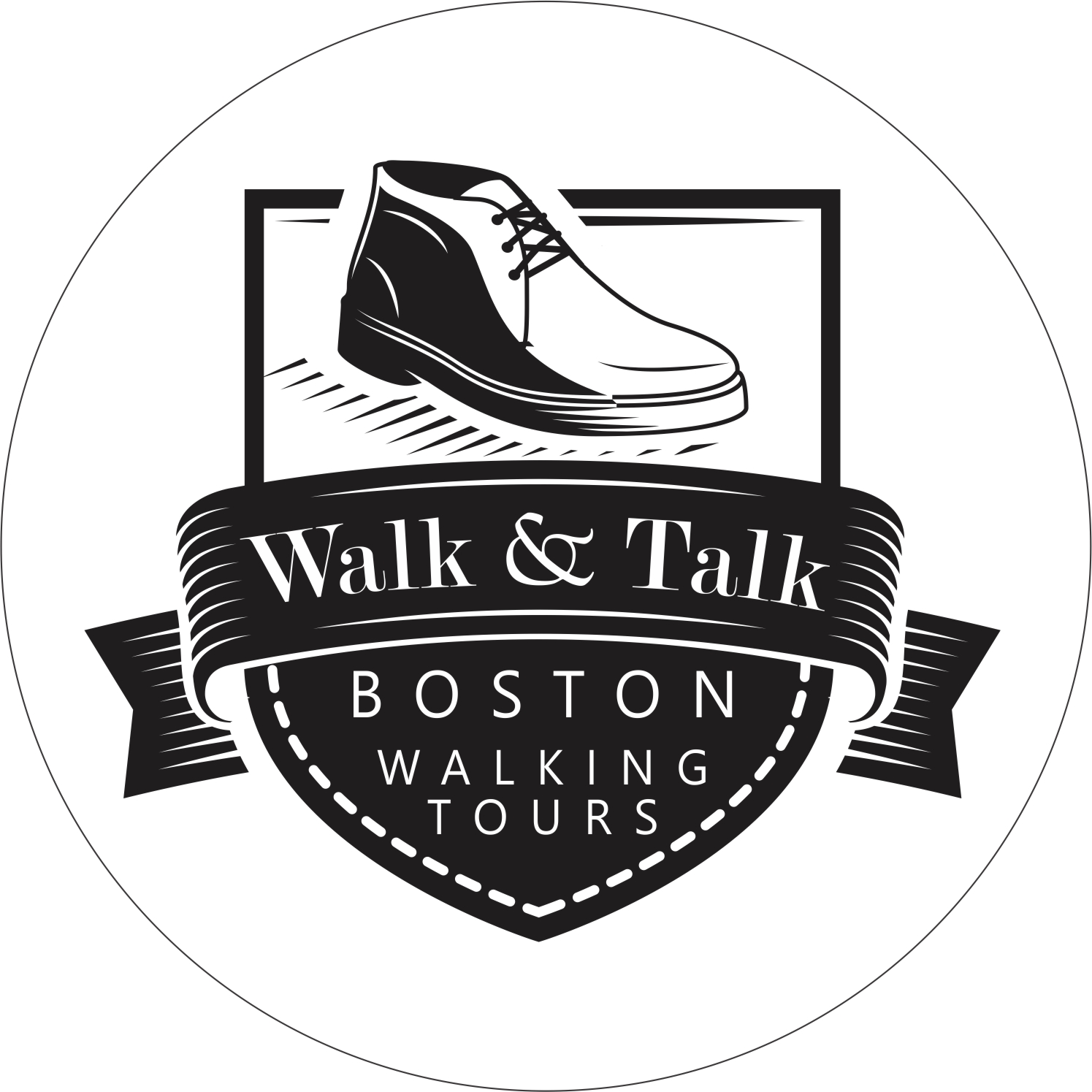
The Complete Freedom Trail
- Starting Point : In front of the Massachusetts State House
- Ending Point : The USS Constitution, Charlestown Navy Yard
- Who should take this tour : People with a passion for history who wish to explore the entire Freedom Trail and gain a real understanding of the events leading to the American Revolution.
- Time & Mileage : 10:00AM to 2:00PM. Distance: 2.75 miles. Click the “Book Now” button below to see exact dates available.
- Maximum tour attendees permitted : 16
If you are looking for a tour that covers the entire Freedom Trail, this is it! This is the most comprehensive tour of the Freedom Trail you will find and includes all stops, including actually visiting Bunker Hill and the USS Constitution.
The Freedom Trail connects sixteen locations in historic Boston. Each is interesting in its own right, but together, they tell the story of the conflicts that lead to the Colonist’s decision to risk everything they held dear and challenge the greatest military power in the world for the right to form a new nation.
Your tour will include a stop at each of the sixteen sites to learn its significance in the events that lead to the Boston Massacre, the Boston Tea Party, the battles of Lexington and Concord, the Battle of Bunker Hill and the subsequent departure of British forces from Boston Harbor.
Our tour narration weaves the events of the Revolution together into a cohesive story of the people and events that took place in Boston from the time of the first settlers in 1630 until war raged in Massachusetts and beyond.
The focus is on the people and key events of the Revolution. What really happened, who made it happen, and the outcomes of events like the Tea Party, Massacre, and Battle of Bunker Hill.
- Notes: This tour does not include entrances and admission fees to interiors of buildings such as Old South Meeting House, the Old State House or the home of Paul Revere. We’re happy to give advice on which buildings to visit after your tour ends.
- Adults: $78.99 ($74.52 + $4.48 fee)
- Seniors (65+): $73.99 ($69.81 + $4.19 fee)
- Youths (Under 16): $73.99 ($69.81 + $4.19 fee) (Please note, we do not recommend this tour for children under 12 years old.)
- Little Ones (Under 4): Free
- Private Tour: $790 ($745.23 +$44.27) (maximum of 20) Please visit the Private Tours page for more information.
Weather and Cancellations
I attempt to offer all tours, rain or shine, except when the weather is simply too severe. Tours will cancel if there is a threat of thunderstorms or similarly challenging or dangerous weather.
If you wish to cancel your participation in a public tour, you may do so using the contact form or the email and phone contacts in your tour confirmation letter. Persons who cancel with at least 18 hours from the start of the tour will receive a full refund. If you need to cancel with less notice, let me know. I always attempt to reschedule with no penalty. Cancellations or “no-shows” that cannot be reschedule are not eligible for a refund.
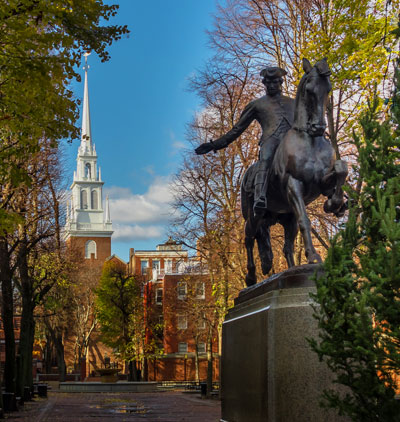
Boston Freedom Trail in a Day | Guide + Map
By: Author Emily
Posted on Last updated: September 26, 2023
If you’re heading to Boston, there’s a good chance the Freedom Trail is on your itinerary. As it should be! The Freedom Trail is a great way to explore Boston and see some of the city’s oldest and most historic sites. If you’re looking for some help planning your day around the Freedom Trail, this guide is for you!
In this post, we’ll outline a complete day on the Freedom Trail. We’ll start with an intro to the Freedom Trail, as well as some tips and a detailed map. Then we’ll explore each individual stop, including a touch of history and exactly what to expect from the experience.
This one-day Freedom Trail itinerary includes more than just the official stops, too. We’ve peppered in some other great stops along the way to build out a perfect day in Boston. Let’s get started!
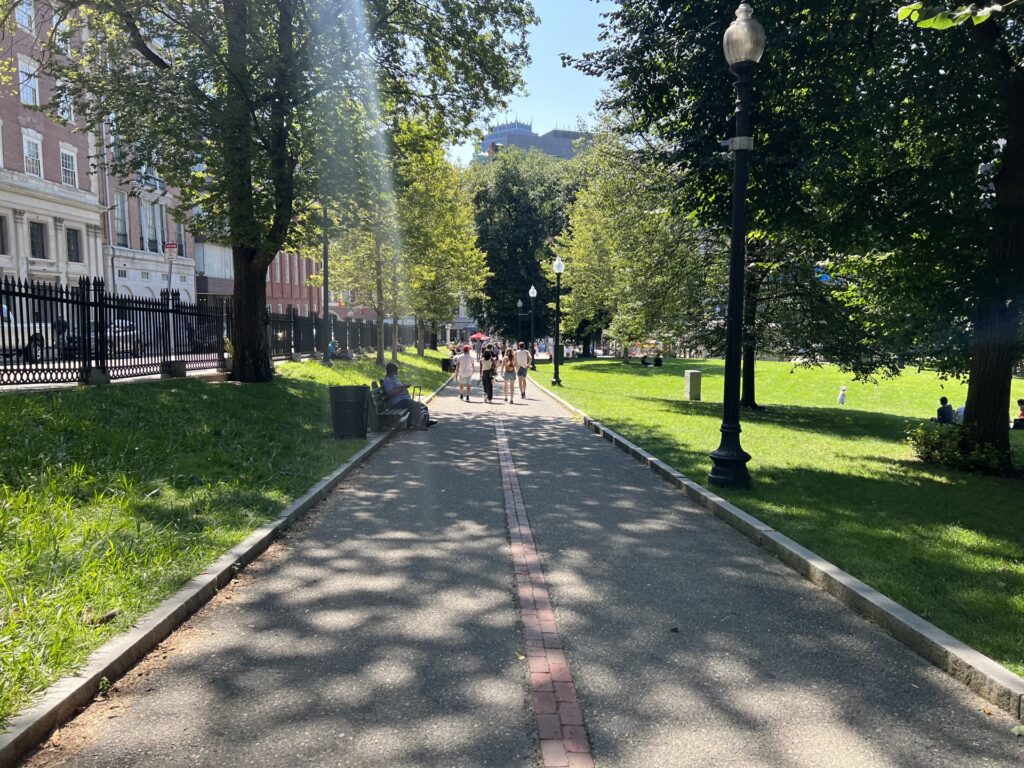
What is the Freedom Trail?
The Freedom Trail refers to a collection of 16 historical sites around Boston, which are all connected by a physical brick trail on the ground. The sites range in scope and significance, but primarily focus on the American Revolution era.
The official Freedom Trail sites are as follows:
Boston Common
Massachusetts state house, park street church, granary burying ground, king’s chapel.
- Boston Latin School & Ben Franklin Statue
- Old Corner Bookstore
Old South Meeting House
Old state house, boston massacre site, faneuil hall, paul revere house, old north church.
- Copp’s Hill Burying Ground
- USS Constitution
- Bunker Hill Monument
The Freedom Trail is 2.5 miles long, but the sites are not evenly distributed along the trail. Most of the sites are pretty close together along the first mile of the trail. The last four stops, from Old North Church to Bunker Hill, comprise the final 1.5 miles of the trail.
It’s free to walk the Freedom Trail, but some sites have entry fees to go inside. If you paid for admission for all of the ticketed attractions on the Freedom Trail, it would cost $34-$39 per adult.
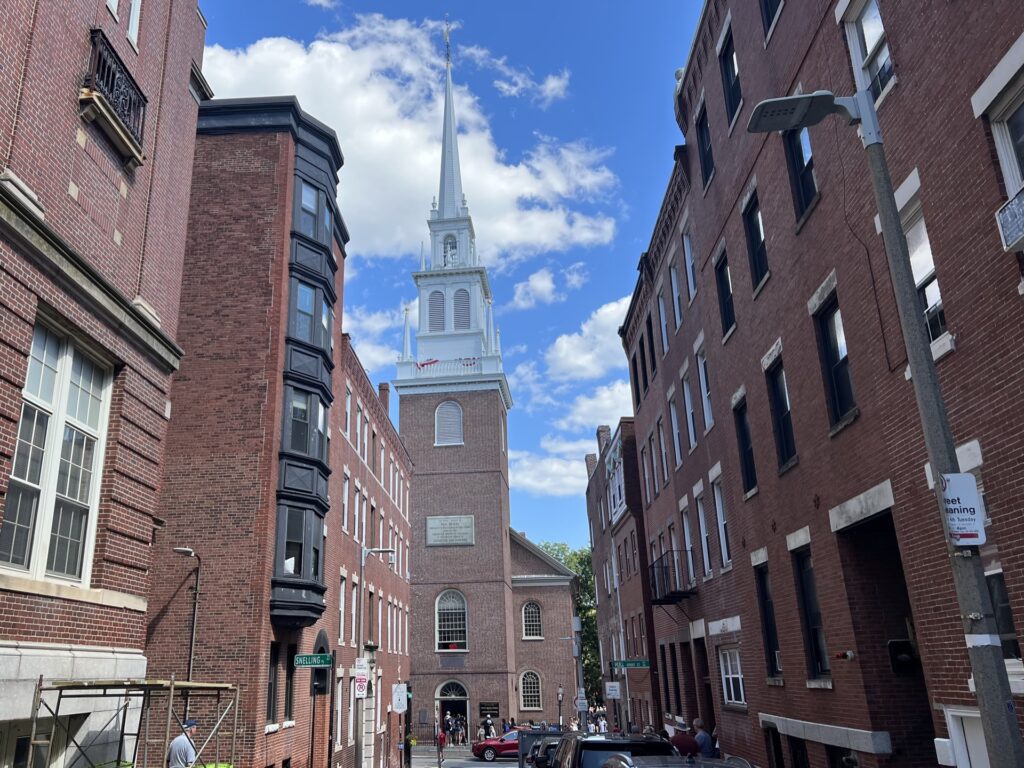
General Tips for the Freedom Trail
- Start early. There are a lot group tours of the Freedom Trail. Many of the sites are small anyway, and these groups can really jam things up. Many of the tours start around 9, so I’d suggest starting around 8:30 to keep in front of them.
- Download the National Park Service App. The NPS app has an audio guide for the Freedom Trail. There’s also a text option if you prefer to read instead of listen. It’s a great way to learn a bit of history about each place on the trail, as well as some other sites along the way. The app is tricky to navigate though, so I’d suggest getting used to it before you go.
- Check the hours for each site. Not all of the buildings are open to go inside everyday. For example, the Massachusetts State House is only open on weekdays and Park Street Church is only open on Sundays. This means you might want to plan to do the Freedom Trail on a specific day based on what you want to see.
- If you want to see it all, split the Freedom Trail over two days. You can do the full Freedom Trail in a day, but it’s a lot. You’ll get so much more out of the last two sites if you do them on a different day.
- Plan for the weather. The Freedom Trail requires a lot of walking outside. The weather can play a huge role in making that extremely pleasant or extremely unpleasant. Our visit in late July was very hot. I expect a winter visit would be equally uncomfortable. Whatever season you travel in, dress for that weather, paying extra attention to weather appropriate and comfortable shoes.
- Skip the tour. You can get a ton of great information about the Freedom Trail on the NPS app in text and audio form. Tour groups tend to be slow and crowded at the smaller sites. Walking the Freedom Trail on your own gives you more flexibility to see and do what you want, at your own pace.

Boston Freedom Trail Walking Map
To help guide you on this historic walking tour through Boston, we’ve put together a map with every stop we mention in this itinerary.
This map doesn’t include an actual walking route between the sites. Why? Because you won’t need one! The Freedom Trail is marked by a brick trail on the ground that will guide you the entire way. You literally can follow the (red) brick road.
- Red : Official Freedom Trail stops recommended in this itinerary
- Orange : Official Freedom Trail stops we’d suggest saving for another day
- Blue : Unofficial stops that are worth a visit
A few tips for using this map.
- To view the map in Google Maps, click the expand icon on the top right corner.
- Click the star icon to save the map to your Google account for later.
- To access the map next time, open Google Maps > click the Saved tab > click Maps.
Without any further ado, let’s get started!
Coffee & Breakfast at Tatte Bakery & Cafe
- Official Freedom Trail stop: No
- Site type: Coffee Shop
- Hours: Daily, 7/8 AM till 4/8 PM depending on location and day
- How long to stay: 45 minutes
- Tip: Get your food and coffee to go and make it a picnic at Boston Common.

It’s going to be a long day, so be sure to start with coffee and breakfast. One of our favorite breakfast spots in Boston is Tatte Bakery & Cafe (pronounced like latte). It’s a Boston staple, and they have several locations in the city and throughout Massachusetts. Their locations on the south side of Boston Common ( her e ) or at One Boston Place ( here ) are the most convenient for the Freedom Trail.
We loved that you can grab a coffee and pastries to go or you can sit down and enjoy a full breakfast. We chose the latter and it was perfect. The halloumi breakfast sandwich was 10/10 and the pancakes lasted us three days! (We dropped the leftovers in our hotel fridge before heading out on the trail.)
- Official Freedom Trail stop: Yes
- Site type: Park
- What to do there: Stop by the visitor center at the official start of the Freedom Trail
- Hours: The park is open daily from 6:30 AM – 11 PM, but the visitor center is only open from 8:30 AM – 4:45 PM.
- How long to stay: 30 minutes
- Bathrooms: Yes
- Tip: If you have little ones, be sure to visit the Tadpole Playground. There isn’t a ton of kid-specific stuff to do on the trail, so this is a good one to take advantage of. There’s also a carousel just across the pond.
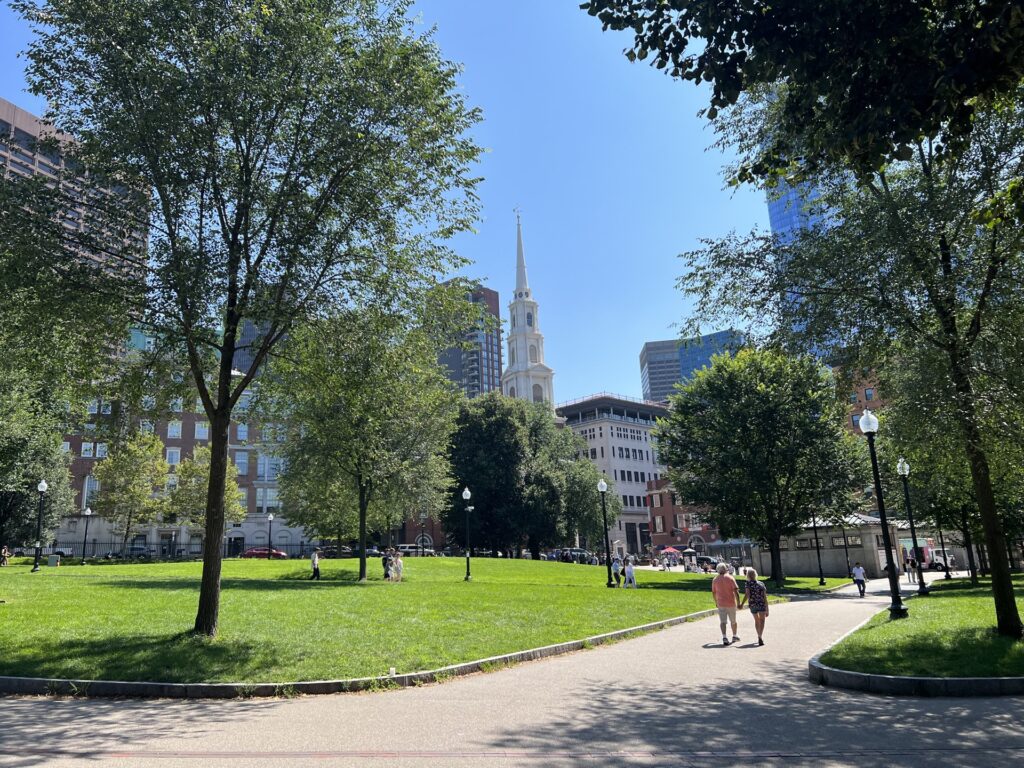
Dating back to 1634, Boston Common is the oldest city park in the US. There’s a pond in the middle, which becomes a skating rink in the winter months. In addition to 50 acres of green space, there are a few sculptures and statues, a lovely fountain, and a playground and carousel for kids.
The Boston Common Visitors Center is located on the south side of the park near the intersection of Tremont St and West St. The visitor center is small, but has a few guide books and souvenirs available for purchase.
Most importantly, the Freedom Trail officially starts in front of the visitor center in Boston Common. The brick trail goes through a small portion of the park. If you haven’t otherwise spent time in Boston Common, you might want to take a larger lap around the park.
- Site type: Building
- What to do there: Self-guided or guided tours are available during open hours, otherwise you can just see the building from the outside.
- Tickets: All tours are free. You must reserve guided tours in advance by calling 617-727-3676. For self-guided tours, stop by the Tours and Information Desk on the second floor for a map.
- Hours: Monday through Friday, 8:45 AM – 5 PM
- How long to stay: 1 hour for a tour (self-guided or guided) or 10 minutes to see the outside
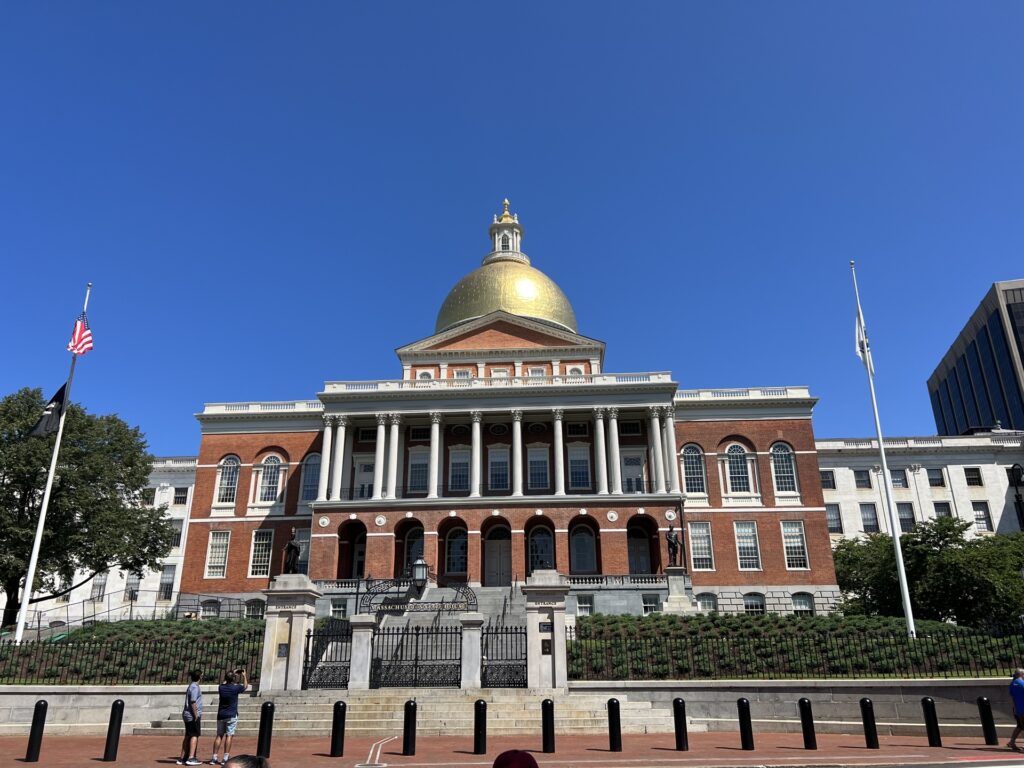
The Massachusetts State House was completed in 1798 on land once owned by John Hancock. Today, the state house is an active government building where the governor, state legislature, and other officials have offices.
On weekdays, certain parts of the state house are open to the public for free guided or self-guided tours. Some of the most popular things to see inside are the Hall of Flags and the library on the second floor. Since we were visiting on a weekend, we didn’t have the chance to go inside. Check out this post for a guide to the best things to see inside the Massachusetts State House .
If the inside is closed or you’re just not interested in going inside, you can simply stop to view the building from the outside. The front of the building is right across Beacon Street from Boston Common. Its most stunning attribute is the 23k dome, which was gilded in 1997 with a price tag of $1.5 million.
- Site type: Church
- What to do there: On most days, you can just view the church from the outside. You can see the inside of the church on Sundays when services are not in session.
- Tickets: Admission is free and no reservations are required. Worshipers are also welcome to attend service.
- Hours: The church is only open on Sundays. Church services are held at 8:30 AM, 11 AM and 4 PM, and visitors can see the church outside of those times.
- How long to stay: 15 minutes
- Bathrooms: No
- Tip: Try to have something you cover your shoulders if you plan to go inside. They don’t enforce a dress code, but shoulders covered is a good rule of thumb in churches.
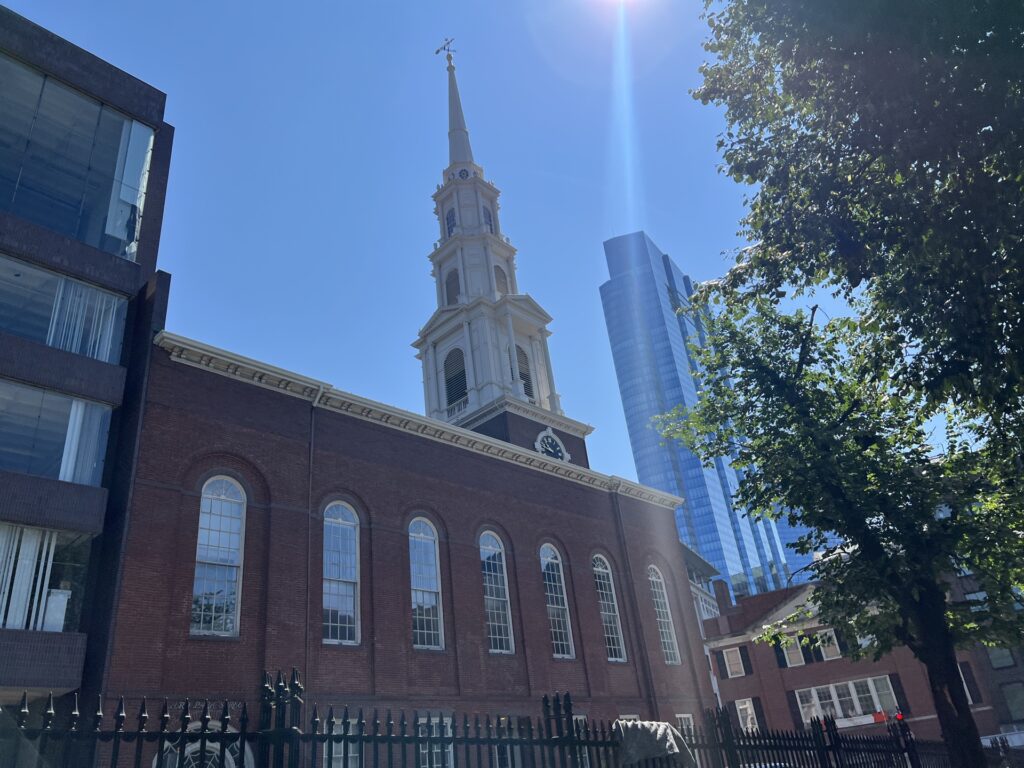
If you’ve spent any time walking around Boston before now, you’ve probably walked past this church or heard its bells chime. The church has stood on this corner since 1829, and it remains an active church today.
Though you can view the inside of this church during certain times on Sundays, most of its beauty is on the outside. You can view the church from the east end of Boston Common and along nearby Tremont Street. The inside is nice, but it has seen quite a few renovations over the years so it doesn’t hit as particularly historical.
This church will likely be a quick stop on the trail.
- Site type: Cemetery
- What to do there: Take a short walk through the grounds to see gravestones of several famous figures
- Tickets: Admission is free and no reservations are required.
- Hours: Daily, 9 AM – 4 PM
- Tip: Large tour groups can be an issue here. In many cases, they’ll take up the whole pathway as their guide explains something. Politely scoot past them or this stop will take you a lot longer than it needs to.

This burying ground is located beside Park Street Church. Here you’ll find the graves of famous revolutionary heroes, including Paul Revere, John Hancock and victims of the Boston Massacre. I found this to be the most interesting cemetery on the trail.
Often times, there will be a volunteer standing near the entrance with a map and guide to the grounds. (You can also download a copy here .) I’d recommend borrowing the map so you can easily find the important graves. The guide is free to borrow, but he accepts tips in cash or pay apps. We Venmo’d him $5, but it’s totally optional and not awkward.
- What to do there: Self-guided or guided tours are available during open hours, otherwise you can just see the building from the outside
- Tickets: $5 for entrance and self guided tour, $8 for express crypt tour, $10 for Bell and Bones and Art and Architecture Tours. You can view the tour schedule and book tickets here .
- Hours: Exact hours vary by season, but typically select weekdays and Saturdays from roughly 10 AM – 5 PM. Confirm current hours here .
- How long to stay: 5 minutes if you’re not going in or doing a tour / 15 minutes for self-guided tour / 30 minutes to 1 hour for guided tours
- Tip: Review guided tour schedules in advance and plan accordingly if you’re interested in that.
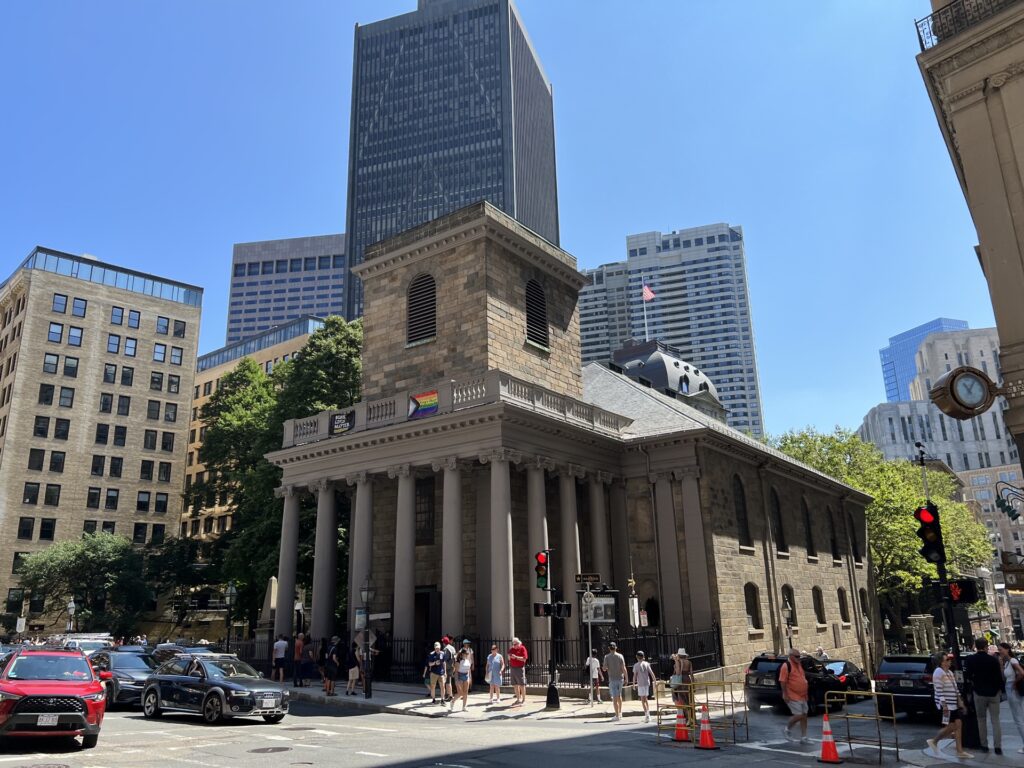
The King’s Chapel congregation was established in 1686 as the first Anglican church in New England and the first non-puritan church in Boston. King’s Chapel remains an active church today, with services on Sundays at 9 AM and 11 AM.
The building that stands today was built in 1754, and replaced the original wooden church that previously stood on the same lot. (Fun fact! They actually built the stone church around the wooden church, then took apart the wooden church inside and removed it out the windows.)
From the outside, King’s Chapel is a Georgian style stone church with a series of columns in front. The inside is of the same style with a pretty simple interior. You can see pictures of the inside and outside here . There is a small burying ground outside, which was the first in Boston.
We were visiting on a Sunday morning, so the church was closed to the public. If we were visiting on a different day, I would have probably paid the $5 to see the inside or done one of the shorter tours if it worked out with our schedule.
Boston Latin School Site & Ben Franklin Statue
- Site type: Monument
- What to do there: Photos & reflection. (Nothing to go inside or “do”)
- Tickets: NA
- How long to stay: 5 minutes
- Tip: There are seats and tables around the statue, so this can be a good spot for a break.
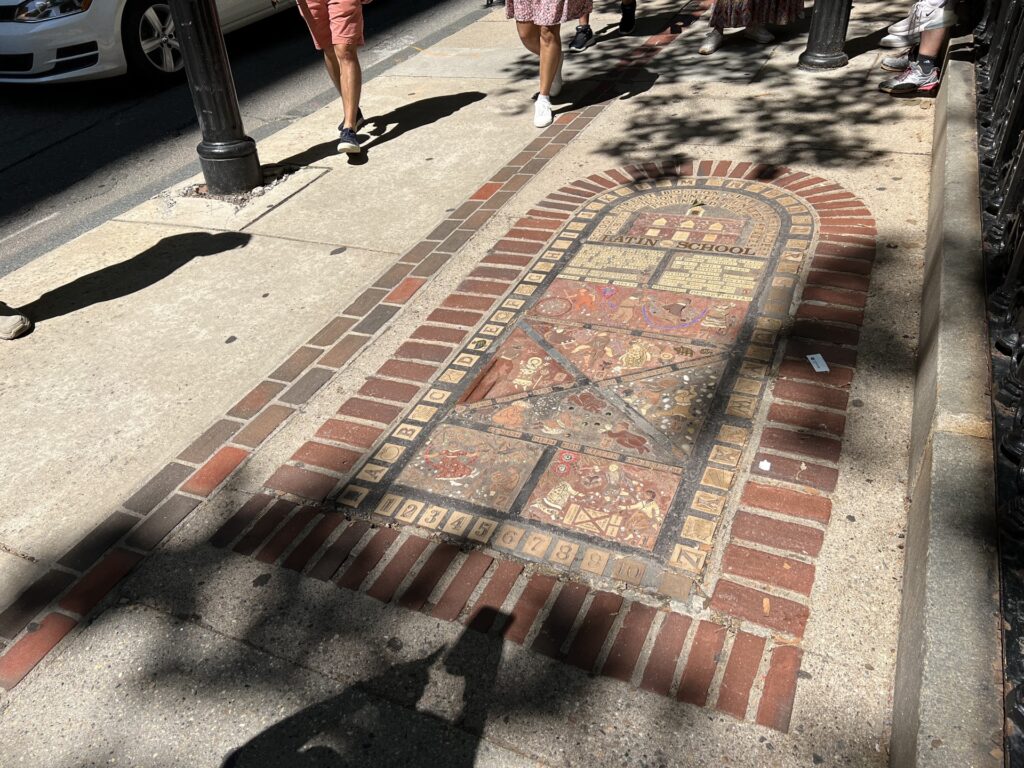
This stop includes two monuments that are located just a few feet apart. Both monuments were erected to commemorate the first location of the Boston Latin School. The history behind these sites is much more impressive than the sites themselves.
The Boston Latin School was founded in 1635 and is still an operating school to this day. It’s the oldest public school in America, and was the first to offer an education to all boys regardless of wealth or status. (A Latin Girls School was later founded in 1877s, but Girls were not admitted to Boston Latin School until 1972.)
Today, there is a mosaic monument and statue of Ben Franklin located at the site of the original school, just behind King’s Church. The original school building only existed here for a few years (1745 to 1812) and has been replaced several times. The school is currently located in the Fenway neighborhood.
Why the Ben Franklin statue? It’s an interesting choice, honestly. He was one of five signers of the Declaration of Independence who attended Boston Latin, but Ben Franklin was the only one of them who didn’t graduate. (The internet says that he dropped out because his family couldn’t afford tuition, but everything I’ve read says the school was free. If anyone can clarify this, I’d love to know more!)
Anyway, the Boston Latin School is an important school in history, but this particular stop on the Freedom Trail doesn’t actually show you any of that school. The two monuments are mostly just a walk-by and photo op.
Old Corner Book Store
- What to do there: View the building from outside. (There is no book store here anymore.)
- Tip: Don’t eat at the Chipotle, but maybe pop in to see some of the historical structure.
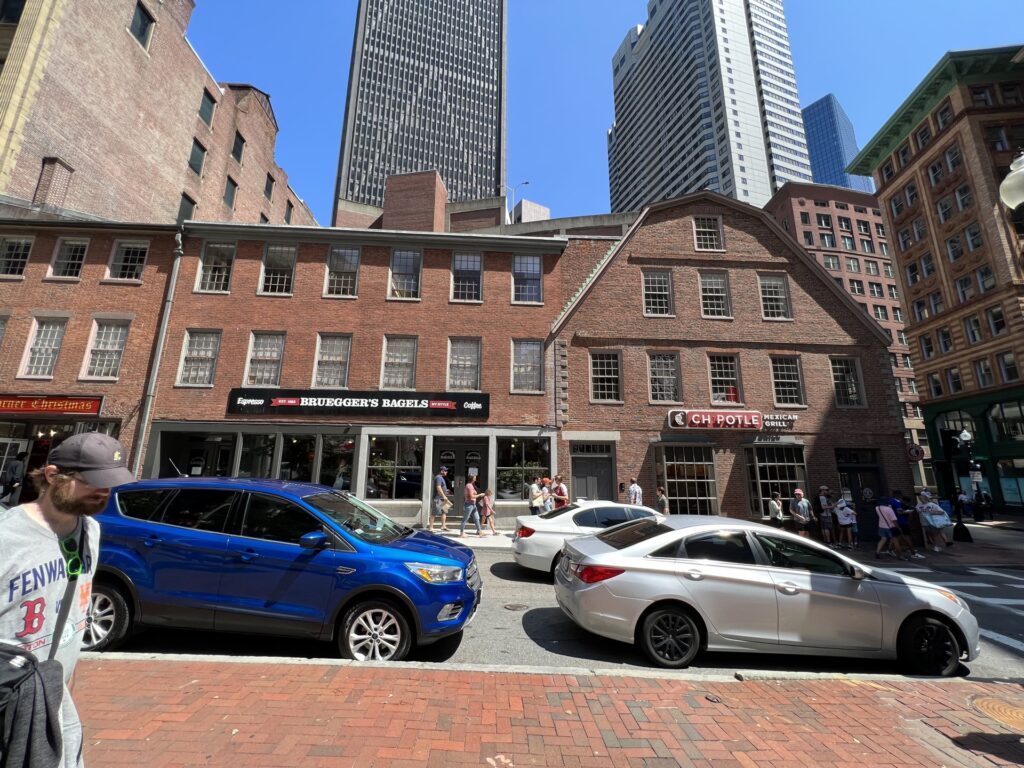
The building that sits on the corner of Washington Street and School Street was built in 1718. When it opened, there was a pharmacy on the first floor and residential space above. The building was then home to a variety of book stores and publishing companies between 1832-1997.
Today, you will not find any books. Today, you will find the world’s worst Chipotle. (I’ve eaten at a lot of Chipotles, and this is in fact the worst.) You can view the historical building from across the street, but this will likely be another quick stop and photo op.
To beef up this stop, you can visit the Old Corner Christmas Store for some souvenir and holiday shopping in the adjacent building. You can also go inside the Chipotle to see some of the historical walls and beams, which is by far the best thing about this Chipotle.
Lunch at Clover Food Lab
- Site type: Restaurant
- Hours: Monday through Saturday 7 AM – 8 PM, Sundays 8 AM – 4 PM
- Tip: Order online when you’re at the Ben Franklin Statue so it’ll be ready when you get there.

After the Old Corner Book Store, it’s a great time to break for lunch. There are a handful of good options for quick-service dining nearby, including Banh Mi Ok, Luke’s Lobster and Clover Food Lab.
We opted for Clover Food Lab, which is a vegetarian restaurant with a rotating seasonal menu. The food was good and interesting, plus the service was quick. They had high chairs and a peanut butter and banana sandwich that our toddler devoured, so that’s always a win.
If you started early and/or are moving quickly, you might not be ready for lunch. The next best lunch option is going to be Faneuil Hall Marketplace, which is probably another hour after this stop.
- Site type: Museum
- What to do there: Go inside the building for a small museum exhibit
- Tickets: There is a combo ticket for the Old South Meeting House and Old State House, which you can buy from the ticket booth at either building. General Admission is $15 and a guided tour is available for $22.
- Hours: Daily, 10 AM – 5 PM. Tours times may vary, but were at 11 AM, 1 PM and 3 PM during our visit.
- How long to stay: 20 minutes
- Tip: There are no drinks allowed inside, but you can leave your drink on a small table near the entrance.

The Old South Meeting House has a long and storied history in Boston. For over a hundred years, particularly during the time of the American Revolution, people met here to debate and discuss laws, community happenings, and religion. Most famously, a group of people met here to discuss taxes on tea by the British. Immediately after, the Boston Tea Party happened.
The Old South Meeting House was converted to a museum in 1877. Inside, you can learn more about the building, its history, and some of the famous meetings that took place here.
I ended up going inside, but my husband and toddler stayed outside to play. It was cool to see the inside of the building, but the interiors are not original. The museum exhibit was interesting and did a good job of providing context and understanding as to why this building was important.
I read all of the exhibits in full, snapped a few photos, used the clean bathroom downstairs, and was out the door in just over 15 minutes. I wouldn’t say it’s a “must-do,” but since there aren’t a lot of museums on the trail, I think it was worth the money.
- Tickets: There is a combo ticket for the Old South Meeting House and Old State House, which you can buy from the ticket booth at either building. General Admission is $15 and a guided tour is available $22.
- Hours: Daily, 10 AM – 5 PM
- Tip: There is a gift shop inside the building that is free to enter without admission.

Built in 1713, the Old State House in Boston is one of the longest standing public buildings in the US. Originally built as a government building, it was an important location throughout the American Revolution. The Declaration of Independence was first read in Boston from the balcony of this building. The building was converted into a museum in the late 1800s.
The Old State House museum has a few different exhibits, including some replica historical rooms, original artifacts, and lots of easy-to-follow information about the history of the building and Boston. During my visit, there was a special exhibit on rebellions throughout history (including up to the 2021 insurrection at the US Capitol), which was really well done.
This museum is broader in size and scope than the Old South Meeting house. I also found it to be more interesting. I’d definitely say this one is worth a visit, and since it’s a combo ticket, you might as well do both.
- What to do there: Take a photo & relfect
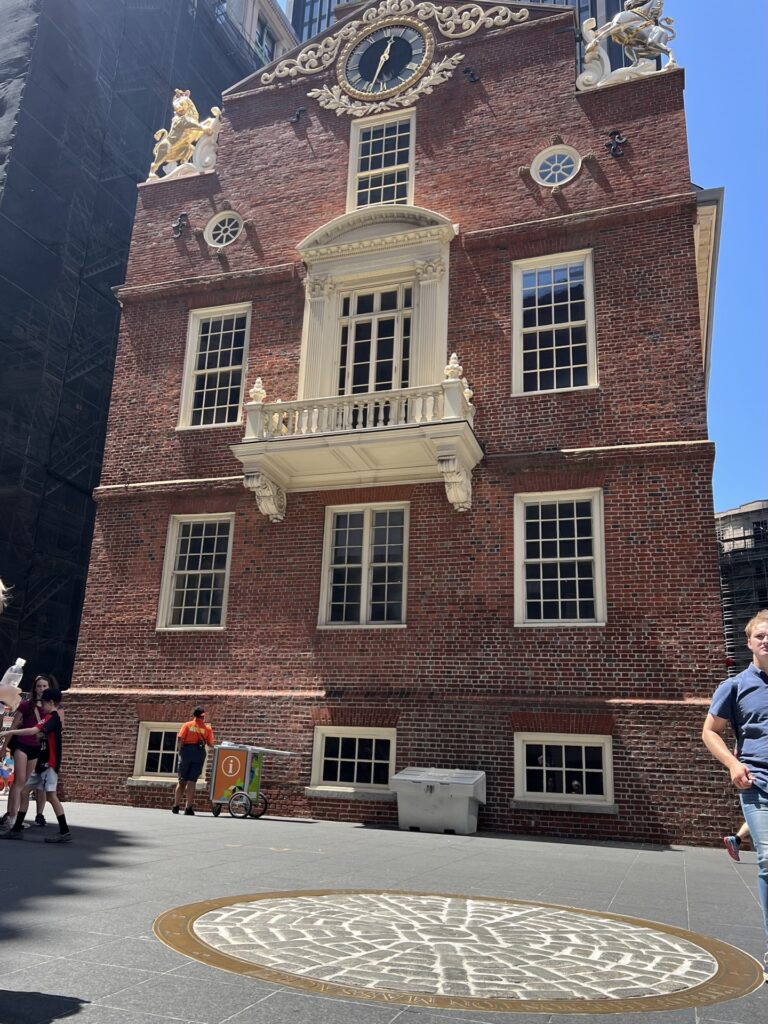
The Boston Massacre took place right outside of the Old State House in 1770. A cobble stone ring now stands on the ground at the site in memorial to the 5 people who died that day.
This is an important and impactful event that doesn’t take up proportional time on the Freedom Trail. With some reflection and a photo, this will likely be a quick stop.
Sam Adams Tap Room
- Site type: Bar / Restaurant
- What to do there: Grab a drink on the rooftop
- Hours: Daily, 11:30 AM – 9/10 PM
- How long to stay: 1 hour
- Tip: They do serve food here, but try to hold off. There are some better food options coming very soon!
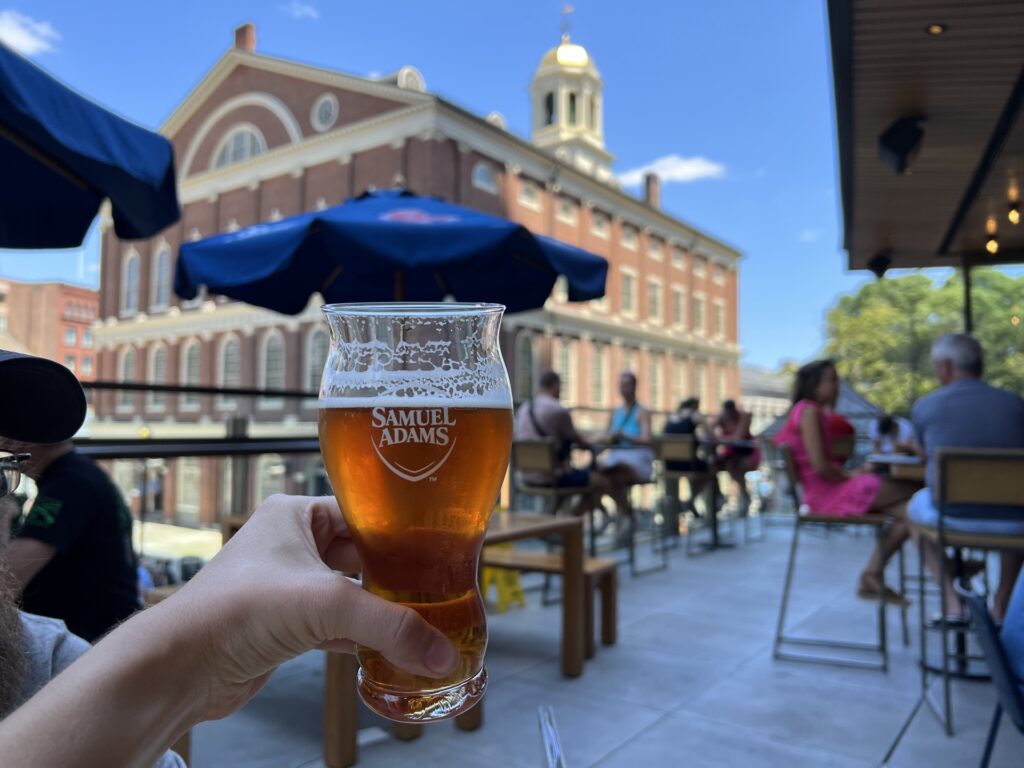
I promised some off-the-trail stops, and were finally starting to get to those on the back half of this itinerary. The Sam Adams Tap Room is a perfect stop for the middle of the Freedom Trail. If you’ve timed things right, you’ll probably get here in the early afternoon. Even on weekends, it’s usually not too busy this early in the day.
For anyone who drinks beer, an ice cold Sam Adams is obligatory on a trip to Boston, and the Sam Adams Tap Room is one of the best places to get one. (They even have a non-alcoholic version on tap!) The tap room in huge, with a few floors of indoor seating and an open-air rooftop that overlooks Faneuil Hall.
The tap room is family friendly during the day, and it’s actually really great for kids. We had a great time enjoying the views and a round of drinks on the rooftop. (My 3-year-old highly recommends the IBC Root Beer.) After 8 PM, you have to be 21+ to enter the tap room.
I do want to note that this the tap room and not the brewery. Sam Adams does have a bewery in Boston with tours, but it’s a bit of a hike from downtown Boston.
- Site type: Building (visitor center, shops & historical meeting hall)
- What to do there: You can visit three different floors inside the hall. The main floor has the National Park Service Visitor Center and shops, the Great Hall is on the second floor, and the bathrooms and tour group meeting points are on the lower level.
- Tickets: Free to enter, no tickets required.
- Hours: Daily, 11 AM – 5 PM (Great Hall closes at 4 PM)
- Tip: Be sure to go upstairs to the Great Hall to learn more about the history of the building and see the historic meeting room.
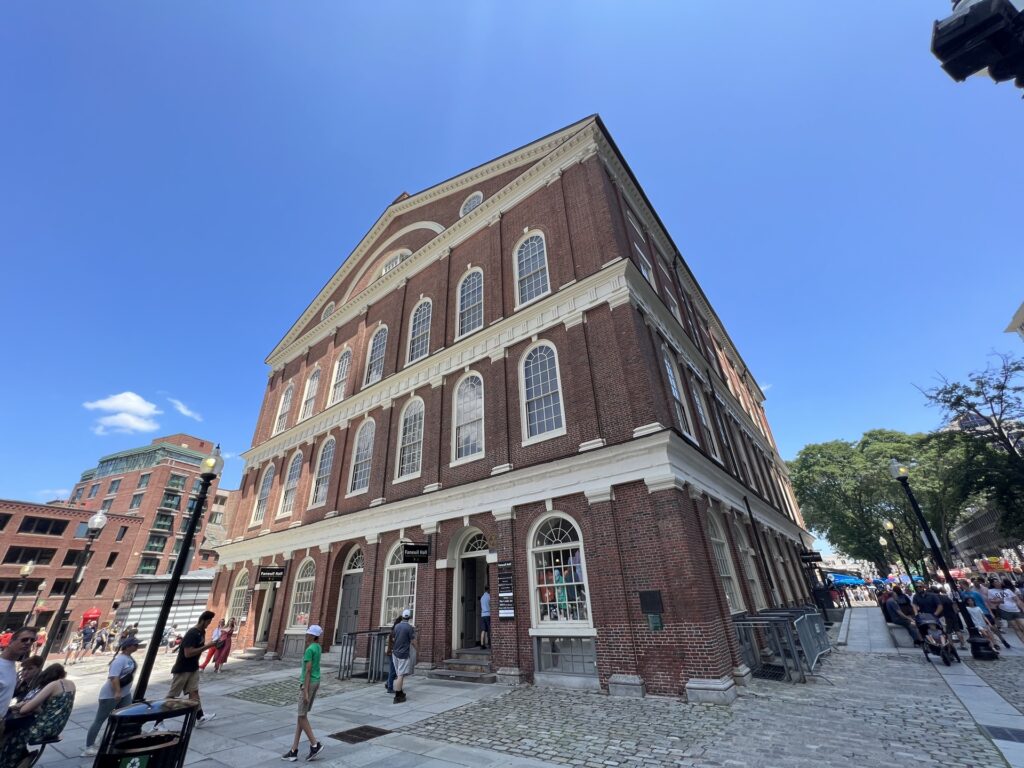
Faneuil Hall has been used as a meeting hall since it was built in 1742. To this day, the hall is still used as a meeting place for city events like graduations and swearing in new citizens.
If you didn’t know better, you could almost completely write off Faneuil Hall as a store. Immediately when you walk inside, you’ll find a variety of souvenir shops selling overpriced clothing and designer candy. (Which yeah, we bought, it’s fine.) But there’s more!
Go up to the second floor to see the Great Hall. It was renovated in 1806, and that’s pretty much the same interior that you’ll see inside today. It’s easy to miss this upper floor (we did!), but if you want to get a feel for the historical significance of the place you’ll want to check it out.
There’s also a National Park Service information booth on the main floor. The Rangers here can give you information about the Freedom Trail sites and answer just about any question you might have.
We cooled off in the AC for bit, visited the clean bathrooms in the basement, and got a candy necklace for the road. I picked up a onesie for my friend, but the sweatshirt I wanted was a bit too expensive to justify. Overall, a good easy stop.
Faneuil Hall Marketplace / Quincy Market
- Site type: Food Hall & Market
- What to do there: Eat, shop, street entertainment
- Hours: Monday – Thursday, 10 AM – 7 PM / Friday & Saturday, 10 AM – 9 PM / Sunday, 11 AM – 6 PM
- Tip: If you plan to eat lunch here, be sure to get there early or just accept that lines will be long.
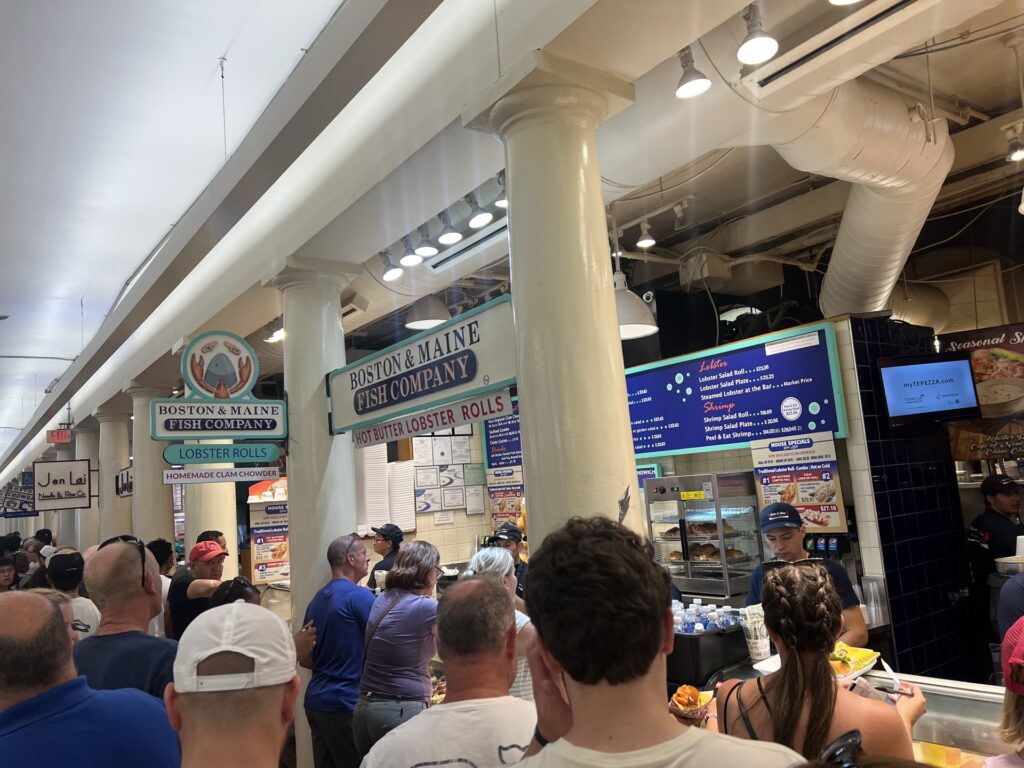
According to most accounts, Faneuil Hall Marketplace and Quincy Marketplace are two names for the same thing. If anything, it seems likes Quincy Market specifically refers to the food hall portion, while Faneuil Hall Marketplace includes the broader shopping and entertainment space. Everyone can agree that this area is different than “Faneuil Hall” which specifically refers to the historical meeting place next door.
Let’s start with the food hall. It’s a densely packed market that is filled with restaurants of all varieties. You can get Boston classics like lobstah rolls and clam chowda, but also sushi, hot dogs, desserts galore, and tons more. The food hall gets “wicked” crowded though, so expect to wait if you want to eat there during peak mealtimes. There’s space to eat inside and outside.
If you’re not eating, take a walk around the outside of the market. Here you’ll find street performers, food carts, and shops to pop in and out of. Even without eating, it’s still good for about 30 minutes of fun.
Optional Stopping Point
We’d suggest seeing a few more things on the Freedom Trail, but this is a perfectly fine ending point, too. You could easily spend the rest of your afternoon enjoying the marketplace. You’d have your pick of bars and restaurants to keep you busy well into the evening.
Another thing to add on here is Christopher Columbus Waterfront Park, which is right across the street. It’s a lovely park with a carousel and playground for kids. You can also pop over to Long Warf to see the waterfront, and maybe even continue with a walk along the Haborwalk .
- What to do there: You can go inside the home, which has been converted to a small museum
- Tickets: Tickets are $6 and can be purchased at the entrance.
- Hours: Exact hours vary by season, but typically the house is open daily from 10 AM – 4:15/5:15 PM. During the winter (Jan, Feb, Mar), the house is closed on Mondays. Confirm current hours here .
- How long to stay: 30 minutes (plus time in line during busy periods)
- Tip: They only accept credit cards on charges over $10. If you’re visiting solo, be sure to bring cash for your $6 entry ticket.

Paul Revere is a revolutionary hero who is most famous for his night ride to alert the colonists that the British were coming. His house still stands — the oldest structure in downtown Boston — and has been converted to a museum.
Inside Paul Revere’s home, you can learn about Paul Revere and the house’s history. Specifically you’ll see how the houses was preserved through different eras. Most people really enjoy this museum.
We personally didn’t make it inside the Paul Revere House. By the time we got there around 2 PM, the line was out the door. It was hot and sunny, and we couldn’t wait with our no-nap toddler. This is definitely something to note if you’re interested in going inside the house.
Mike’s Pastry
- Site type: Bakery
- What to do there: Pick up some baked goods for takeaway
- Hours: 8 AM – 10 PM
- How long to stay: Up to 30 minutes
- Tip: Bring cash! They don’t accept credit cards.
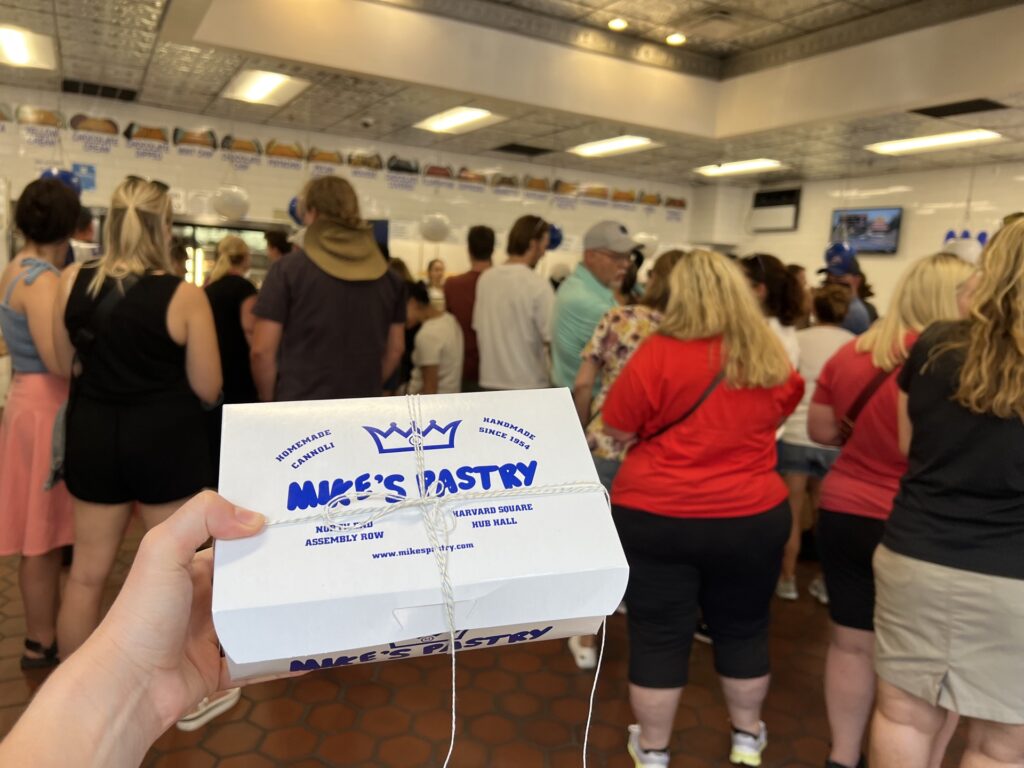
A visit to the Paul Revere House brings you Boston’s famous North End. This Italian neighborhood is dense with some of the best restaurants and bakeries in the city. The most famous of which, is (probably) Mike’s Pastry. You can tell because the line is almost always out the door.
Mike’s Pastry has been a neighborhood institution since the 1940s. It’s famous for its cannoli, which they serve up in 19 different flavors! They also have a full pastry case full of goodies which makes it impossible to decide. I liked the cannoli (I opted for the pistachio variety), but I loved the Boston Creme cake. There’s no seating in the store, so you’ll have to eat your goodies along the window bar or take them with you.
For every person who tells you that you must go to Mike’s Pastry, there will be someone else who tells you it’s “overrated.” I went to Mike’s Pastry and loved it, and I can assure you that the line goes quickly. However, I do believe that several other bakeries in the area are just as good. Bova’s Bakery and Modern Pastry are two other bakeries that get recommended a lot.
I honestly don’t care which bakery you go to, but I’m pretty sure it’s illegal to come to the North End and not try at least one.
Paul Revere Statue
- Site type: Statue & Park
- What to do there: Sit and relax or just pass through
- Tip: Eat your cannoli here.
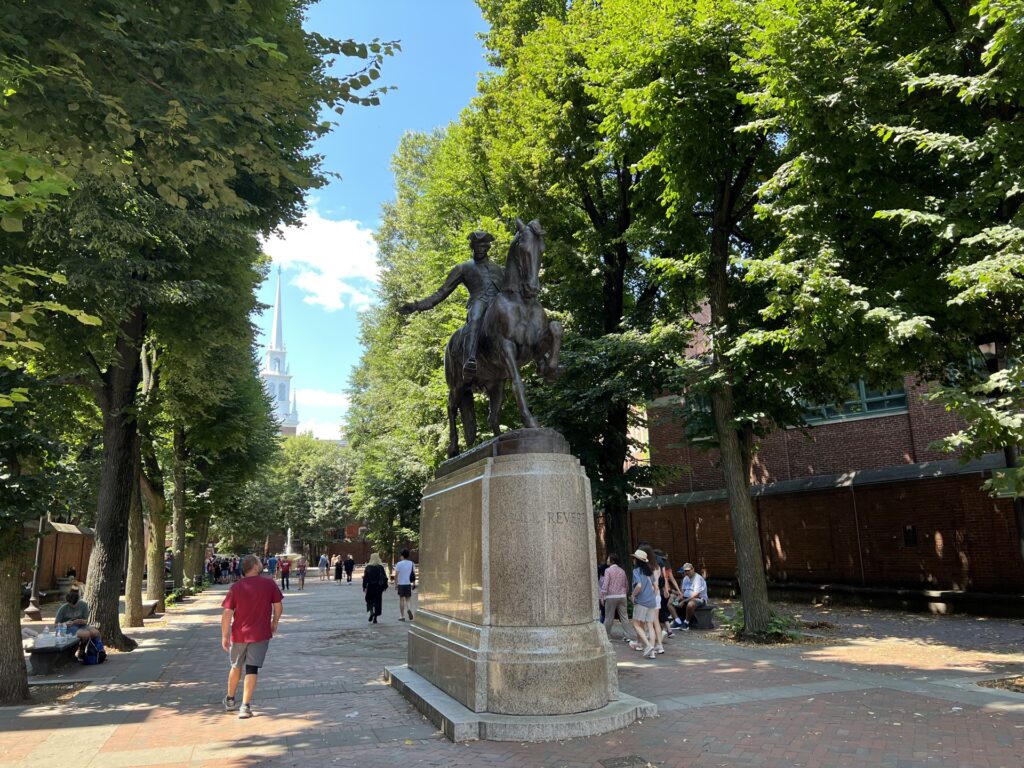
The park area around the Paul Revere Statue should be called the Unofficial Dining Room of Mike’s Pastry. The bakery doesn’t have any seating, so plenty of people take their cannoli to eat in the park nearby. There are benches and it’s mostly shaded.
Even without any cake to eat, it’s still worth stopping by this statue. It’s a cool statue of Paul Revere on a horse with Old North Church in the background.
- What to do there: Go inside the church
- Tickets: General Admission, $5 / GA + Audio Guide, $8 / Guided Tour, $10
- Hours: Exact hours vary by season. Typically, the church is open Monday through Saturday, 10 AM – 5 PM and Sunday 11:30 AM – 5 PM.
- Bathrooms: Yes (near the ticket booth, not inside the church)
- Tip: Do the scavenger hunt, even if you aren’t visiting with kids.
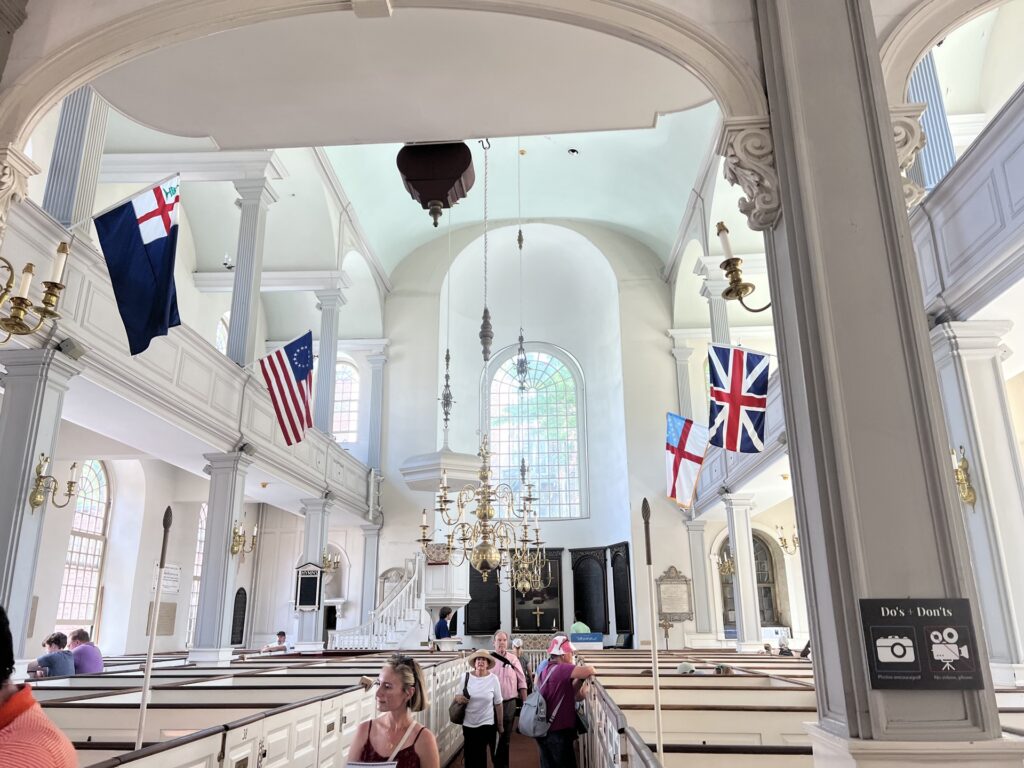
Old North Church is famous for marking the start of Paul Revere’s ride. Two lanterns were hung in the church’s steeple, which alerted Paul Revere that the British troops were approaching. He then rode to Lexington to alert colonial troops.
The church was built in 1723, making it the oldest standing church in Boston. It’s still an active church today, where they hold service every Sunday. (You can also get married there, which looks delightful!)
Entry to the church requires a ticket, which you can purchase from a ticket booth nearby. When you buy your ticket, be sure to ask for the scavenger hunt. (There’s no extra charge for it.) It’s great for kids, but it’s available to anyone.
The scavenger hunt guides you through the church and gives you some interesting facts along the way. Basically, you look for little paw prints on the pews, which will give you the answer to each question. At the end you get a small prize. (Spoiler alert: it’s a sticker.)
Old North Church was one of my favorite stops on the Freedom Trail. It’s a lovely church and the scavenger hunt made it really fun for my 3-year-old. I wouldn’t say it’s a “must-do,” but I definitely think it was worth the $5.
Wrapping Up the Freedom Trail
After Old North Church, there are three final stops on the Freedom Trail. That doesn’t sound like much, but these three sites require an extra 1.5 miles of walking. It’s not just a long walk between the sites, it’s a long, boring and sunny walk (read: unbearably hot in the summer). There was construction on the bridge during our visit, so the walk was even worse. Like many other others, I will make a case to skip these sites or do them on a different day.

The next site on the trail is Copp’s Hill Burying Ground. This is also in the North End and it’s not too far from Old North Church, so if you wanted to tack this one on before calling it a day, you could. However, there are no particularly famous graves in the burying ground. I mean no disrespect to the people buried there, but from a tourist perspective it is not particularly compelling.
Instead, I’d wrap your day with dinner and drinks in the North End. Most of the restaurants can be found along Hanover Street and Salem Street. We didn’t personally dine in this area, so we’ll refer you to this North End food guide . (Instead, we ended up ordering room service at our hotel because we were tapped.)

How to see the Final Freedom Trail Sites
The last two sites are the USS Constitution and Bunker Hill. These two sites are great, they just don’t belong on the same Freedom Trail one-day itinerary. Here’s why.
The USS Constitution and the whole Naval Yard is really cool! There’s a great (air conditioned) visitor center with a gift shop and a few exhibits. Then you can board the Colonial era USS Constitution and the more modern USS Cassin Young. There’s also a ticketed museum you can visit to learn even more.
Unfortunately, by the time you get here after a full day on the Freedom Trail, you’re bound to be exhausted and won’t be able to appreciate or enjoy it.
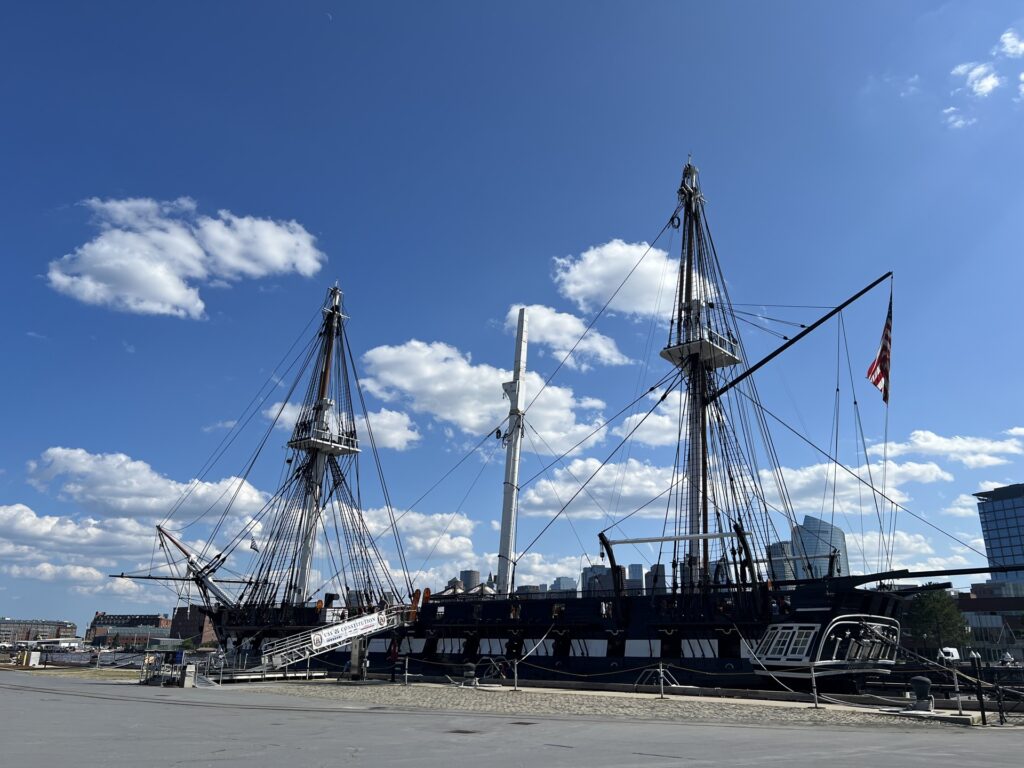
Then there’s the Bunker Hill monument. This is a fine monument, but it’s not something you need to walk 1.5 miles just to look at . It is worth walking to, though, if you want to go up to the top of the monument. However, entry to the top closes at 4:30 PM, and it’s pretty hard to get there by then after a full day on the trail.
If you want to see these last few sites on the Freedom Trail, I’d suggest doing them on a different day and in reverse order. Start at Bunker Hill when it opens at 10 AM. (Note: It’s closed Mondays and Tuesdays.) Then walk to the Naval Yard for the USS Constitution. These two things could easily keep you busy well into the afternoon. You could then end your day by walking over to the North End for dinner.

1-Day Freedom Trail Itinerary at a Glance
- Coffee & Breakfast at Taste Bakery & Cafe (Prices vary / 45 minutes)
- Boston Common (Free / 30 minutes)
- Massachusetts State House (Free / 1 hour if going inside, 10 minutes if not / Inside closed on weekends)
- Park Street Church (Free / 15 minutes / Only open Sundays)
- The Granary Burying Ground (Free / 15 minutes)
- King’s Chapel (Free to $10 / 15 minutes to 1 hour if you’re going inside, 5 minutes if not / Check seasonal hours)
- Boston Latin School Site & Ben Franklin Statue (Free / 5 minutes)
- Old Corner Book Store (Free / 5 minutes)
- Lunch at Clover Food Lab (30 minutes)
- Old South Meeting House ($15 Combo ticket / 20 minutes)
- Old State House ($15 Combo ticket / 20 minutes)
- Boston Massacre Site (Free / 5 minutes)
- Sam Adams Tap Room (1 hour)
- Faneuil Hall (Free / 30 minutes)
- Faneuil Hall Marketplace (30 minutes)
- Paul Revere House ($6 / 30 minutes / Closed winter Mondays)
- Mike’s Pastry (30 minutes)
- Paul Revere Statue (Free / 15 minutes)
- Old North Church ($5-$8 / 20 minutes)

Looking for more things to do in Boston?
Be sure to check out our Boston Weekend Itinerary and First Timer’s Guide to Fenway Park !

The Freedom Trail: Your Guide to Historical Boston
No visit to boston is complete without a visit to the freedom trail. experience boston's history by foot, and get to know why it's often called "the cradle of the american revolution.".
Boston’s Freedom Trail is truly one-of-a-kind. Comprised of churches, museums, meeting houses, cemeteries, the USS Constitution, monuments, and more , the Trail walks you through the history of the American Revolution and beyond in Boston, and is an absolute must-see when you’re in the area.
While you can take a tour, and there are many available, you really don’t need to. It’s very easy and straightforward to do the trail self-guided, and there are a variety of apps and resources available for extra information.
But never fear, we have all the information you need right in this post!
Basic Info:
Table of Contents
In total, the Freedom Trail is about 2.5 miles in length, and you should absolutely plan to do the whole thing. We’d recommend that you budget a half-day or more to truly make the most of your experience. While the Freedom Trail can be completed end-to-end in about 2 hours, you will surely want to enter some of the attractions, or perhaps pause to learn more, get a bite to eat, or detour for a bit.
The Freedom Trail is great for all ages and activity levels, and is largely flat and paved. It’s also almost impossible to get lost– just follow the brick path (usually 2 bricks wide in the middle of the sidewalk) to stay on the trail. The Trail ends in Charlestown , at the Bunker Hill Monument and USS Constitution, and you can either meander your way back downtown by foot or hop on a bus or ride-share to get to wherever you’d like to visit next.
See below for a step-by-step guide to the Freedom Trail’s 16 stops, as well as our additional bonus stops for treats, photo ops, and more! Enjoy!
Stop 1: the boston common.
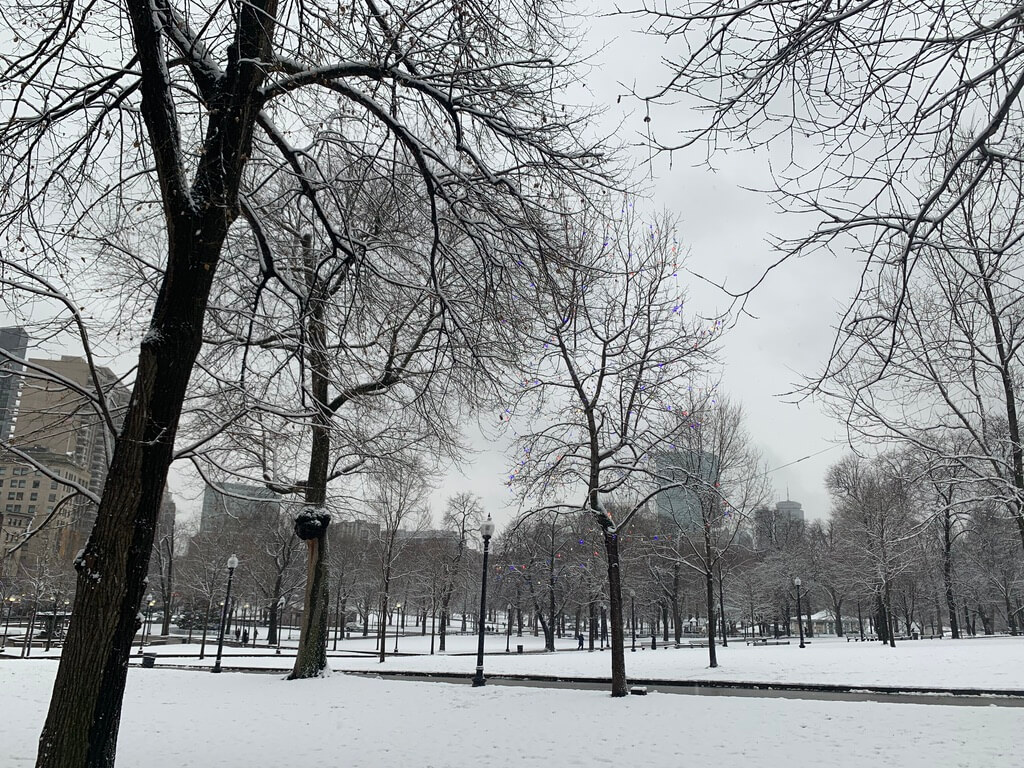
The Boston Common is the oldest city park in the U.S., dating all the way back to 1634! Originally used as a cow pasture, it has also been used as a public gallows, an encampment for British soldiers during the American Revolution, and a communal gathering space. Today, its 50 acres are a serene and relaxing place to spend some time picnicking or strolling around. Crossing Charles Street, the Common becomes the Public Garden, with beautiful seasonal landscaping, Swan Boat tours, the adorable “Make Way for Ducklings” statue, and relaxing pathways to explore before or after beginning the Freedom Trail. The Common is now a National Historic Landmark and is arguably Boston’s greatest treasure.
Stop 2: The Massachusetts State House
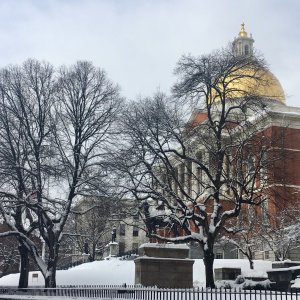
Serving as the state capitol and seat of government for the Commonwealth of Massachusetts, the Massachusetts State House is hard to miss with its sparkly gold dome. Also a National Historic Landmark, the State House replaced its smaller predecessor (seen later on the Trail) in 1798. The Secretary of the Commonwealth’s office holds free tours (available daily) of the beautiful interior, which is well-worth a visit. See here for details and to book.
Add-On: The Black Heritage Trail
We strongly recommend taking the time to explore the Black Heritage Trail prior to continuing on your Freedom Trail journey. The path stops at several sites important to Black history in the Beacon Hill neighborhood of Boston.
Must-see sites include: the 1806 African Meeting House (the oldest Black church in the country); the Abiel Smith School, now the Museum of African American History; and the Lewis and Harriet Hayden House, a stop on the Underground Railroad.
Despite the fact that it was the first state in the U.S. to ban slavery in 1783, Massachusetts, and Boston in particular, continue to struggle with a past and present of entrenched and systemic racism and injustice. In the years after slavery was outlawed, a large community of former slaves settled in the Beacon Hill area, creating meeting houses, schools, and other institutions. The Black Heritage Trail tells their stories.
Here are the stops on the trail:
- Stop 1: Monument to the Massachusetts 54th Regiment Located across the street from the State House (see Stop 2 on the Freedom Trail above), there is a monument depicting the Black soldiers who fought for the Union, the subject of the film Glory , as they marched down Beacon Street after the end of the war.
- Stop 2: Abiel Smith School, 46 Joy Street Now home to the Museum of African American History — really worth a visit.
- Stop 3: African Meeting House, 8 Smith Court Known colloquially as “Black Faneuil Hall,” this is the oldest Black church in the country, and the site of many speeches by Frederick Douglass and other abolitionists.
- Stop 4: Charles Street Meeting House, 70 Charles Street Historic church built in the 1800s.
- Stop 5: John Coburn House , 2 Phillips Street Home of abolitionist John P. Coburn in the early 1800s, still a private residence today.
- Stop 6: Lewis and Harriet Hayden House , 66 Phillips Street A famed stop on the Underground Railroad, the Hayden house was home to Lewis and Harriet, who escaped slavery in Kentucky and came to Boston. Fun fact: Harriet Beecher Stowe interviewed them when researching for her book Uncle Tom’s Cabin .
- Stop 7: George Middleton House , 5 Pinckney Street Middleton served as the commander of one of two all-Black units in the American Revolution, and was also an accomplished violinist and founder of the African Benevolent Society.
- Stop 8: Phillips School , corner of Pinckney & Anderson Street Originally opened as a school for white children only, the Phillips School became one of the first integrated schools in the state when Massachusetts integrated schools in 1855.
- Stop 9: Smith Court Residences, 5, 7, 7A, 4 and 2 Smith Court Despite being private homes and not open for touring, the homes exemplify those built by Black residents in the early 1800s.
- Stop 10: John Smith House , 86 Pinckney Street Home of abolitionist and 3-term state representative John J. Smith.
Stop 3: Park Street Church
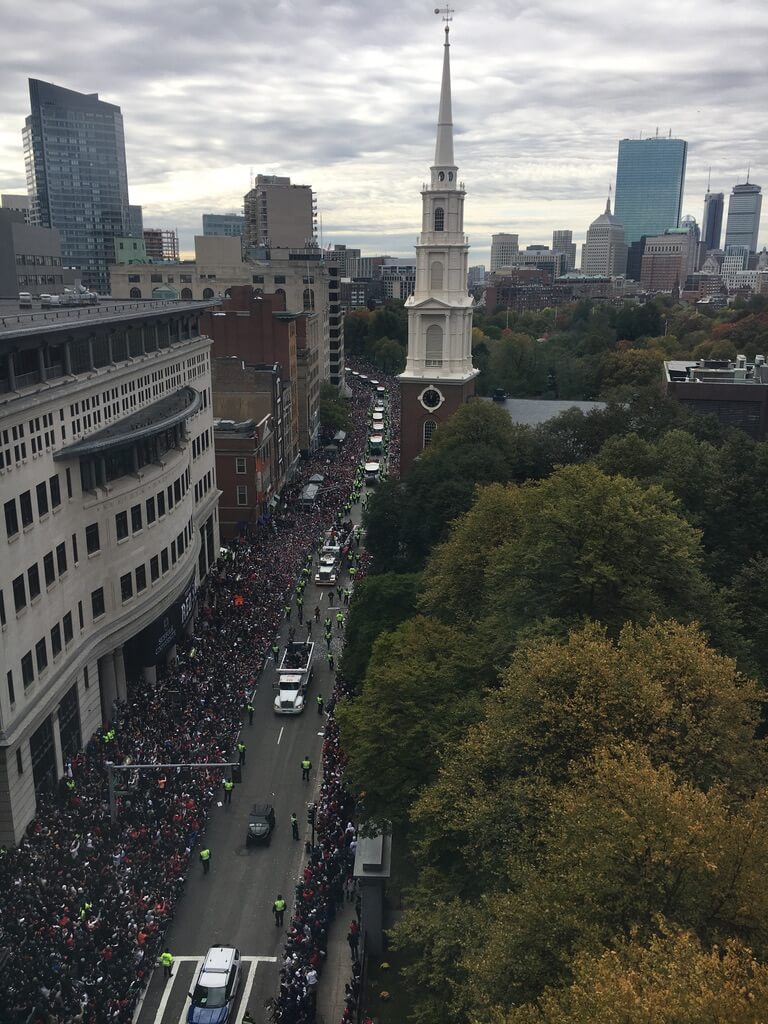
Note: photo was taken during Red Sox victory parade, 2019 World Series. Crowds line the sidewalks, and the semis in the middle have the victorious team aboard!
Stop 4: Granary Burying Ground
Attached to Park Street Church, the Granary Burying Ground was first founded in 1660 (making it Boston’s 3rd-oldest cemetery), is the final resting place for many of the U.S.’s earliest patriots, including Paul Revere , Samuel Adams, John Hancock, and Robert Treat Paine, as well as those killed in the Boston Massacre .
Stop 5: King's Chapel + Burying Ground
Continuing along Tremont Street, you will see the King’s Chapel and attached Burying Ground on the right side of the road, about 2 blocks from the Granary Burying Ground. Note that, despite being attached, the Burying Ground is not affiliated with the Chapel and never has been– it’s over 100 years older than the chapel, which was completed in 1754.
Stop 6: Benjamin Franklin Statue + Original Site of Boston Latin School
The Boston Latin School was established in 1635 at this spot, making it the oldest school in the country. It is now located in the Fenway area of Boston. Notable early alumni include a whopping 5 signers of the Declaration of Independence: Benjamin Franklin (who has a statue nearby despite dropping out!); Samuel Adams; John Hancock; Robert Treat Paine; and William Hooper.
Stop 7: Old Corner Bookstore + Irish Famine Memorial
On the corner of Washington and School Street, there is a cute bookstore dating back to 1718. Across the street, be sure to check out the Irish Famine Memorial , opened in 1998 in memory of those who died during the Great Famine of the 1840s and 1850s.
Bonus: Downtown Crossing
The next few stops on the trail are in the area of downtown known as “Downtown Crossing.” Predominantly a walking street, there is lots of shopping, fast casual, and other options in this area if you’re wanting to take a quick break.
Stop 8: Old South Meeting House
The Old South Meeting House is not only historic, dating back to 1729, but also infamous– as the organizing site for the Boston Tea Party in 1773. The Meeting House was the largest building at the time, and served as the organizing locale for the later raid of 3 British tea ships. This association with the Revolution led it to be occupied by the British from 1775 until their evacuation from Boston on March 17, 1776, today still celebrated as a local holiday in Boston and Suffolk County.
Stop 9: Old State House
At the intersection of Washington and State Street, you will see the Old State House , dating back to 1713. It’s considered one of the oldest buildings in the country, and served as the seat of government until moving to the current State House in 1798 (see Stop 2 above!) There is a museum inside that you can check out if you’re interested.
Stop 10: Site of Boston Massacre
Directly in front of the Old State House, there is a large circular plaque denoting the site of the March 5, 1770 Boston Massacre , where a skirmish between colonists and British soldiers turned deadly. Often considered a major catalyst for the American Revolution, which erupted a few years later, news of the altercation spread like wildfire among the 13 colonies.
Stop 11: Faneuil Hall
Faneuil Hall is a historic marketplace comprising Quincy Market, North Market, and South Market. Originally built in 1740, today it is a popular tourist destination, and you’ll definitely want to spend some time exploring here. If you’d like to sample lobster rolls or clam chowder, this is a pretty good place to do so. We recommend hot lobster rolls over cold, with lots of melted butter drizzled on top, and definitely get the bread bowl with your clam chowder! Peter Faneuil, who built the market at his own expense in 1740, was a slave merchant by trade, and in recent years public outcry has led to a movement to change the name of the Hall.
Stop 12: Paul Revere House
Continuing along the trail (following those bricks!) to the North End, Boston’s “Little Italy,” the next destination is the Paul Revere House . Built in 1680 or thereabouts, it was Paul Revere’s home during the Revolution years and today is a museum (admission is charged upon entry.)
Stop 13: Old North Church
Our favorite history stop on the Freedom Trail, the Old North Church is said to be the site where Paul Revere hung his “one if by land, two if by sea” lantern signal, preceding his infamous “Midnight Ride” and the Battles of Lexington and Concord, which kicked off the American Revolution. The plaza area nearby was renovated very recently, and there’s a majestic statue of Paul Revere on his horse, as well as some period shops to peek into (like a chocolate shop and a type-setter shop.)
Bonus: North End
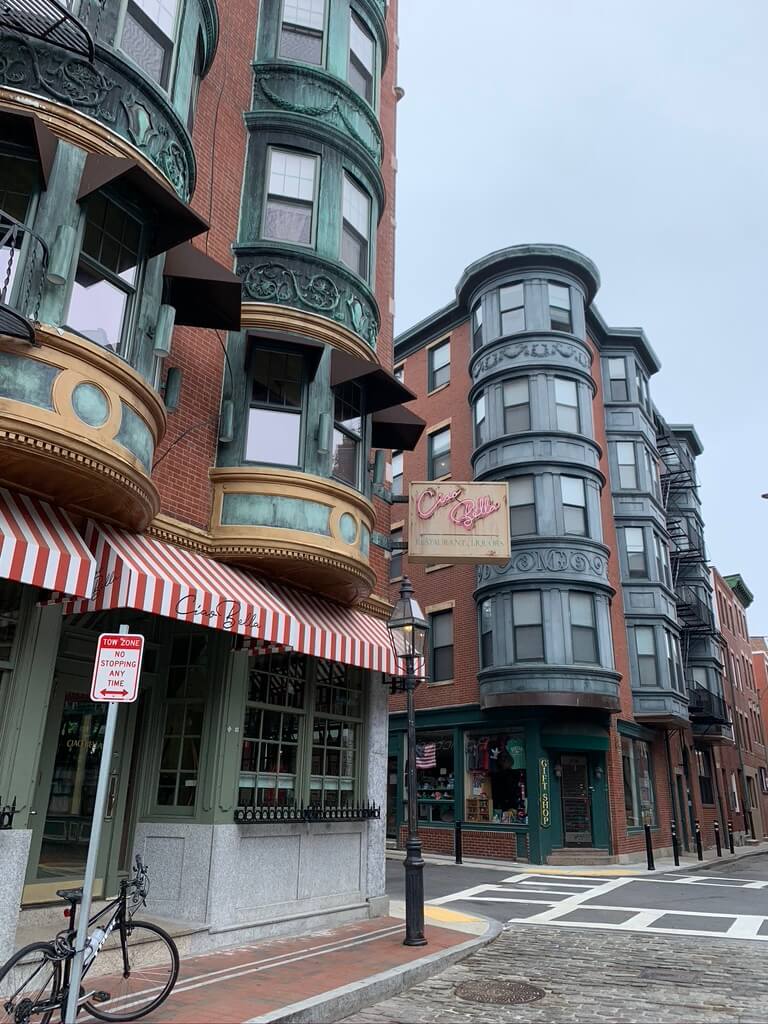
The North End contains some of Boston’s oldest surviving architecture, as well as to-die-for Italian fare, from pizza (we recommend Regina’s ) to lasagna (we recommend the lunch lasagna at Antico Forno ) to home-made pasta (we recommend the squid ink pasta at Monica’s or Giacomo’s legendary pasta, if you’re willing to wait in line.) Of course, no trip to the North End is complete without staking your claim in the epic cannoli rivalry of Mike’s Pastry versus Modern Pastry . We are a house divided on this one– Tegan prefers Modern, Alex prefers Mike’s. Which will you choose? For more information on the North End, check out our Definitive North End guide here !
Note: right nearby is the TD Garden, one of Boston’s premiere sports arenas. For everything you need to know about TD Garden (seeing a game, getting tickets, etc.) check out Itinerant Fan’s TD Garden guide .
Stop 14: Copp's Hill Burying Ground
The city’s 2nd-oldest burial ground and 3rd cemetery on the trail, the Copp’s Hill Burial Ground, built in 1659, is further along the Trail past the North End.
Stop 15: The USS Constitution
If you continue across the bridge into Charlestown (a neat experience in and of itself!), you can’t miss the USS Constitution , also known as Old Ironsides . Originally launched in 1797, the USS Constitution gained fame and popularity during the War of 1812, when she defeated 5 British warships single handedly. Today, Old Ironsides is still a fully commissioned Navy ship, and sailed under her own power as recently as 2012. The museum is free (they ask for donations), and you can pay for tickets to go on board separately.
Stop 16: The Bunker Hill Monument
Your tour culminates at the Bunker Hill Monument , erected in 1825 to commemorate the American Revolution’s Battle of Bunker Hill, fought June 17, 1775. You can trek up to the top (up a very narrow and very steep staircase!) or explore the area around it.
From here, definitely spend some time exploring Charlestown, a very historic part of Boston, and also where most of Ben Affleck’s The Town takes place. You can walk back to downtown or your next destination from here, or take a bus or ride-share.
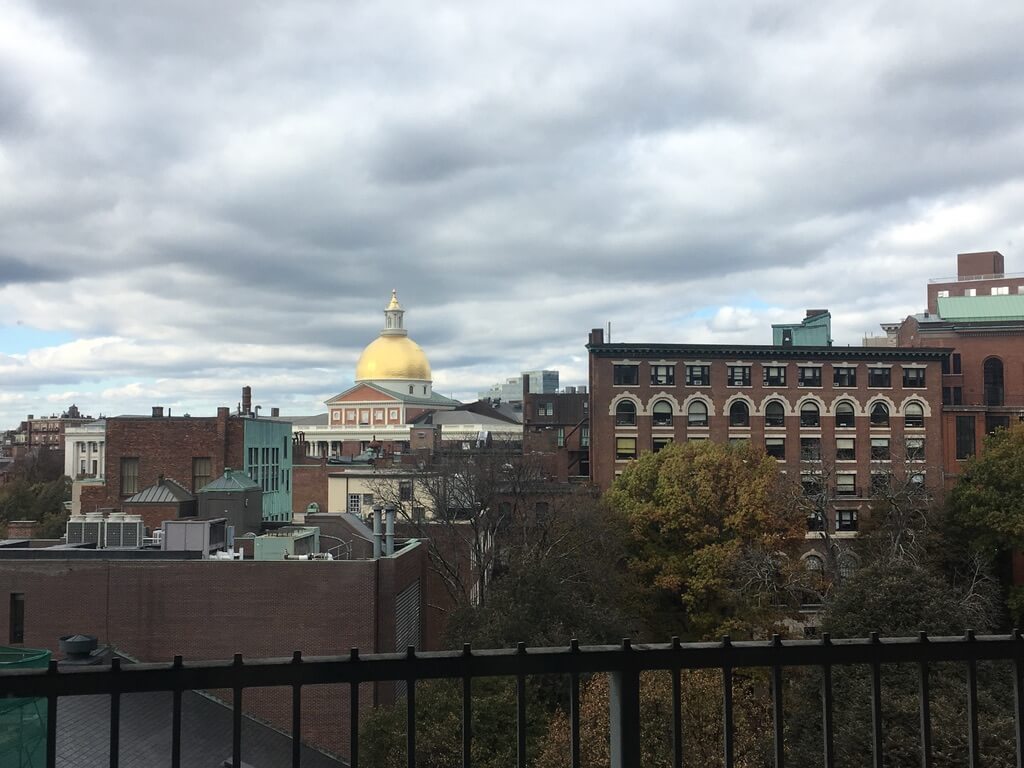
For more Boston content, from a 101 guide to your first visit to Boston brews , food , biking , day trips, and more, check out our Boston landing page here .
Boston Food Guide: From Lobster to Cannoli
Boston breweries + bars, you may also like, a car-free cotwolds weekend, a tolkien themed oxford weekend, the best puglia road trip, a weekend in matera, day trips from valletta, a weekend in valletta, how to spend an amazing week in malta, a long weekend in cape town, a weekend in porto, 2 day trips from madrid.
So interesting! Great way to learn history!
Such a great overview of the freedom trail! It really is the best way to see the best sites in Beantown! Have done it a couple times and it never gets old.
We look forward so much to doing it whenever we have visitors, and even sometimes just us 🙂 Haha!
Thanks for this detailed account of Boston which is one of my favorite places to visit and explore. Can’t wait to go back again.
So glad you liked it! Hope you’re able to come back soon.
Great photos! I love Boston.
Comments are closed.
This website uses cookies to improve your experience. Check out our privacy policy for more information. Accept Read More

Must-Stops On The Freedom Trail In Boston, MA

19 Apr Must-Stops On The Freedom Trail In Boston, MA
Boston, Massachusetts is not just a beautiful coastal city, but a city steeped in American history. The 2.5 mile red-brick tour of the Freedom Trail follows along the streets of Boston and is packed with historical landmarks, sites, and burial grounds of famous Revolutionary War Patriots.
There are seventeen major landmarks on the Freedom Trail that can take an entire day to traverse by foot depending upon your speed and the size of your group. If you have the day to enjoy Boston and stop along the way to enjoy lunch, we recommend doing it. If not, here are several must-stops if you want to hit the major landmarks but have the full day to spend in beautiful Boston.
Before you visit the Freedom Trail, download the official brochure . If you plan to spend the day meandering the streets of Boston to see all the attractions this brochure and our team at Wolfe Tours can help you organize your day.

Boston Common
Located in the heart of Boston, this is a great starting point for your day of touring. At nearly 50 acres, Boston Common is one of the nation’s oldest existing public parks.
It was once used as pasture land by the Puritans and a place to muster the militia during the Revolutionary War. It’s now used by joggers, walkers, and Bostonians looking to enjoy the greenery and even a Frog Pond as a skating rink during the winter months.
While you are enjoying the Boston Common, don’t forget to walk by the MassachusettsState House with its golden dome. The state government has served from this building since it opened in 1798.
Old South Meeting House
The Old South Meeting House , built in 1729 as a church, also hosted town meetings during this era. Here, in 1773, more than 5,000 men crowded together to debate the controversial tax on tea. What happened in the days following are described at the Boston Tea Party, when Patriots dumped hundreds of chests of tea in Boston Harbor as a protest against the British tax on colonial tea.
The Old State House & Site of the Boston Massacre
Nearby the Old South Meeting House is the Old State House, a center of political meetings during the weeks and months leading up to the American Revolution. The Declaration of Independence was first read publicly on the balcony of this historical site.
On the street right in front of the Old State House sits a maker denoting the location of the Boston Massacre. On this site on March 5, 1770, the tensions between the British and colonists boiled over and resulted in the first bloodshed of the war. During an uprising in the streets, the Redcoats fired on the colonists, killing five and setting into motion the eventual declaration of war. A medallion on the road commemorates the lives lost on this day.
Old North Church
If you are a fan of the spy networks that were at work during the American Revolution, you will want to stop by the Old North Church where the famous “One if By Land, Two if by Sea” secret signal was displayed on the night of April 18, 1775, indicating the way that the British would start their movement toward Lexington and Concord to hunt out the militia and leaders of the Sons of Liberty.
Faneuil Hall
At this point in your walking tour you may need a moment to refresh and have a snack. The shops at Faneuil Hall are a great resting spot where you can enjoy this lively outdoor venue.
Grab a bite to eat, rest a bit, and experience what is called the “Cradle of Liberty” where colonists gathered to discuss the incidents of the day and held protests against British colonial rule.

U.S.S. Constitution
No walk along the Freedom Trail would be complete without visiting the Charlestown Naval Yard where Old Ironsides or The U.S.S. Constitution sits in retirement. The naval frigate launched in Boston in 1797, served valiantly in the War of 1812, and was retired from service in 1881. It now serves as an educational visitor site and museum.
Want to plan your next trip to Boston with Wolfe Tours? We will handle all the planning and take into consideration the needs of your group when planning your historical trip.

My Bookings
Please Enter Your Booking Code To Find Your Booked Tour!
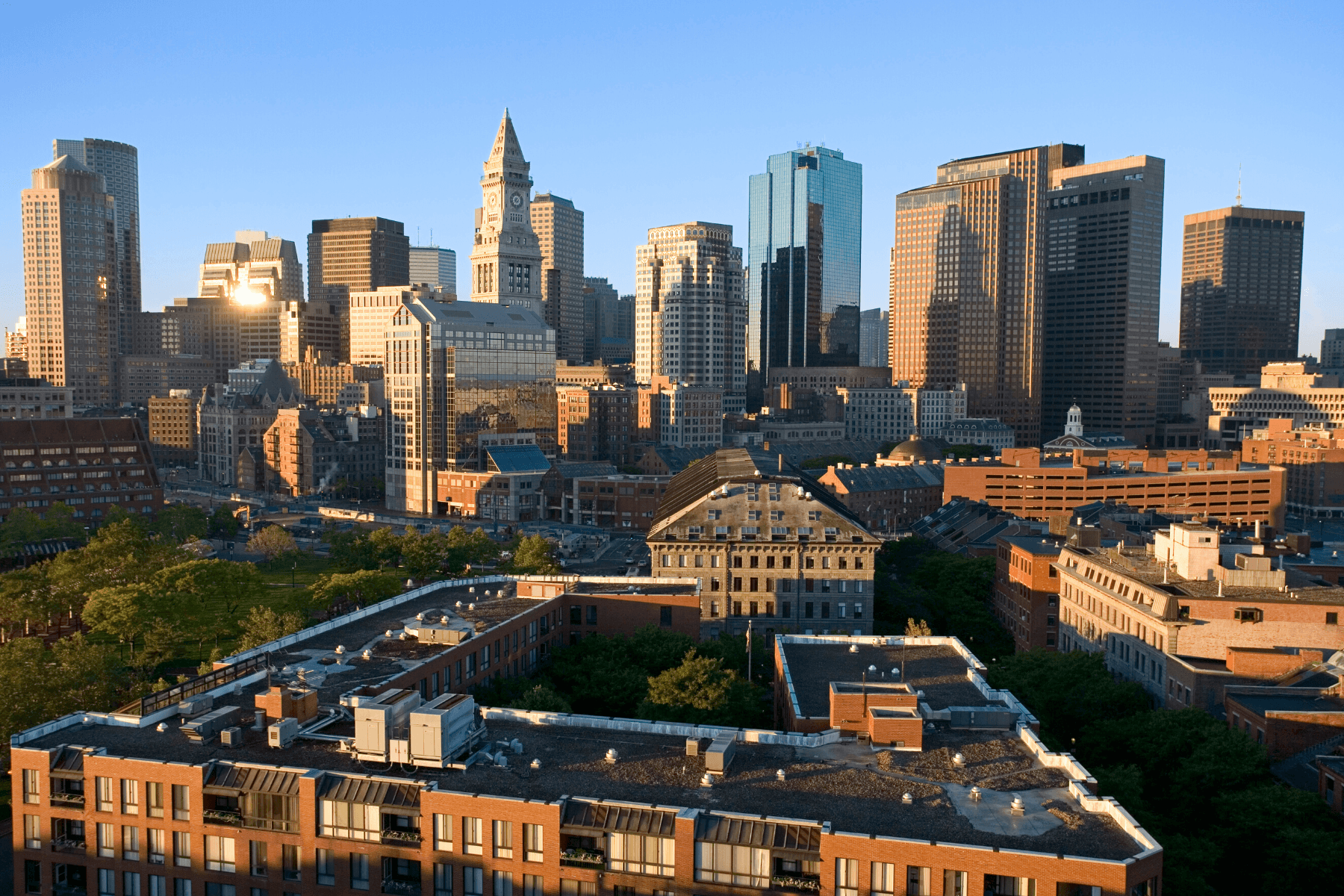
16 Historic Stops Along the Patriotic Freedom Trail in Boston, MA
Table of Contents
Follow us along all 16 stops on Boston’s Freedom Trail, a 2.5 mile (4 km) red brick trail through Boston’s historic neighborhoods, beginning with Boston Commons in downtown Boston and ending with Bunker Hill Monument in Charlestown. Founded in 1951, the trail tells the story of the American Revolution paying tribute to notable American figures such as Paul Revere, John Hancock, and Benjamin Franklin. To complete the tour on foot it can take up to a full day, so follow along as we take you through some of the steps Paul Revere took during his midnight run, alongside many other historical events.
Enjoy Your Time In Boston With Tripshepherd
#1 Boston Common
The Boston Common, America’s oldest park, was built in 1634, the first owner being William Blaxton , the first European settler of Boston. Over the years the 50 acres of land has served multiple purposes such as; cow pastures, camps during the war, dumping grounds, and protests, today the park is used for both informal and formal gatherings. Some notable events that have occurred at the park include; speeches made by both Martin Luther King Jr and John Paul II, it is also the site of Judy Garland’s largest concert, with over 100,000 attendees in 1967. In 1987, it was named a U.S. National Historic Landmark, managed by the Boston Park Department and cared for by Friends of the Public Garden. FUN FACT: In 2006, on October 21 the Common became the site of a new world record when citizens lit 30,128 Jack-o-Lantern’s around the park at the Life is Good Pumpkin Festival.
# 2 Massachusetts State House
Also known as the New State House, built in 1798 the Massachusetts State House lays atop Beacon Hill on 6.7 acres of land across from the Boston Common. Designed by Charles Bulfinch , the building serves as the state capital and seat of government for the Commonwealth of Massachusetts, considered a masterpiece of Federal architecture, recognizable for its golden dome. Inside it contains the Governor’s offices on the west end, the Massachusetts Senate located under the golden dome, and the House of Representatives on the west side in the Brigham edition.
The walls are decorated with murals from many artists including Albert Herter and Edward Brodney, who had won a competition to paint the first mural in 1936. Brodney was actually unable to afford models to pose for his mural titled “Columbia Knighting Her World War Disabled” so he instead enlisted his friends and family, doing so again for his second mural “World War Mothers”. Visitors are able to virtually watch hearings and sessions taking place in the building: Massachusetts State House FUN FACT: the dome for the Massachusetts State House was covered in copper in 1802, constructed by Paul Revere’s Revere Copper Company, making Revere the first American to successfully roll copper into sheets!
#3 Park Street Church
Founded in 1809, Park Street Church designed by Peter Banner was the first structure travelers saw when approaching the city due to its 217-feet steeple. The church is the site for many firsts including America’s first Sunday School in 1818, and William Lloyd Garrison’s first public statement against slavery in 1829. The church was created when a small former group of the Old South Church was inspired by Rev. Henry Kollock, a visiting minister whom they had asked to be their first shepherd, inclined to accept Rev. Kollock said he would do so once a church and building was established, the congregation then raised $70,000 to build a grand church seating over 800.
Today, the church typically brings in around 2,000 worshippers across Sunday services with up to 1,000 members, though membership records are kept private. Not only is the church well known for its theological history forming three seminaries (Andover-Newton, Gordon-Cornwell, and Fuller), it is also known for its role in social justice and human rights. Park Street Church was among the very first to address prison reform, education, women’s suffrage, and anti-slavery. FUN FACT: with its 217-foot steeple the Park Street Church was the tallest building in the United States up until the construction of Trinity Church in New York. Open for tours June to August visit Park Street for more information or to book a group tour via zoom.
#4 Granary Burying Ground
Dive into Boston’s third-oldest cemetery, the granary burial ground, founded in 1660. It is believed to have 5,000 individuals buried there but only 2,345 grave-markers, laying to rest many notable Revolutionary War-era patriots including; Paul Revere , the 5 victims of the Boston Massacre, Samuel Adams , Samuel Adams , John Hancock , and Rober Treat Paine ,three signers of the Declaration of Independence, and members of Benjamin Franklin’s family. Towards the back of the grounds is where tombs were initially placed, Puritan churches at the time did not believe in religious icons or imagery so instead, they used tombs as an artistic expression of their beliefs surrounding the afterlife.
A motif commonly seen in the Granary is the “Soul Effigy” which depicts a skull with a wing on each side which serves as a representation of a soul flying to heaven, some other common depictions you may see when visiting is the Grim Reaper and Father Time. The largest monument you will see when entering the Granary is the obelisk Franklin Monument constructed by Boston citizens in 1827 replacing the old worn-out original gravestones. Don’t be fooled, however, Benjamin Franklin is not laid to rest here but in Philadelphia, instead, the monument serves as the resting place for his parents Josiah Franklin and Abiah Folger alongside some of his siblings. Open daily from 9 a.m. to 4 p.m. visit Granary Burying Ground for more information.
# 5 King’s Chapel and King’s Chapel Burying Ground
Founded in 1686, King’s Chapel is the oldest Anglican church, home to over 330 years of American history, it was also the first state-sanctioned, non-Puritan church in the predominantly Puritan city. The American Revolution plays an integral role in the history of the church as only a small group of people stayed in Boston as the British troops evacuated the city during the war, those who remained joined. After going years without a minister the church transformed its congregation under the leadership of James Freeman throughout the 1780s. The pulpit built in 1754, is the oldest in the US and the magnificent interior was also built around the original stone structure in order to continue to worship during construction. The bell, originally formed in England was recast by Paul Revere in 1816 after it had cracked in 1814, still rings to this day to call for worship. For more information about King’s Chapel visit: Kings Chapel King’s Chapel was built atop the oldest English burial ground in Boston, now referred to as King’s Chapel Burying Ground. It is estimated to have at least 1,000 individuals buried there with only 505 headstones, 59 footstones, and 78 tombs with only 38 marked, some of the individuals laid to rest there include; Mary Chilton a Plymouth Pilgrim that was the first European women to step off the May Flower and ashore in New England and C Elizabeth Pain whose headstone is rumored to have been the inspiration for Hester Prynnes’ in the Scarlet Letter. In the early 19th century, time was taken to beautify urban burial grounds, adding pedestrian footpaths, iron fencing, various plantings, and steps were even taken to rearrange the gravestones into straight rows which caused inconsistencies between the markers and the bodies underneath.
We recommend a stop at Joseph Tappings headstone located at the front of the burying ground, arguably one of the most beautiful gravestones in the city, maybe even country, with a depiction of a skull battling Father Time over the inevitability of death. For more information about King’s Chapel Burying Ground visit: Kings Chapel Burying Ground
#6 Boston Latin School and Benjamin Franklin Statue
The Boston Latin School was founded in 1635 by the Town of Boston making it not only the oldest public school in America but also the oldest existing school in the United States. The curriculum followed the 18th century Latin School Movement, which emphasized the importance of learning the classics, aiming to educate young men, offering free education to boys both rich and poor. Up until the 19th century, the school only consisted of male attendees and faculty, that was until Helen Magill White not only the first female to graduate but the first woman to earn a doctorate as well, while she was in attendance at school she was the only female. The school was torn down in 1745 in order to make space for an expansion for King’s Chapel, however, the school has continued onwards to different locations with its current location in the Fenway neighborhood as of 1972, admitting both boys and girls.
Of the many students who attended the original school site, were 5 signers of the Declaration of Independence; Benjamin Franklin, Samuel Adams, William Hooper, John Hancock, and Robert Treat Paine, of these 5 men, Benjamin Franklin was the only one to graduate. The original site for the school is marked by one of its famous graduates, Benjamin Franklin, standing 8ft tall the statue rests on a 9 ft marble and granite base that features a front and back plaque, the front depicting Franklin experimenting with electricity and the back him in his printing shop. FUN FACT: Cornelia Kelley was the first female headmaster hired in 1998, serving until her retirement in 2007, and in 2017, Rachel Skerritt became the first person of color to serve as headmaster.
#7 Old Corner Bookstore
Located on what was formerly the home of Anne Hutchinson, a controversial religious figure until she was expelled from Massachusetts in 1638 for heresy, the Old Corner Bookstore is the oldest commercial building in Boston, constructed in 1718 and purchased by Thomas Crease. It remained his residence until it burnt down in 1711 during the Great Boston Fire. Crease then rebuilt a new building on top in 1817 to serve as both a residence on top floors and an apothecary on the bottom floor. It first became a bookstore in 1828 when Timothy Harrington Carter leased the space, then from 1832 - 1865, it served as the space for publishing giants Ticknor and Fields , transforming the bookstore into a meeting place for some famous American literature authors such as Charles Dickens and Nathaniel Hawthorne.
Following the death of Ticknor, Fields in 1865 sold the store to E.P. Dutton then a succession of other booksellers and publishing companies followed through the 1890s. In 1960 the building was being considered to be demolished in order to construct a parking garage, luckily the historic building was saved by Historic Boston, Inc., not-for-profit preservation and real estate that rehabilitates historic and culturally significant buildings in Boston. The building is currently the site of a Chipotle restaurant, a great spot to stop and eat while on the trail. FUN FACT: among the many published works that were produced in this building, Hawthorne’s The Scarlet Letter is one of them along with Longfellow’s Midnight Run of Paul Revere.
#8 USS Constitution
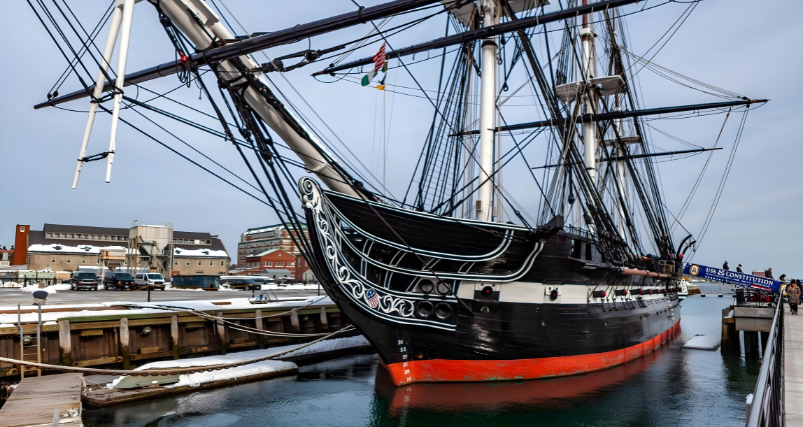
Included in our Best of Boston Tour, is the world’s oldest commissioned warship afloat the USS Constitution , also known as “Old Ironsides” located in the former Charlestown Navy Yard. Launched in 1797, this wooden-hulled three-masted heavy frigate was one of the original 6 frigates authorized by the Naval Act of 1794. The ship was used during the War of 1812 against the United Kingdom defeating numerous warships including HMS Guerriere. The USS Constitution retired from service in 1881, serving as a receiving ship until 1907 and in 1934 she completed a 3 years, 90-port tour of the nation, celebrating her 200th birthday in 1997 and 200th anniversary of the victory over Guerriere in 2012. Today, you can visit the USS Constitution Museum to understand the navy’s role in war and peace through exhibits, daily programs, and historic demonstrations put on by her crew of 60 officers and sailors. FUN FACT: the USS Constitution gained the nickname “Old Ironsides” when cannonballs from the HMS Guerriere appeared to have bounced off her hull! For more information on how to visit the USS Constitution: USS Constitution Museum
Visit the USS Constitution With Us
#9 Old South Meeting House
The Old South Meeting House was constructed in 1729 as a Puritan meeting house serving as the largest building in colonial Boston. 1768 - 1775 it became the site for massive protest meetings against British actions, the most famous of which occurred December 13, 1773, to debate the controversial Tea Tax, launching the start of the Boston Tea Party, where 342 chests of tea were dumped into the Boston Harbor by the Sons of Liberty. In 1872, the building was set to be demolished and auctioned off for its building materials. Determined to stop the demolition of the Old South Meeting House, a group named “twenty women of Boston” enlisted the help of famous Bostonians such as Louisa May Alcott and Henry Wadsworth Longfellow , with their forces combined they were able to secure enough funds to save the building and its land.
The building is now open to the public as a museum continuing to provide a place for people to meet and discuss important issues of the day. The museum is filled with stories of the men and women who played important roles in the history of the Old South Meeting House. FUN FACT: Notable members of the congregation included African-American poet, Phillis Wheatley who published her book while enslaved in 1773, and Benjamin Franklin alongside his family. For more information and to visit the Old South Meeting House Museum visit: Old South Meeting House
#10 Old State House
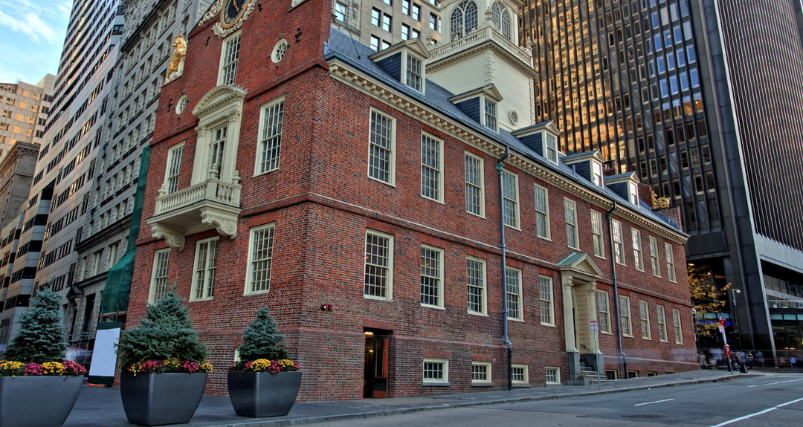
The Old State House, built in 1713 is the oldest public building in the United States, surviving the American Revolution, Boston Massacre, and the Great Boston Fire. It began as the Seat of Colony Government with the main floor serving as a Merchant’s exchange with warehouses in the basement and the Council Chamber of the Royal Governor and the chambers for the Courts of Suffolk County and the Massachusetts Supreme Judicial Court on the second floor. In 1770, on March 5th the Boston Massacre occurred right outside the very walls of the building, it was on the balcony that Lieutenant Governor Thomas Hutchinson ordered the people to return to their homes.
Then from 1776-1798, it served as the Massachusetts State House wherein 1776, member of Sons of Liberty Col. Thomas Crafts proclaimed the Declaration of Independence on the balcony. Through 1830 - 1841 it served as both Boston’s City Hall and the Boston Post Office along with several private businesses. Like many other stops along the Freedom Trail the Old State House did face the threat of demolition for real estate, to prevent this the Bostonian Society in 1881 transformed it into the building it stands today, as a museum. FUN FACT: in 1835, Mayor Theodore Lyman Jr., granted William Lloyd , editor of the abolitionist paper, The Liberator, a temporary refugee in the building from a violent mob. For more information on the museum, visit Old State House
#11 Boston Massacre Site
Located outside of the Old State House is the Boston Massacre Site, a marker positioned at the intersection of State and Congress Streets that serves as a memorial to the “bloody massacre” that occurred March 5, 1770. That evening, Private Hugh White stood outside the Boston Custom House when he engaged in an argument between Captain-Lieutenant John Goldfinch and Edward Garrick , resulting in White leaving his post and hitting Garrick, a 19-year old bookseller, on the side of his head with a musket. As the night continued, 50 Bostonians, led by Crispus Attucks, an African American former slave, crowded White throwing objects at him.
Eventually, as the crowd grew more violent shots were fired resulting in the death of 5 civilians, including Attucks. In the weeks following, 8 soldiers and 4 civilians were indicted for murder, and Boston’s Patriots and Loyalists had launched a propaganda battle. Tourists and Boston citizens are able to witness a reenactment hosted by the Bostonian Society every year on the anniversary of the Boston Massacre. For more information visit: Boston Massacre Site
#12 Faneuil Hall
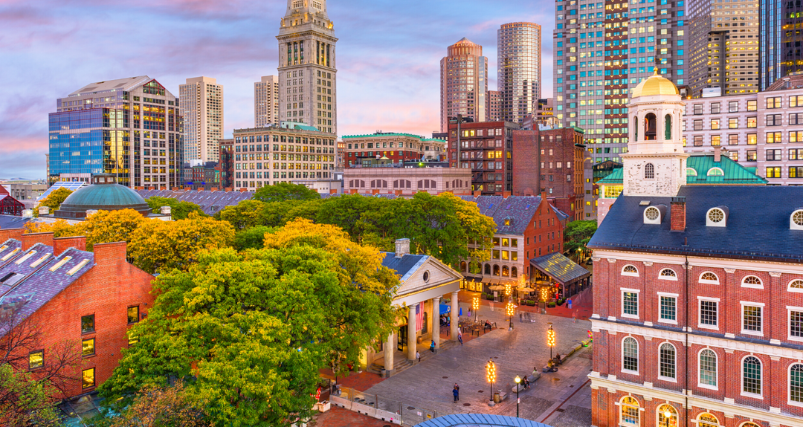
Faneuil Hall also known as “the home of free speech” and the “Cradle of Liberty” was constructed in 1764, built by artist John Smibert who used English Country Markets as an inspiration. The original building housed an open ground floor serving as a market house with an assembly room above. In 1761, the Hall was destroyed by a fire, leaving only the brick walls in its wake, the town was able to rebuild the hall in 1762. In 1806, Charles Bulfinch expanded the hall, doubling both its height and width, adding a third floor and galleries. Sitting atop Faneuil Hall is an 80-pound golden grasshopper, the most famous weathervane in the city, designed by craftsman Shem Drowne.
During the war of 1812, it is said that in an attempt to spot spies, anyone who responded incorrectly to the question: What is on top of Faneuil Hall? Would be considered suspicious. The Hall since has been the setting for 300-500 new citizens swearing-in, taking the Oath of Allegiance inside the Great Hall. Across from the historic hall is the Quincy Center and Faneuil Hall Marketplace, offering popular shopping and dining spots for visitors. To this day, the walls within the hall are decorated with paintings and sculpture busts of Revolutionary War activists, pre-Civil war abolitionists, and political leaders. You can visit Faneuil Hall and Quincy Market while on our Best of Boston Tour! FUN FACT: Durgin Park is the oldest existing restaurant in the Faneuil Hall Marketplace, opening its doors in 1826.
#13 Paul Revere House
No trip to the Boston Freedom Trail would be complete without a stop to discover the very house that the infamous American patriot, craftsman, businessman, and entrepreneur Paul Revere lived, the site where he began his 20-mile journey known as the Midnight Run. Built around 1680, this 3-story building housed Revere from 1770-1800 when Revere sold it and became a tenement with the ground floor used for shops and housing various businesses through the years.
In 1902, Revere’s great-grandson purchased the building, restoring it so it could be open to the public, opening its doors in 1908 as one of the earliest historic house museums in not only Boston but in the United States! On the evening of April 18, 1775, Revere left for his Midnight Run from this house, traveling to the Old North Church where he informed the church of the movements of the British army before riding off to Lexington alongside William Dawes to warn Samuel Adams and John Hancock of the British army approaching. Today, visitors can enter the museum to explore the artifacts related to his many business ventures. FUN FACT: The two upper stories of the museum contain furniture that is believed to have belonged to the Revere family. To visit the Paul Revere Museum: Paul Revere House
#14 Old North Church
Near the end of the historic Freedom Trail is the Old North Church, the oldest church in Boston, and the site that launched the American Revolution! Built in 1723, inspired by the works of Christopher Wren who was responsible for rebuilding London after the Great Fire, the church is the location from which the “one if by land, two if by sea” signal is said to have been sent. In 1775, Revere told three Boston patriots to watch for British troops and hang two lanterns on the church’s steeple which would serve as a warning for Charlestown patriots about the movements of the British Army.
The original steeple was destroyed by the New England hurricane in 1804 it was then replaced with a steeple designed by Charles Bulfinch but then that too was destroyed by Hurricane Carol in 1954. The current steeple incorporates design elements from both older versions, it now sits 174 feet with the original weathervane atop. Today the Old North Church is an active Episcopal Diocese of Massachusetts congregation, visitors can take a self-guided tour through the church. FUN FACT: The Queen herself alongside Prince Philip attended a Sunday morning service at the Old North Church where she was presented with a replica of a silver chalice made by Paul Revere. For more information on when you can visit Old North Church
#15 Copp’s Hill Burying Ground
Copp’s Hill Burying Ground, named after William Copp, a shoemaker and early settler, was constructed in 1659 by the town of Boston and is the second oldest burying ground in Boston. Originally named “North Burying Ground”, it contains more than 1200 marked graves of merchants, artisans, and craftspeople who lived in the North End and passed away anywhere between the colonial era and into the 1850s. During the American Revolution it became of strategic importance to the military due to its location overlooking the harbor, it is rumored that British troops used gravestones for target practice. During the Revolutionary War, more than 1,000 free African Americans and slaves were laid to rest in the burying ground and the gravemarkers and the epitaphs depicted the nature of the 17th and 18th century economy of the North End. FUN FACT: When the Freedom Trail was created in 1951, Copp’s Hill Burying Ground was not an official stop along the trail until recently. For more information when visiting: Copps Hill Burying Ground
#16 Bunker Hill Monument
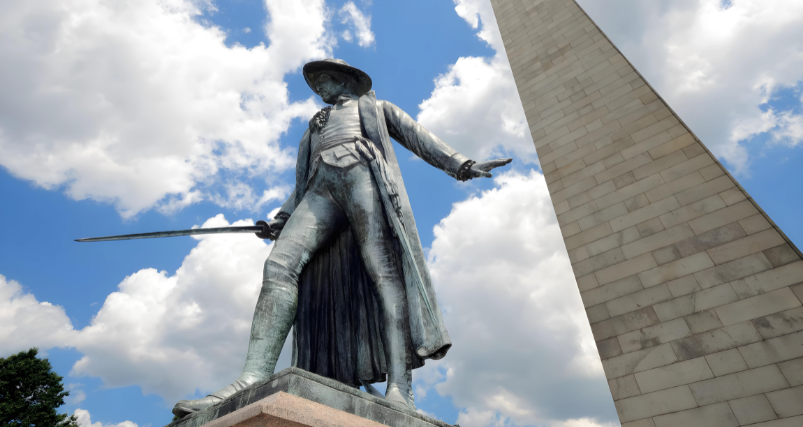
Our final stop in our Freedom Trail Tour, located in Charlestown is the Bunker Hill Monument , integral to the American Revolution. The granite monument was built to commemorate the Battle of Bunker Hill (1775), the first major battle of the Revolutionary War. The battle occurred on June 17, 1775, when New England soldiers faced the British army for the first time, though British forces were able to claim the field of the 2,400 soldiers and marines 1,000 were wounded or killed. In 1794, King Solomon’s Lodge of Masons built an 18-foot wooden pillar with a gilt urn to commemorate the fallen Patriot and Freemason, Dr. Joseph Warren, then in 1823, a group of prominent Boston citizens formed the Bunker Hill Monument Association who sought to build a more significant monument to honor the battle.
Today, it is home to the Bunker Hill Museum where visitors can view dioramas, murals, and artifacts from the battle including a cannonball, a sword, and a snare drum, among many other items. The monument not only serves as a memorial for the event and lives lost, it also serves as a reminder to continue to fight for our freedom. The Bunker Hill Monument is also one of our stops on our Best of Boston Tour! FUN FACT: the Bunker Hill Monument, standing at 67m, was the tallest memorial prior to the Washington Monument! For more information visit: Bunker Hill Monument
Visit to the historical Bunker Hill Monument
Now we have made it all the way through the historic Freedom Trail from downtown Boston at the Boston Common, to the Bunker Hill Monument in Charlestown. Traveling through 2.5 miles (4km) tour through multiple historic sites that played crucial roles in American history. From some of the oldest churches in Boston to the monuments that commemorate important patriots of the American Revolution, you have taken some of the same steps Paul Revere took during his infamous Midnight Run. If you enjoyed our tour of the Freedom Trail and exploring historic Boston, make sure to check out our Best of Boston Tour which includes both a narrated driving experience and a walking tour!
Latest Articles
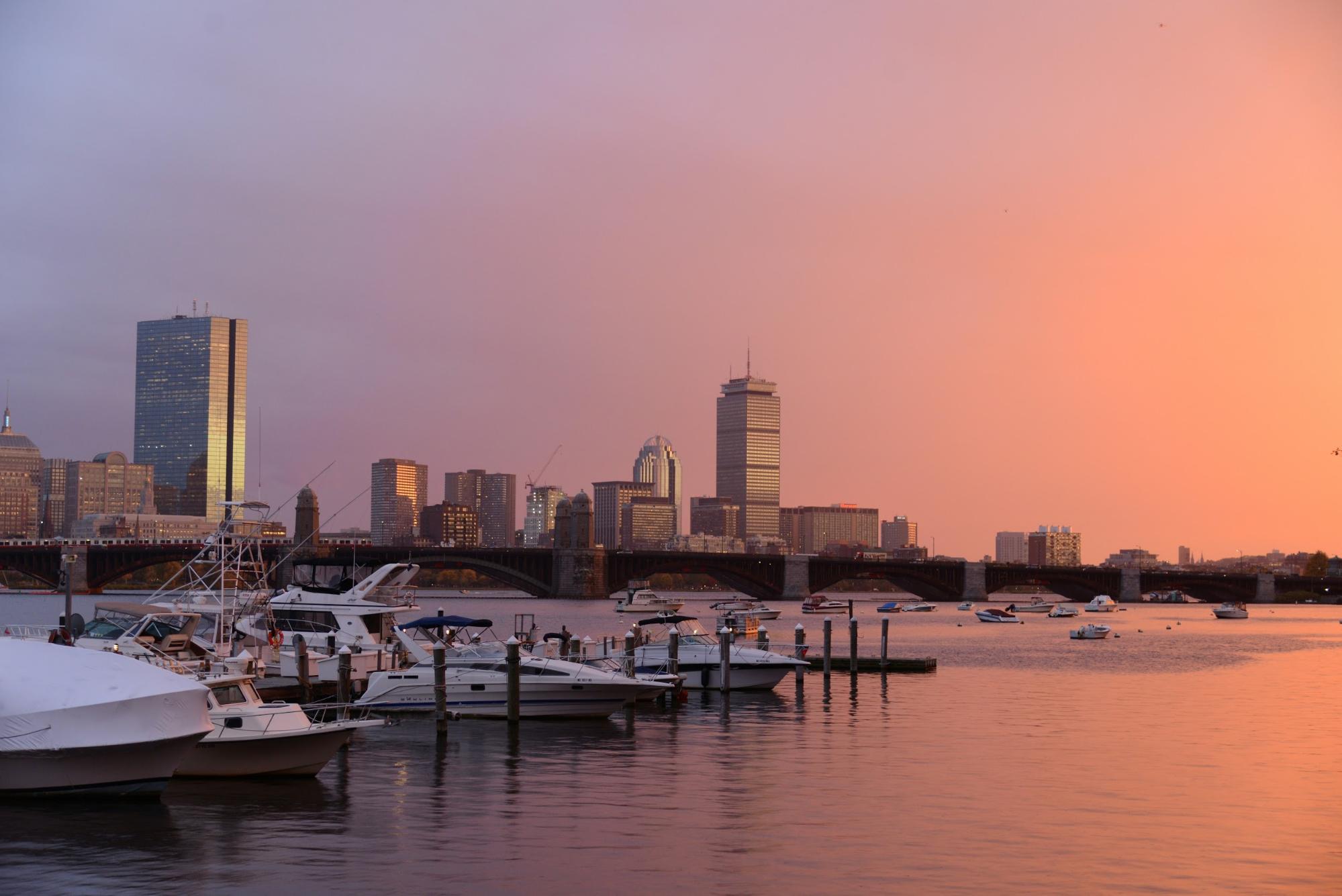
Things to Do in Boston this Weekend - March 01 to March 03, 2024
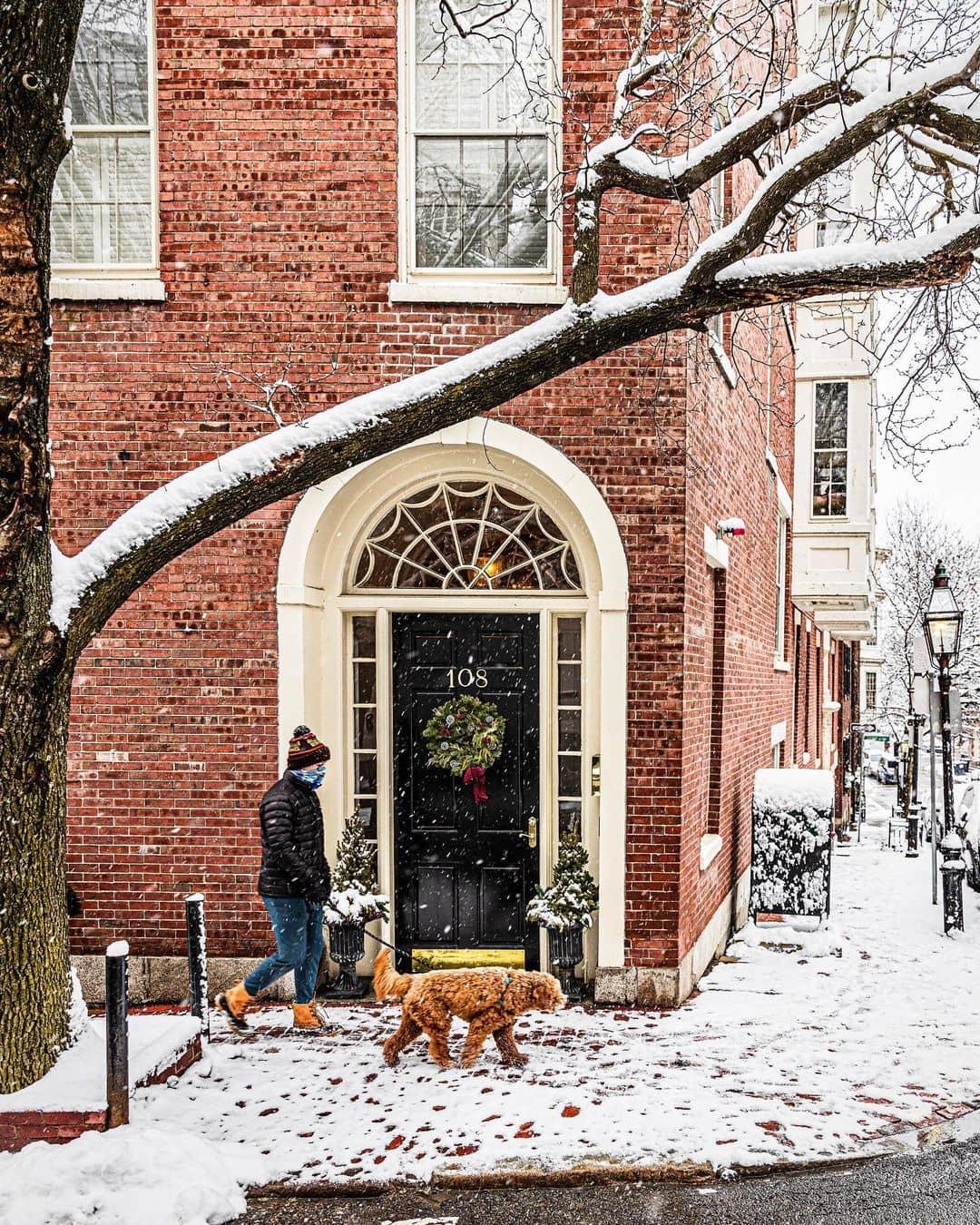
Embracing the Magic: A Guide to Visiting Boston in December
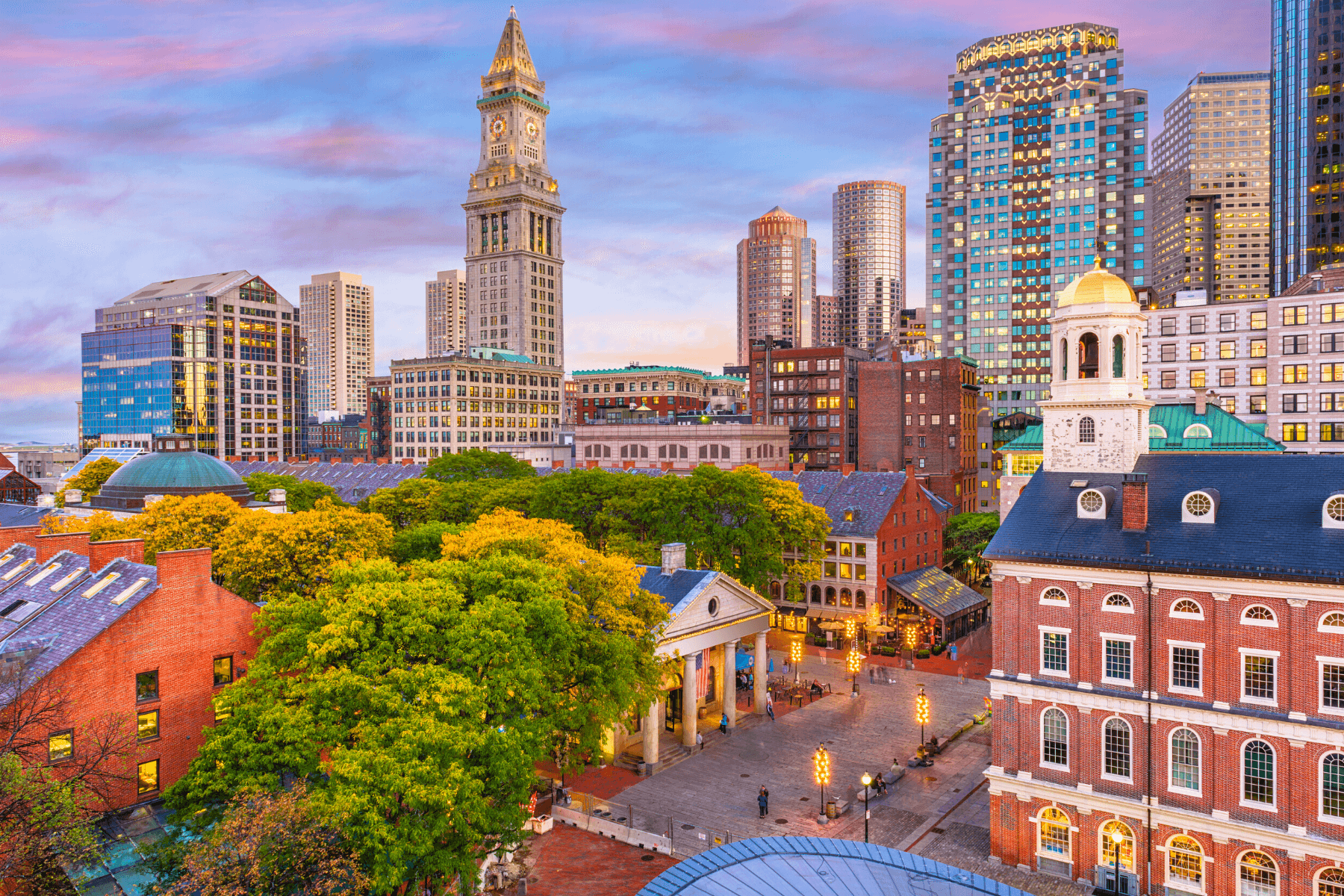
What to pack and where to explore in Boston MA, for all the seasons
Boston Through the Seasons: Temperature Talk and Attractions
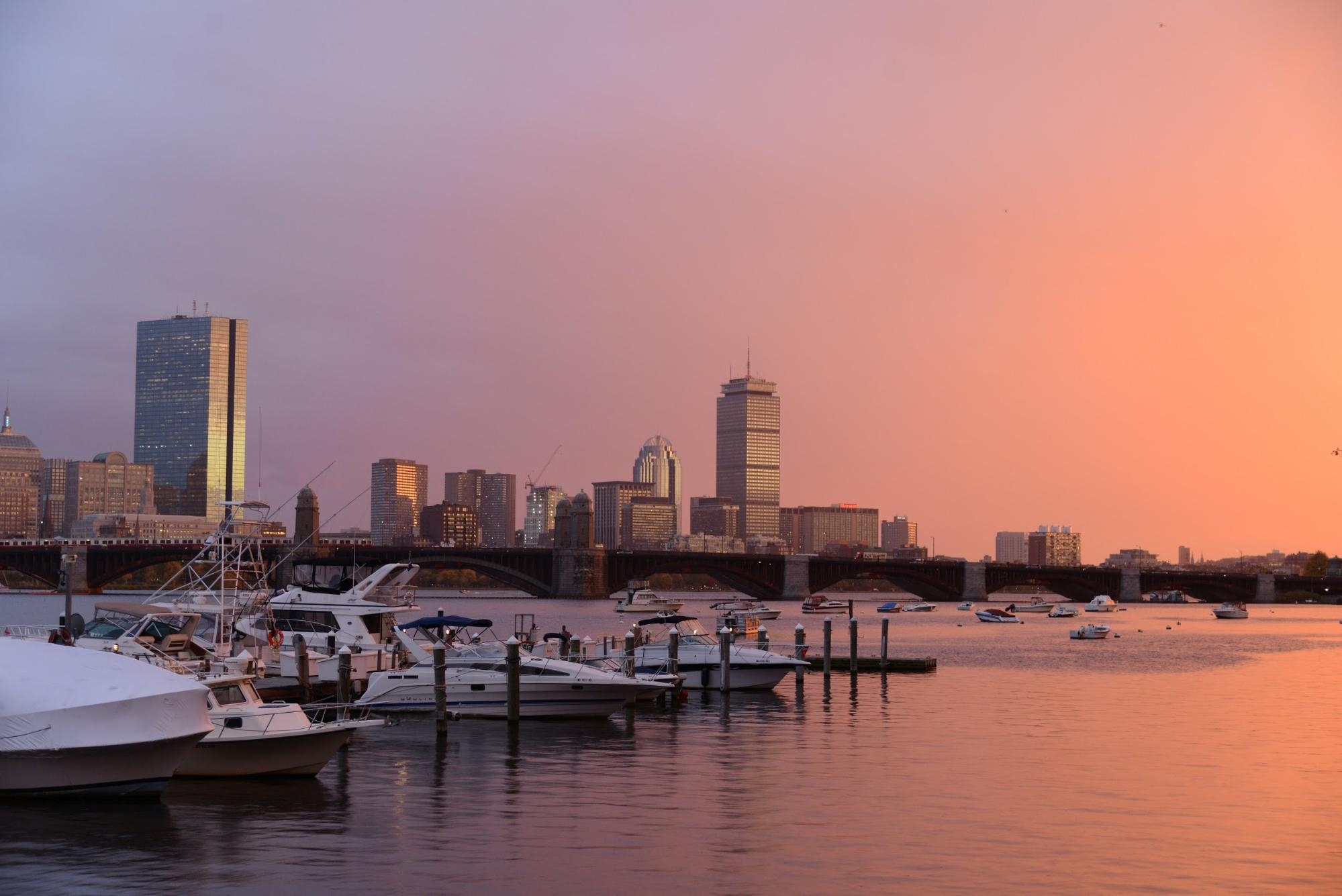
Quick Links
Book your tour.
- Private Tours
- Become a partner
Get in Touch
1-888-961-6584
1-289-271-9767
1-888-908-6056
© 2024 Tripshepherd. All Rights Reserved.

- San Antonio
- St. Augustine
- Washington DC
- HOME Main nav menu item
- MAPS & STOPS Main nav menu item
- Things to DO Main nav menu item
- SCHEDULE Main nav menu item
- REVIEWS Main nav menu item
- FAQS Main nav menu item
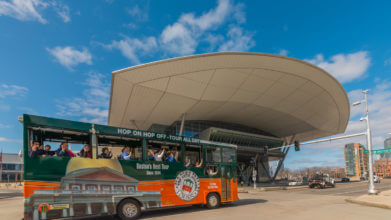
☆☆☆☆☆
★★★★★
1177 reviews
Old Town Trolley Tours of Boston 4.3
Freedom Trail
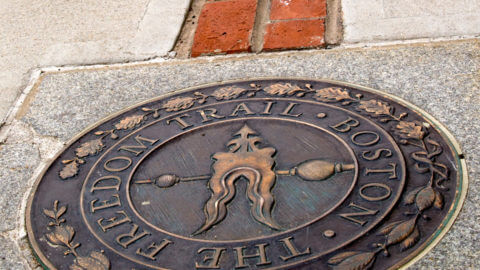
For the average Bostonian, life in the New England colonies during the 17th century was, as you might’ve guessed, not exactly one of ease and leisure. Before they were built by stone or brick masonry, homes were small, dank, drafty and made entirely of wood. This building practice was abolished toward the advent of the 1700s due to the susceptibility of fire. Most of the population subsisted as farmers, the drinking water was unsafe, medicine was still in the Dark Ages, and the average lifespan was just shy of 40 years. These were arduous and challenging times and living under the yoke of an oppressive foreign monarchy would eventually prove too much to bear and, thus, a revolution was born.
Comprised of 16 places of interest, each one a milestone in the evolution of Boston from English colony to independence, the Freedom Trail is an essential component of any trip to Boston . This historic attraction literally lays out Boston’s colonial history before you on the very streets where the city’s most transformative events unfolded several hundred years ago.
The thinking behind the design of the Freedom Trail is attributed to William Schofield, a former travel writer for the Boston Herald. He noticed that visitors eager to immerse themselves in the city’s historic past were having trouble finding the landmarks they were looking for. Schofield proposed a solution – Link the most important sites in a numbered sequence along a clearly marked, easy to follow trail that could be walked from end to end without the chance of getting rerouted or lost. There was also the idea that the Freedom Trail would’ve been a typical path to walk for the average colonist back in the day, further enhancing the sensation of traveling back in time.
Discover the magic of wintertime in Boston and embark on a historical “Transportainment ® ” adventure!

BEST WAY TO SEE THE FREEDOM TRAIL
Get MORE out of your summer in Boston aboard the iconic Old Town Trolley and see the best first!
As one of the most important cities instrumental in the forging of the republic Americans know today, the word ‘freedom’ takes on an even deeper meaning in the city of Boston. Rated by Forbes as one of the Top-Ten Best Tours in the city, Old Town Trolley Tours has applied that concept to how their tours are conducted by offering all-day hop-on, hop-off access. That means you can get off at any of the 18 stops anywhere in the city and explore the surrounding area for as long as you like. When you’re ready to re-board, simply return to the nearest pick-up/drop-off point and hop-on for more Boston adventuring! When it comes to the famous Freedom Trail, the trolley is never too far away from either of the 16 places of interest outlined on the red-brick path. As a matter of fact, the trolley stops at many of the landmarks along the Freedom Trail , making it easy and stress-free to take it all in along with the rest that this magnificent city has to offer!
Freedom Trail History
The Freedom Trail was the brainchild of local journalist William Schofield, who in 1951 suggested building a pedestrian trail to link together important local landmarks. These landmarks included Paul Revere’s house, the Old North Church , the Old State House , and the Old South Meeting House , all of which are historical gems. Schofield and then Boston Mayor John Hynes advocated for an organized route that linked them all together. Businessmen and women, elected officials, and non-profit organizations rallied together to designate a walking trail on Boston’s sidewalks in front of 16 historically significant locations.
Birth of the Freedom Trail
And so, the Freedom Trail was born. Just a few short years later, 40,000 people were walking the trail each year. And in 1958 the red line was added to clearly mark the trail. After being taken over by the National Park Service and being incorporated into Boston National Historical Park, the Freedom Trail was visited by more and more people. Today, more than three million people take the walk each year.
The Freedom Trail Includes 16 Official Historic Sites
Where Does the Freedom Trail Start
The start of the Freedom Trail is Boston Common . The length of the trail is 2.5 miles (4.0 km) and takes about 90 minutes to complete, but if you want to visit the sites along the way, it can be a whole day affair. The end of the trail is at the USS Constitution Museum . If you’re driving there, parking is available at the Boston Common Garage.
What To See on the Trail
An outdoor and indoor living history experience. You can begin your tour in the beginning, middle or the end, visiting the sites in any order you choose. The official start of the trail begins at Boston Common. The trail winds its way to the other sites including the Massachusetts State House, the Park Street Church (open summer time only), Granary Burying Ground, Kings Chapel, Kings Chapel Burying Ground, Benjamin Franklin Statue & Boston Latin School, Old Corner Book Store, Old South Meeting House, Old State House, Site of the Boston Massacre, Faneuil Hall, the Paul Revere House, the Old North Church, Copp’s Hill Burying Ground, the Bunker Hill Monument and the USS Constitution.
Each site offers a compelling look into the rich past of the American Revolution . Adults and children of all ages can learn the fascinating stories of the people, the places and the events that took place in colonial Boston as they walk the Freedom Trail.
Self-Guided Tours
A walk along the Freedom Trail can be experienced however you wish. If you’re one who likes to take your time, linger and learn; a self-guided tour may be just what you’re looking for. The Freedom Trail guides are another great way to see the sites and learn more about each one.
As one of the most popular historical tours in all of New England, the Freedom Trail’s Walk into History tours entertain and enlighten millions of guests each year. The 18th century costumed guides add a dramatic element to the tour; each one is a local Bostonian with a deep historical knowledge of the trail. You’ll hear intriguing tales of how the patriots and the colonists fought for freedom and how they succeeded in establishing what we know as the United States of America. Each tour is 90 minutes in length and is designed for individuals, groups, schools and more.
Boston Old Town Trolley Tours
Old Town Trolley is a convenient way to explore The Freedom Trail while maximizing your vacation time. With multiple stops along the 2.5 mile historic trail, you can hop on and off at the sites you want to visit and learn about the rest during our fully narrated 90 minute historic sightseeing tour. Find the lowest price and money-saying packages by purchasing tickets direct through our website.
Things To Do Nearby
Black Heritage Trail
The Black Heritage Trail features various homes, memorials, and sites that are significant in the history of Boston’s 19th century African American community. The first slaves arrived in 1638 and by 1705 there were over 400.
Approximate time to allow: 2 hours.
African Meeting House & Museum
Dedicated in 1806, the African Meeting House is the Oldest African American Church and was the First African Baptist Church. Over the years it also served as a school and a community meeting place. It was here that William Lloyd Garrison founded the New England Slavery Society, making it the center of the abolitionist movement. In 1972, the building was acquired by the Museum of Afro-American History and it was restored in 1987. Today, the museum commemorates African American history from slavery to the abolitionist movement, with a focus on educational equality.
OLD SOUTH MEETING HOUSE
Designed by architect Robert Twelves, the Old South Meeting House, one of the first stops along the Freedom Trail heading north, was built in 1792 in the red brick Georgian style with a steeple in the front and was originally a church. At the time it was built, it was the largest building in Boston and was the host to many gatherings that were too large for Faneuil Hall to accommodate. It holds a special place in the history of America as the place where Sam Adams and the Sons of Liberty rallied for support and organized the Boston Tea Party. Opened to the public in 1877 as a museum and meeting house, the Old South Meeting House, located between Washington and Devonshire streets along the Freedom Trail is one of the country’s first museums of American history .
USS CONSTITUTION
The order came down directly from the lips of this nation’s first commander-in-chief back in 1794. George Washington wanted to fortify the nascent nation under his watch with a Navy. Six frigates were built, which included the USS Constitution. She was built entirely in Boston and was the largest building project the city had ever seen. Today ‘Old Ironsides,’ the name she acquired during the War of 1812, stands as the oldest commissioned warship in the world still harbored here in the place of her birth. No longer asked to defend a nation against foreign aggression, the USS Constitution, one of the last stops along the Freedom Trail north of the Charles River , serves the public by promoting understanding of the Navy’s role in war and peace through active participation in public events and education through outreach programs, public access, and historic demonstrations.
View this post on Instagram Blue skies over Boston 💙 📸: @jgibsphoto . . . . . . . #oldtowntrolley #visitboston #boston #city #bostonian #newengland #thingstodoinboston #bostonlife #bostonbound #bostonusa #usa #america #history #familyfun #igboston #bostongram #bigcity #massachusetts #bostonmass #citylife #cityphotography #cityscapes #bostonlove #bostonma A post shared by Old Town Trolley Tours (@oldtowntrolley) on Jul 3, 2019 at 1:27pm PDT
Boston Summer Nights Tour and Charles River Cruise
Watch history shine under the moonlight! Discover Boston’s illustrious story aboard the Old Town Trolley and the Charles River Boat on this exciting evening tour. Take part in a unique adventure as the sun sets over the Charles River.
THE SITE OF THE BOSTON MASSACRE
On March 5, 1770, an angry mob gathered on Boston’s King Street demonstrating their rage over losing their jobs against the British Crown. Eventually, eight redcoats fired on the rabble resulting in several fatalities and injuries. This conflict became the rallying cry for patriots against their foreign oppressors by the likes of Paul Revere and Samuel Adams. The event caused the expulsion of British troops in Boston until their return four years later. The official marker on the Freedom Trail of this tide-turning event is located at the intersection of State and Congress Streets in Downtown Boston, outside the Old State House, a few yards away from where the Massacre took place. If you’re in town for a March wedding, you might be able to catch the reenactment that the Bostonian Society organizes for the public on the anniversary of the event.
THE BOSTON COMMON
As the oldest public park in the United States, the Boston Common is the starting point of the famed Freedom Trail. Much like New York’s Central Park, The Boston Common is located right smack in the city center and continues to be one of the most visited attractions, not just along the Freedom Trail, but in all of Boston. The story of this city and its people is firmly rooted in the history of this place beginning hundreds of years ago when the land was owned by its citizens and used as a grazing ground for cattle. After the Revolutionary War, the park became a popular locale for public speeches and rallies. Now, the Common offers a variety of activities and events, including theater and musical performances year round.
BOSTON GHOST TOUR
Old Town Trolley Tours invites you to explore Boston’s darker side aboard the city’s only “frightseeing” ghost tour , Ghosts & Gravestones. You’ll visit the streets where the Boston Strangler once prowled and hear local tales of murder and mayhem, ghosts and ghouls.
BOSTON TEA PARTY SHIPS & MUSEUM®
As the site of many game-changing historical events that helped galvanize a nation towards independence, the Boston Tea Party is widely-acknowledged as the tinder that helped spark a revolution. Located in the heart of the city’s Seaport District , this multi-sensory museum allows visitors to relive history with interactive exhibits, full-scale restored 18th-century ships, and a fully immersive tour led by a passionate team of historical actors that really puts the events commemorated by the Freedom Trail into perspective. As part of their commitment to bringing the events of this period into a sharper perspective, there is the opportunity to carouse with colonialists over a spot of tea and re-enact the Boston Tea Party itself!
View this post on Instagram 2 months from today we’ll be throwing tea in the harbor at the 245th Anniversary and Annual Reenactment of the Boston Tea Party! How will YOU be participating? #huzzah #tossthattea #december16 #bostonteaparty #bostonhistory #americanhistory A post shared by BostonTeaPartyShips (@bostonteapartyships) on Oct 16, 2018 at 2:16pm PDT
Approximate time to allow: 30 minutes.
You may also like...
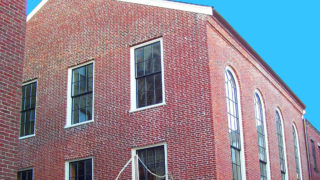
Travel Adventures in Arizona, USA & Abroad

16 Stops on the Freedom Trail In Boston
Boston is a beautiful city and public transportation makes it easy to get around. If you only have time to do one thing in Boston walk the Freedom Trail.
History buffs will love this two and half mile walk.
What is the Boston Freedom Trail?
How to see the freedom trail.
Stops along the Freedom Trail
This post may contain affiliate links. Please read my disclosure policy .
Table of Contents
The Freedom Trail is a two and a half mile trail on Boston’s public sidewalks to 13 historical sites around the city . Just follow the red lines on the sidewalk.
- Take a walking tour
- Take a DIY walking tour
- Take a trolley
You can take an organized Boston Freedom Walking tour or you can take a DIY tour. If you’re taking a DIY tour you can download the Freedom Trail app . Most tours start at Boston Common.
If you’re taking your own walking tour of the Freedom Trail, the city has a prominent red line on the sidewalks to help you stay on track. The trail includes 16 historic sites and crosses from Boston to Charleston, Massachusetts. You can learn more and book a tour at The Freedom Trail Foundation .
Stops on the Freedom Trail
If you want to take a DIY tour just follow the trail on the sidewalk that starts at the Boston Common.
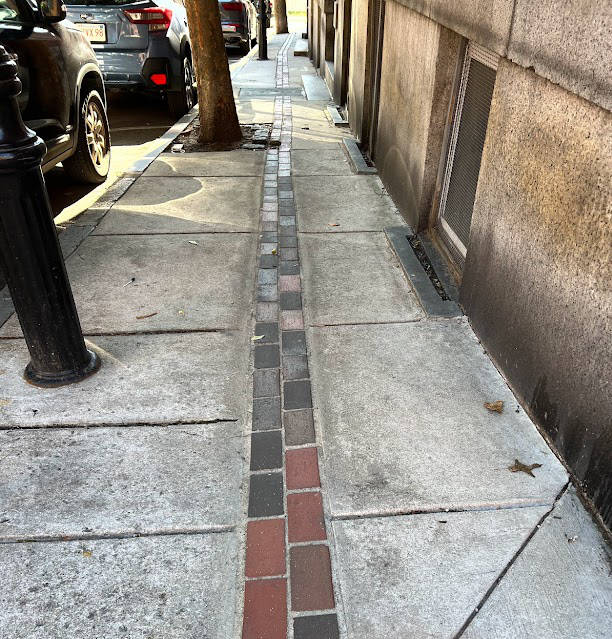
- Boston Common
Massachusetts State House
Park street church, granary burying ground, king’s chapel.
- Boston’s Latin School
Old Corner Bookstore
Old south meeting house, old state house, site of boston massacre, faneuil hall, old north church, paul revere’s house, copp’s hill burying ground, u.s.s. constitution, bunker hill monument.
First Stop on the Freedom Trail: Boston Common
Boston Common, is the first stop on the Freedom Trail and one of the most visited spots in Boston. This large public park is the oldest part in the United States. With over 50 acres to explore you could spend many hours just exploring the park. The Freedom Trail starts at the Boston Common Visitor Center. If you’re walking you just start following the red line .
How to get to Boston Common:
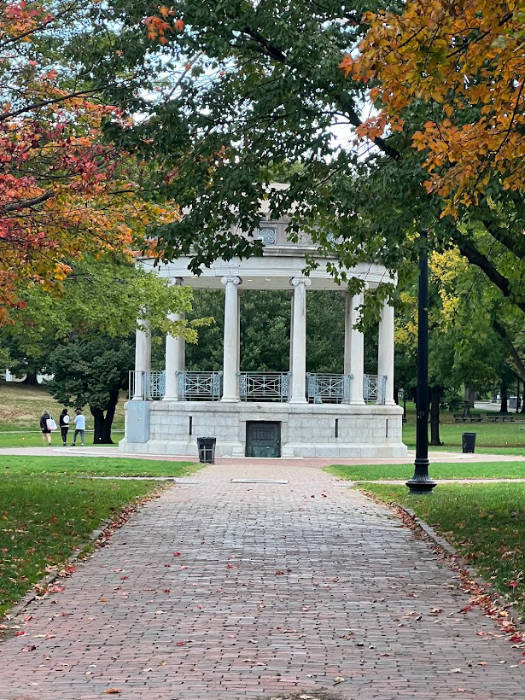
Your second stop on the Freedom Trail is the Massachusetts State House.

In the early 1800’s the Park Street Church’s steeple was one of the first thing visitors to Boston saw. The Park Street Church was built atop the city’s granary.

A short walk from the Church is the Granary Burying Ground. Some famous people are buried here such as Samuel Adams and John Hancock.
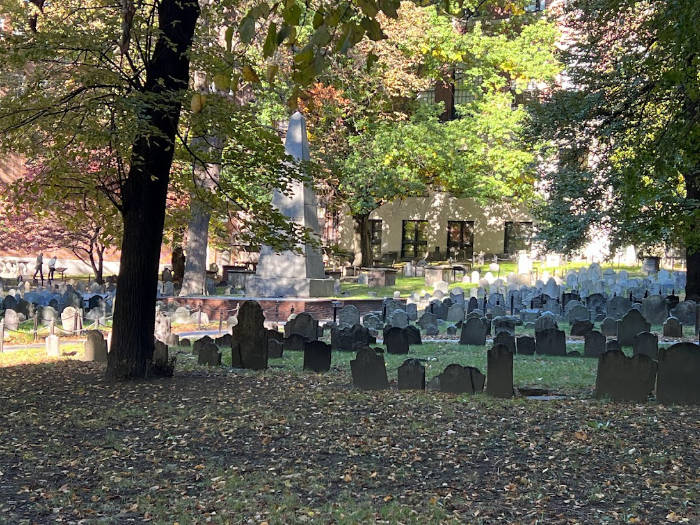
Boston’s Latin School & Ben Franklin’s Statue
The oldest public school in the U.S. was at Old City Hall. Benjamin Franklin, Samuel Adams and John Hancock attended this school. Learn about this history of Old City Hall .

Imagine living in your corner home in the mid 1600’s and waking up in 2022 to find it is now a Chipoltes. Check out this historical site where the old corner bookstore once called home. Some famous writer’s visited here back in the day.

A meeting held at the Old South Meeting House on December 16, 1773 is how this building became a significant part of American history.
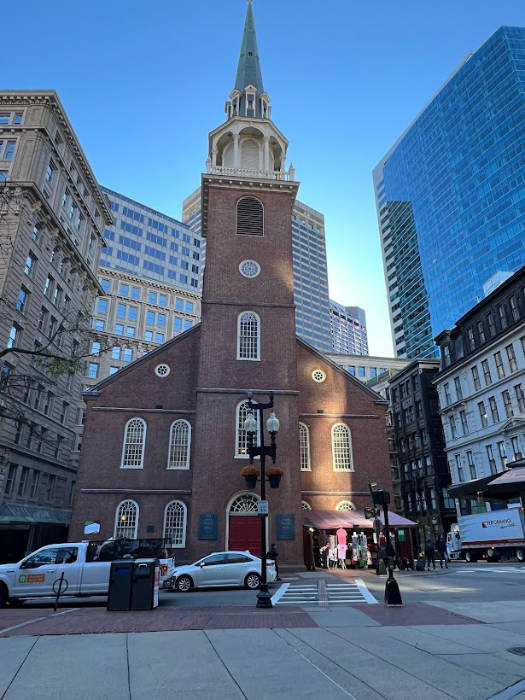
Amazing how something so significant happened in what is now such a small area in a large metropolitan city.

In 1742 Fanueli Hall was the point of commerce in town. The Hall was a place for merchants and meetings. Many famous people spoke at this hall. It was where Samuel Adams protested about taxation without representation. So it was referenced as the “Cradle of Liberty.”

The Old North Church is Boston’s oldest church. It was built in 1723 and is where Paul Revere started his famous Midnight Ride. The

When Paul Revere purchased this house it was nearly a hundred years old. Most of the house is original and if you have a chance to take the tour I would recommend doing so. Interestingly this historic house was open to the public for tours in 1908.

On the north end of Boston near the Old North Church Copp’s Hill Burying Ground is Boston’s largest burial ground. It was built in the mid 1600’s. The builder of the U.S.S. Constitution, Edmond Hartt, final resting place is at this burial ground.
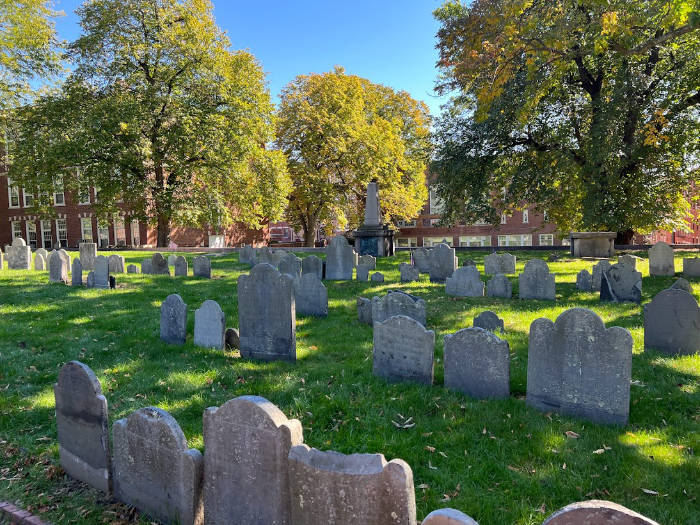
This monument marks the end of Boston’s 2.5 mile Freedom Trail. You can climb the 294 steps to see the city from the top of Bunker Hill Monument.
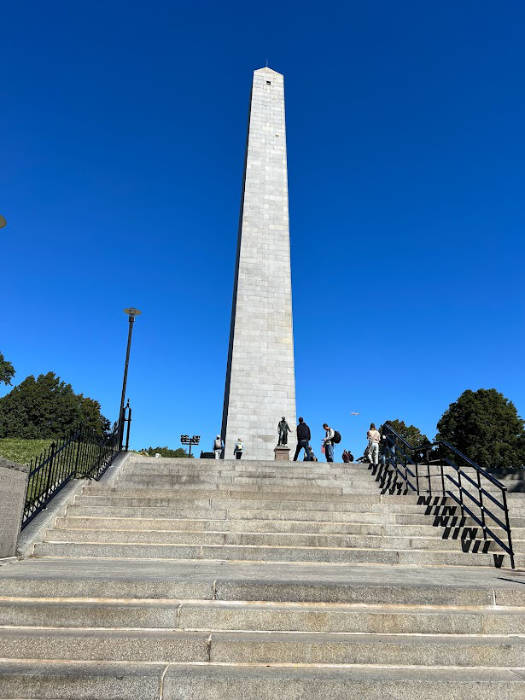
You May Also Like
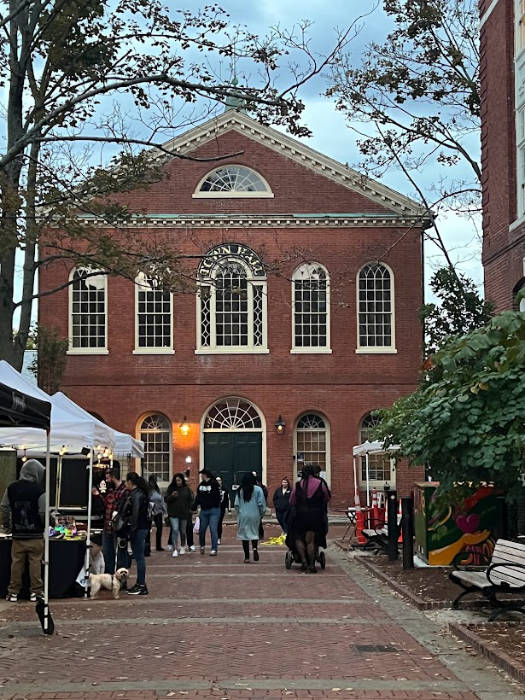
Spooky Fun in Salem, Massachusetts during the Largest Halloween Festival
Inspiring You to Explore More!
Get inspired with our great New England travel insights. Yes - Inspire Me!
Ultimate Guide to the Boston Freedom Trail by a Local
One of the great things about Boston is it’s such a walk-able city and one of the best ways to experience it is to follow its famous Freedom Trail. This 2.5 mile route will take you back in time through Boston’s most historic neighborhoods to visit 16 sites which played a significant role in American history.
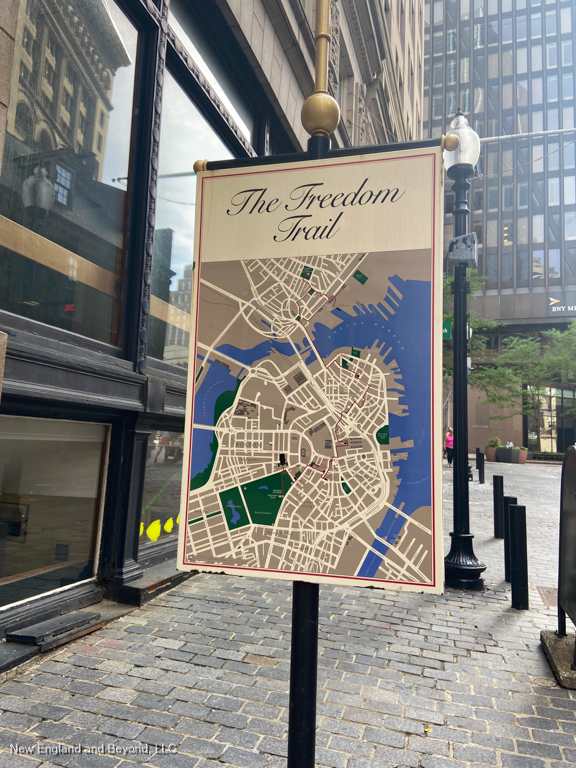
All you need to do is follow the red brick trail (or painted in some spots) throughout the city and look for the signs and markers at each historic site.
You’ll meander through the streets of Boston visiting historic homes, burial grounds, churches and monuments. You will even have the chance to tour the world’s oldest commissioned naval vessel still afloat.
The original idea for this iconic pedestrian trail came from William Schofield, a local Boston Herald journalist and Bob Winn, a member of the Old North Church. On June 11, 1951, their idea turned became a reality. The Freedom Trail was created so visitors had a clearly marked trail to the cities’ historic landmarks so they didn’t get lost.
Things you should know about the Freedom Trail
Before you head out to explore these historic sites which helped define American history, here are a few things you should know:
Where Does the Freedom Trail Start?
Where does the freedom trail take you, how long does it take to walk the freedom trail, how do i plan for walking the freedom trail, what are the sites on the freedom trail, hitting the trail.
The Freedom Trail officially starts at Boston Common and ends at Bunker Hill in Charlestown , but you can explore these 16 landmarks in any order that works best for you.
Just follow the Red Brick Path and you will stay on course.

The Freedom Trail will take you on the path that our founding fathers took through some of Boston’s most popular areas. You will visit the Boston Common , Boston’s Historic Downtown and Waterfront , the North End and Charlestown .
To truly experience Boston, make sure you take some time to explore each of these great areas.
At 2.5 miles in length , you can complete the entire Freedom Trail in just a few hours but plan on covering much more ground. Some Freedom Trail sites offer tours for free or a small fee. If you plan on visiting any of the sites along the way, you can easily spend an entire day on the trail. Plan on at least 2-3 hours minimum. If you plan on visiting the museums or touring any of the sites on the route you will likely need more time.
Insider Tip : If you have time, I highly recommend splitting the trail up over 2 or more days. This allows you to better experience each area and may save you from some very tired feet and information overload.
Do some research before hitting the trail and make a plan on which sites you may want to tour. You may want to purchase tickets before you go and some sites are not open everyday. Use this post along with the Official Freedom Trail brochure which is a handy resource listing official websites of each site and tour information.
Be sure to wear comfortable shoes and be careful on the brick and cobblestone pathways which can be uneven. Also bring along a bag or backpack with snacks, water and sweatshirt as it can get cool along the water – even in summer.
The sites you will visit along the Freedom Trail include:
- Boston Common
- State House
- Park Street Church
- Granary Burying Ground
- King’s Chapel & Burying Ground
- Boston Latin School Site & Ben Franklin Statue
- Old Corner Bookstore
- Old South Meeting House
- Old State House
- Boston Massacre Site
- Faneuil Hall
- Paul Revere House
- Old North Church
- Copp’s Hill Burying Ground
- USS Constitution
- Bunker Hill Monument
To get started, we will begin at Boston Common , the official starting point of the Freedom Trail . But remember you can start at any site if that is more convenient for you.
Find your way over to the Boston Common Visitor Information Center located at 139 Tremont Street where you can grab a map and use the restrooms before heading out. Boston’s Official Freedom Trail Walking Tour departs from the visitor center and covers stops 1-11.
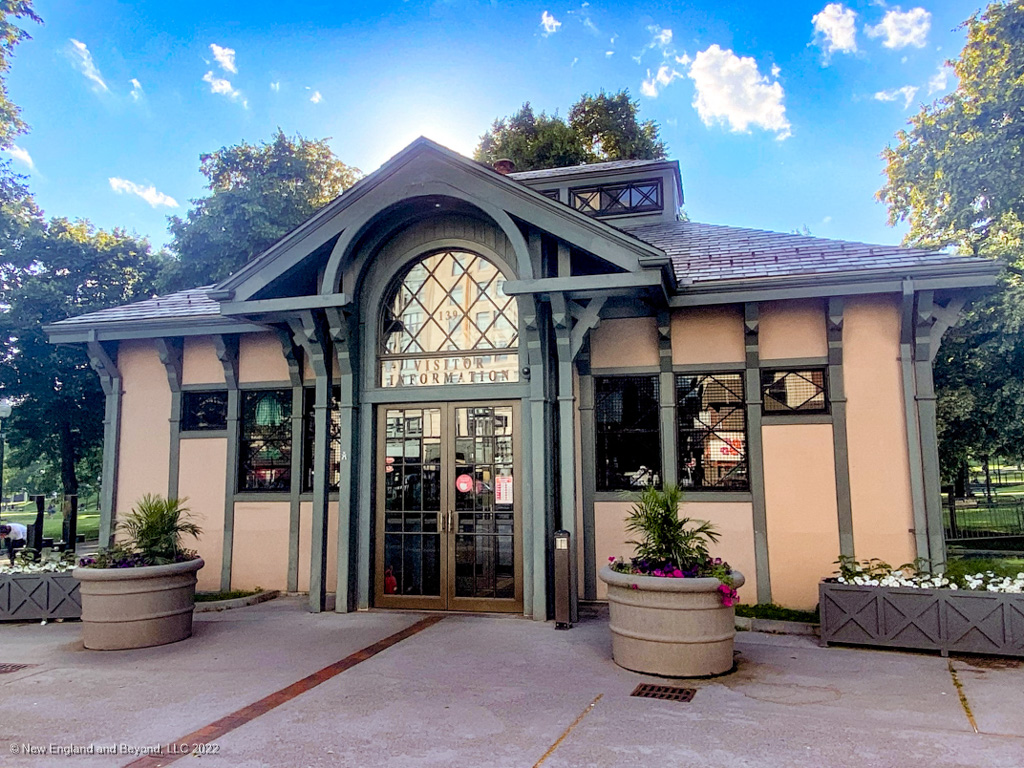
The Visitor Center is open daily year round. Visitor Centers are also located in Faneuil Hall and the Charlestown Navy Yard.
#1: Boston Common
Official start of the freedom trail.
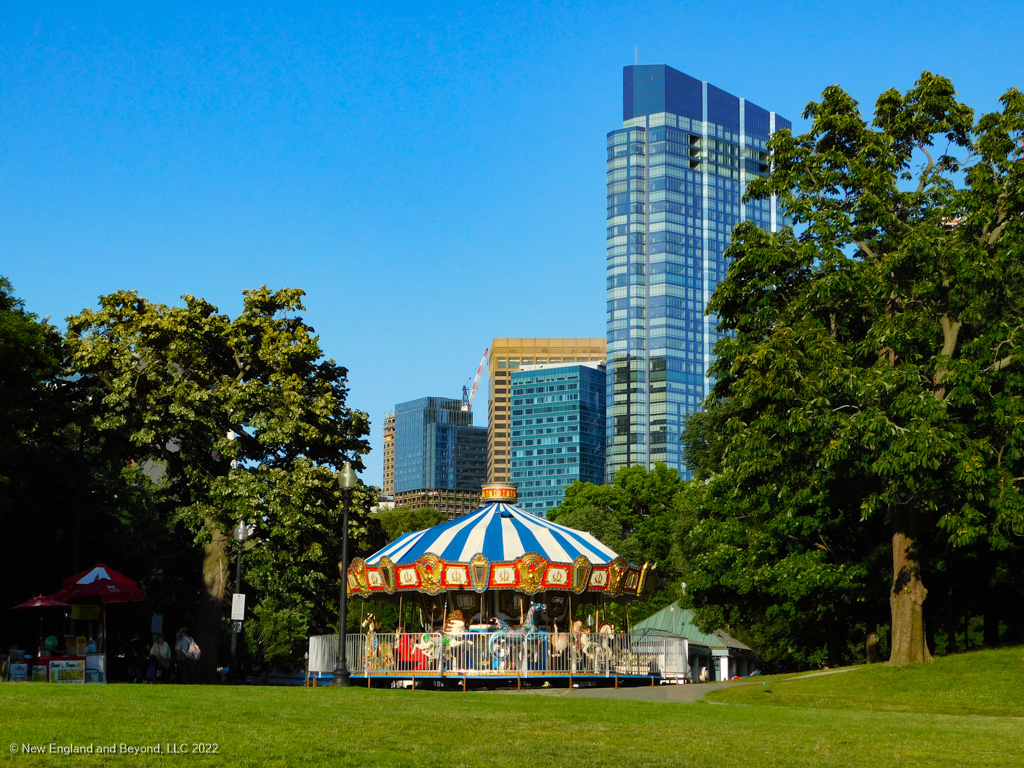
Established in 1634, Boston Common is considered to be the oldest public park in the United States and in 1987 became a National Historic Landmark . In Boston’s early days, this space was used for cattle grazing, an encampment for the British soldiers and even held public hangings.
Today, this 44 acre green-space is considered to be the heart of the city and is used year-round by Bostonians and visitors alike. In the warmer months, you’ll find people jogging the trails, playing ball or soaking up the sun. Kids have a blast at the Frog Pond Splash Park , Tortoise Playground and Vintage Carousel as well. The park is spectacular to walk through in the fall. In the winter, the pond becomes a popular ice skating rink.
Insider Tip: Visit Boston’s Public Garden which is located adjacent to the Boston Common across from Charles Street. This tranquil garden is my favorite green-space in Boston and should not be mis sed.
#2: The State House
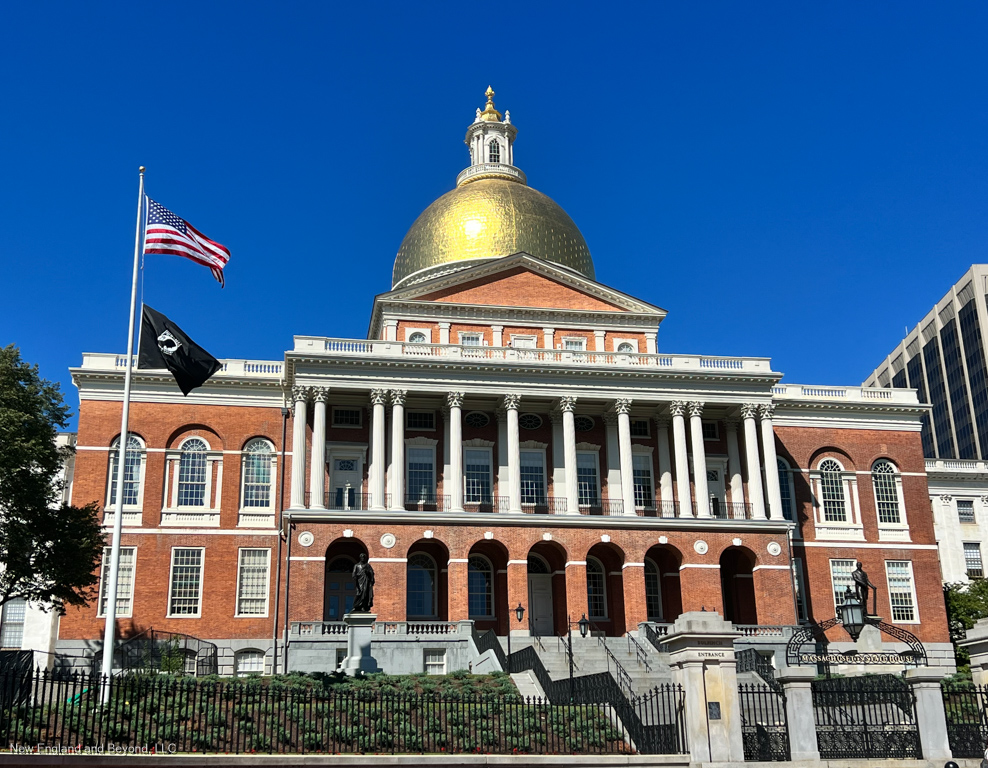
With its famous Gold Dome , the State House is quite an impressive site sitting atop Beacon Hill. Designed by Charles Bulfinch , this was the first major building he created before becoming one of America’s most famous architects. Construction began on July 5, 1795, with it’s cornerstone being set by Paul Revere and Samuel Adams , the State Governor at the time.
This magnificent Federal style building was completed in 1798 and is the oldest building on Beacon Hill . The dome was originally made from wood but Paul Revere’s company was commissioned to cover it in copper. In 1874, the 24 karat gold leaf was added, as it appears today.
Tour Info: Free guided tours of the State House (24 Beacon Street) are given daily Monday through Friday from 10:00 am — 3:30 pm . To book a guided in-person tour call 617-727-3676. To get an inside look, take a 360° Virtual Tour or Virtual Guided Tour . Tours leave from Doric Hall and last approximately 45 minutes.
#3: Park Street Church
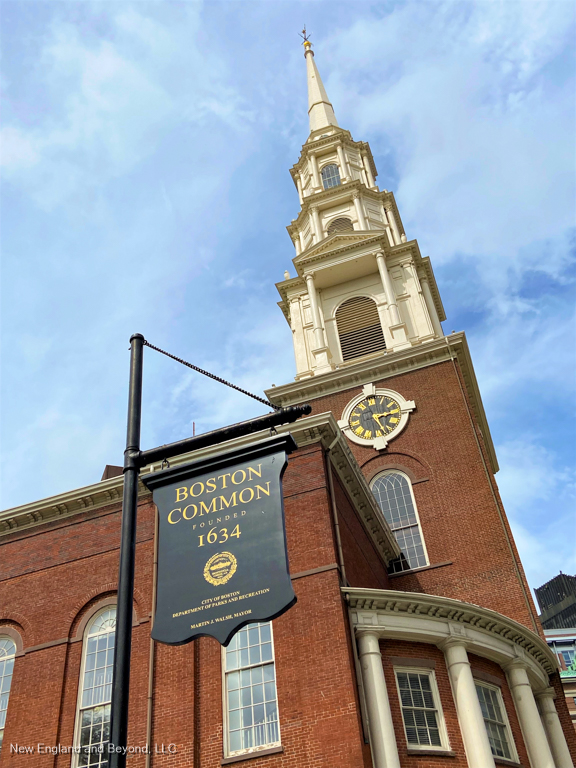
Next to Boston Common, on the corner of Tremont and Park Street, is Park Street Church . Once the site of the Old Granary, it was originally used for public grain storage . In 1809, the Old Granary was torn down and this impressive Park Street Church was erected.
The church played a key role in the movement to abolish slavery, as it was the site where abolitionist William Lloyd Garrison gave his first antislavery speech. This is also where the Hymn “ America, My Country, Tis of Thee ” was first sung.
The 217 foot steeple is one of the most beautiful in New England and was once the first landmark visitors saw when arriving in Boston . Today, the church continues to be a very active Evangelical church.
#4: Granary Burying Ground
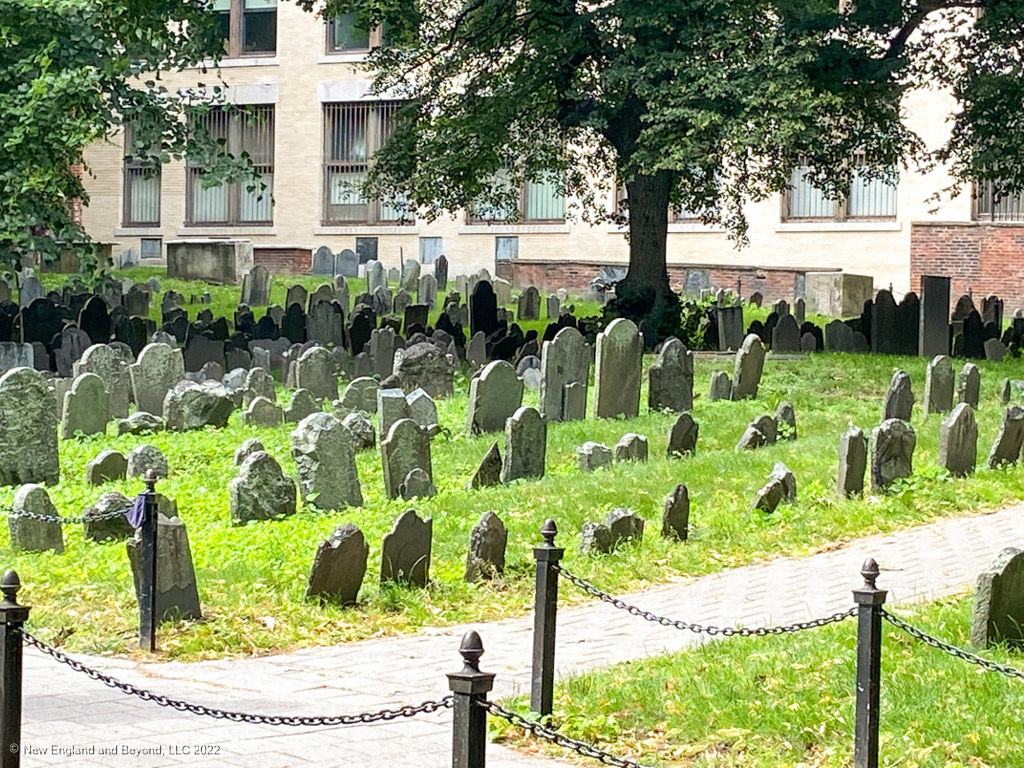
Behind Park Street Church, you’ll find the Granary Burying Ground. This is one of Boston’s oldest burial grounds , dating back to the 1660’s. Spend some time in this peaceful tree-lined cemetery exploring the inscriptions of over 2400 tombstones.
Here is the final resting place for a number of famous patriots and revolutionary heroes, including Samuel Adams , John Hancock , and Paul Revere . Other notable people buried here include Peter Faneuil , the wealthy merchant who built Faneuil Hall, Ben Franklin’s parents and the Boston Massacre victims.
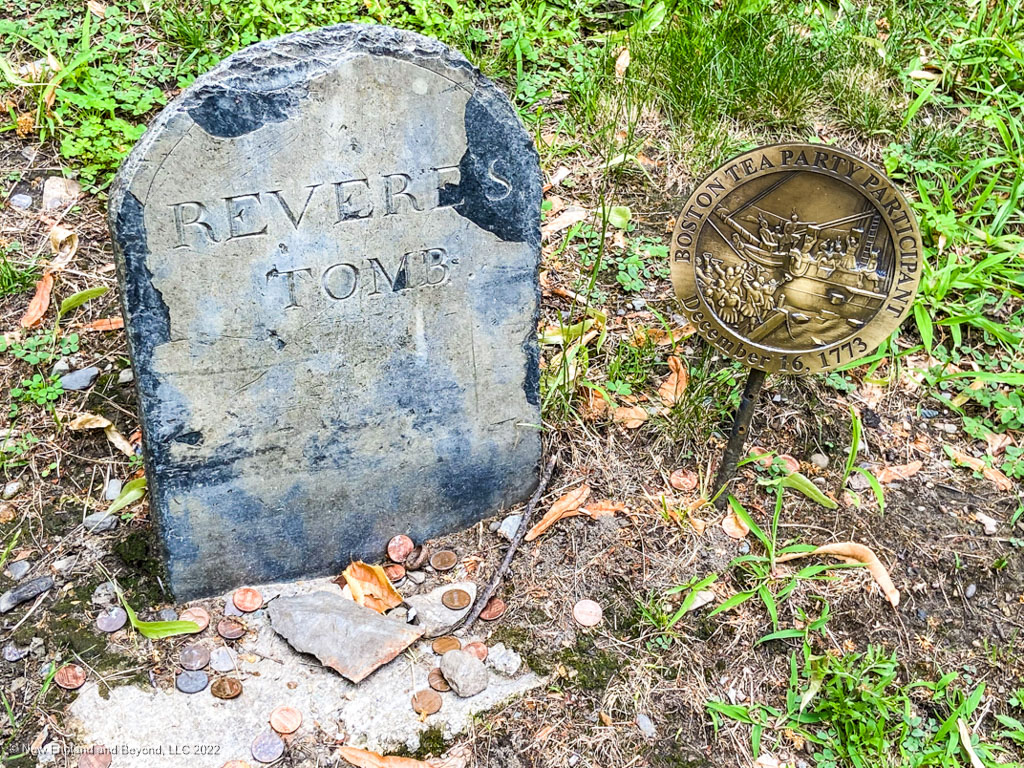
Tour Info: Free – Gates are open each day between 9:00 am and 4:00 pm and there is no entrance fee. A guide usually stands at the entrance to pass out a 16-page guidebook that visitors can use while inside. This was a great resource with interesting facts.
#5 : Kings Chapel and Burying Ground
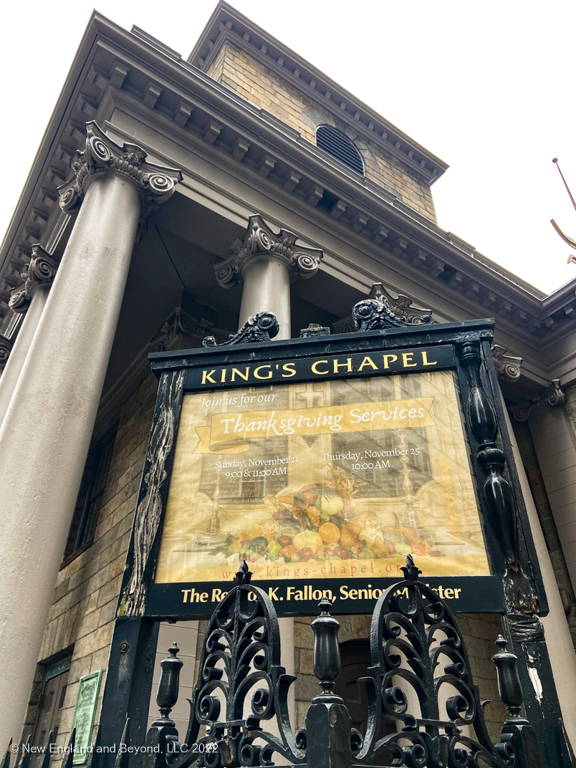
A short stroll from the Granary Burial Ground you will find King’s Chapel , the first Anglican church in New England. Established in 1686, it is one of the oldest churches in Boston and houses the oldest pulpit still in use in North America . The existing stone structure was built around the original wooden structure so worship services could continue during construction.
The interior was magnificently designed in Georgian architecture and is worth a visit when open . Its bell, which cracked in 1814, was recast by Paul Revere in 1816 and still rings today. King’s Chapel became a Unitarian church in 1785.
Tour Info: There are several tours you can take of the chapel, including the Bell and Bones tour and Art and Architecture (Sundays). Every Tuesday there are music recitals at 12:15pm with various performers.

King’s Chapel Burying Ground is Boston’s oldest graveyard where many of the first generation of colonialists are buried. Notable people who rest here include Charles Bulfinch , the famed State House architect and Boston’s first governor, John Winthrop.
#6: Boston Latin School Site / Benjamin Franklin Statue
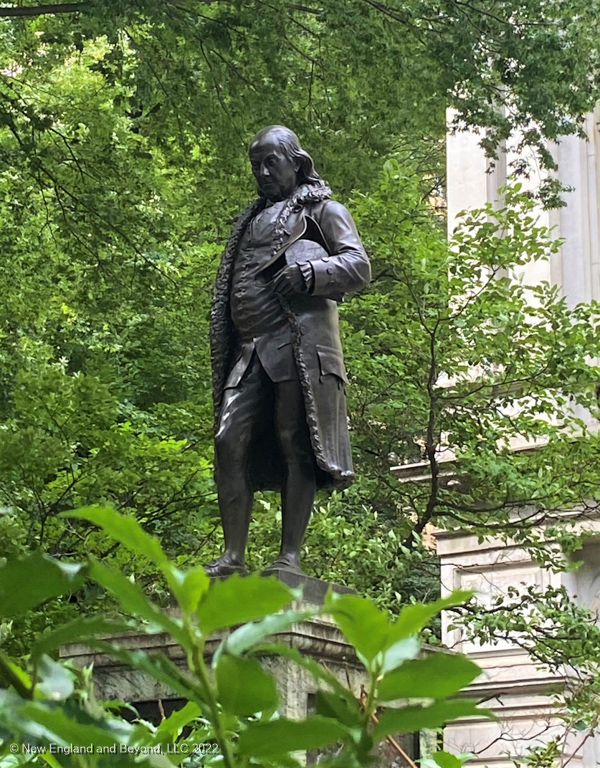
Founded in 1635, Boston Latin School was the first public school in America and has been educating students for almost 400 years. The original building was torn down in 1745. After moving locations several times, the school is now located in the Fenway area. Today, the Old City Hall sits in this location and is used for office and retail space, including Ruth’s Chris Steak House.
In front of Boston’s Old City Hall stands an 8 foot bronze statue of Benjamin Franklin , commemorating the school’s most famous student.
#7: The Old Corner Bookstore
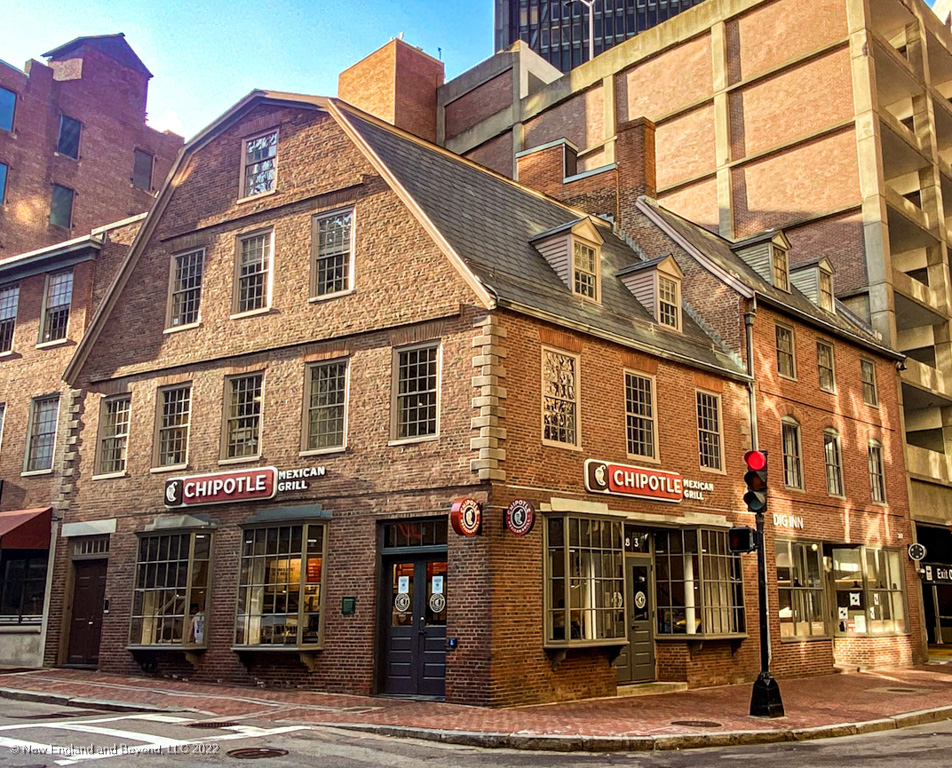
The Old Corner Bookstore is one of the oldest brick structures in Boston . Built in 1718, the building was originally used as an apothecary.
Later, several booksellers and publishers resided in the building. During that time, some well-known classic literary works were published here , including The Scarlet Letter and The Star Spangled Banner. Famous authors like Ralph Waldo Emerson, Nathaniel Hawthorne, Charles Dickens, Mark Twain and Harriet Beecher Stowe would also meet here to share ideas.
In the 1960’s, this historic building almost became a parking garage, but the Historic Boston Incorporated (HBI) organization stepped in to save the building and restored it in 1970.
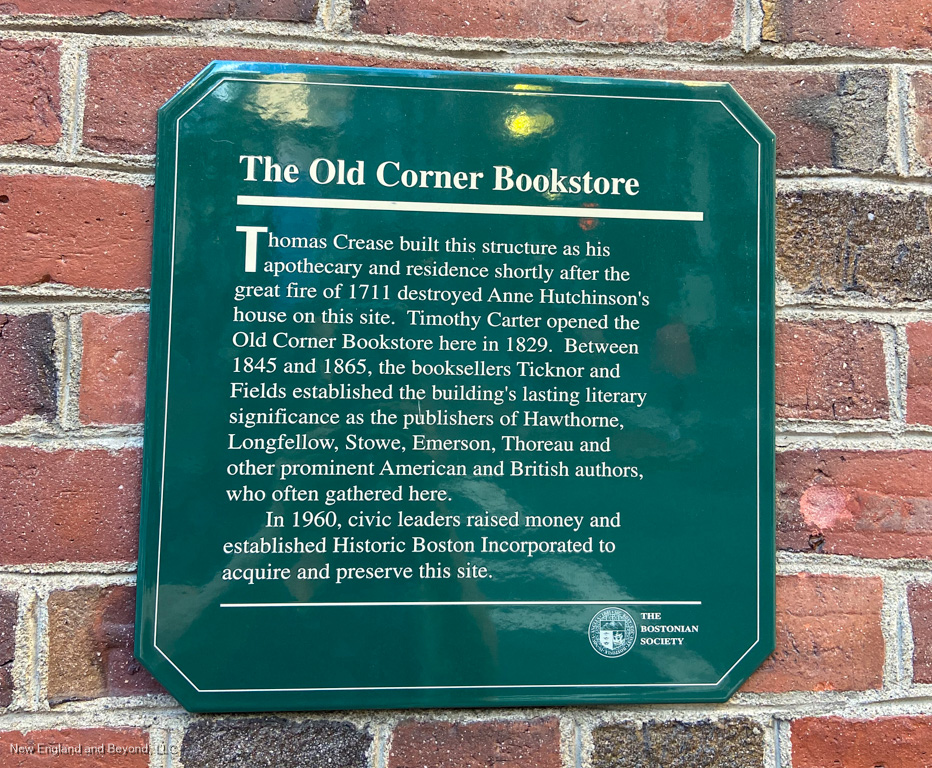
Today, the building is occupied by Chipotle, a fast-food restaurant, and is the only site on the Freedom Trail that is completely commercial . The only reminder of its past is a small plaque on the side of the building. In 2017 there was a petition to turn the building back into a museum. Unfortunately that has not come to fruition.
#8: Old South Meeting House
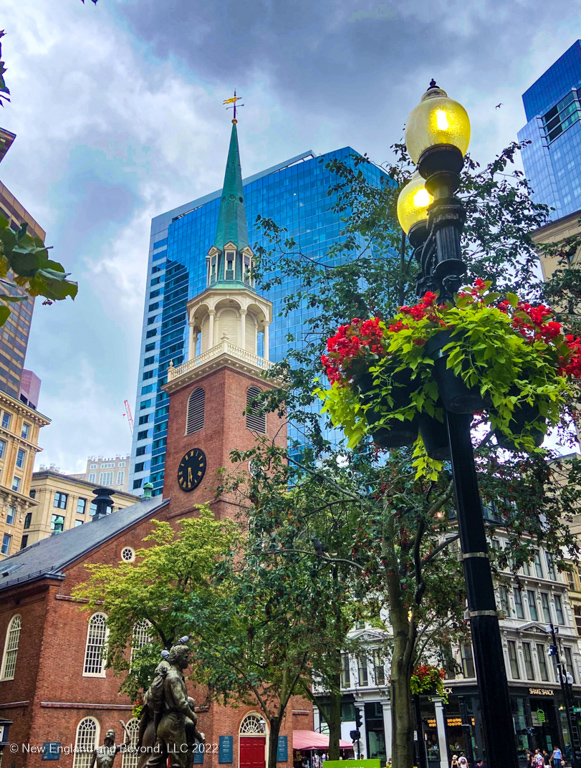
The Old South Meeting House is an iconic Boston landmark which was used as a meeting place for colonists to debate their concerns about British rule.
On December 16, 1773 , over 5,000 men crowded into the meeting house to protest the controversial tea tax. This is when Samuel Adams triggered the Boston Tea Party . By uttering a special code, he instructed the Sons of Liberty to take action, dumping loads of tea into Boston Harbor.
Since 1877, the Old South Meeting House has been a museum and is still used for meetings and gatherings today. The clock inside the tower is the oldest American-made tower clock in operation at its original location in the nation.
Tour Info: The Old South Meeting House is open to the public for general admission but you will need to reserve an entry ticket online. The $15 fee provides entry to both the Old State House (206 Washington St.) and Old South Meeting House (310 Washington St.). Discounted tickets for seniors, students and children under 12 are available.
#9: Old State House
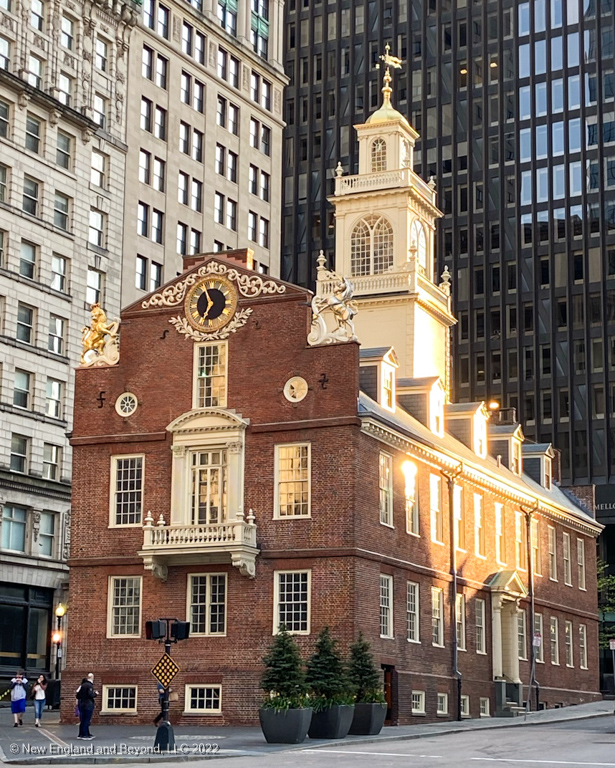
The Old State House is Boston’s oldest public building and was once known as the “Town House”. In its early days, the building was used by the Massachusetts government and courts and used as a Merchant’s Exchange.
The Old State House is the site of the Boston Massacre and where the Declaration of Independence was first read in 1776 from the east balcony.
Today, this historic structure is a museum which showcases items which help tell the story of Boston’s role in the Revolutionary War. Be aware that the museum is not currently handicap accessible and you will need to climb a spiral staircase with 30-40 stairs. Beneath the building is the State Street T station.
Insider Tip: Visiting in July? Every 4th of July there is an annual reading of the Declaration of Independence.
Tour Info: The Old South Meeting House is open to the public for general admission but you will need to reserve an entry ticket online. The $15 fee provides entry to both the Old State House (206 Washington St.) and Old South Meeting House (310 Washington St.). Discounted tickets for seniors, students and children under 12 are available.
#10: Boston Massacre Site
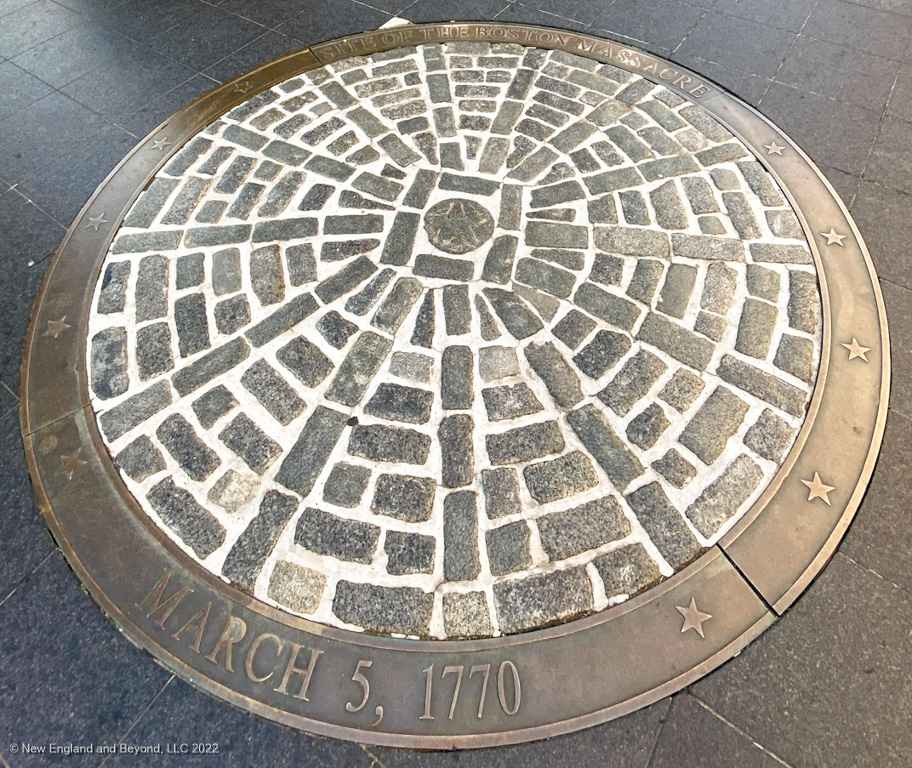
With tensions mounting, the clash between the British and Patriots came to a head on March 5th, 1770 . This is when British soldiers opened fire on a crowd of unarmed colonists, killing 5 men under the East Balcony of the Old State House.
Known as the Boston Massacre , this event is considered the first bloodshed of the American Revolution as it escalated disputes between the British and colonists which led to the Revolutionary War.
In front of the Old State House you will find a ring of brass and cobblestones built into the pavement . This marker at the intersection of Washington and State Streets serves as a reminder of the event that sparked the Revolutionary War.
Insider Tip: Visiting during March? Each March special reenactments of the Boston Massacre are held to commemorate the event.
#11: Faneuil Hall
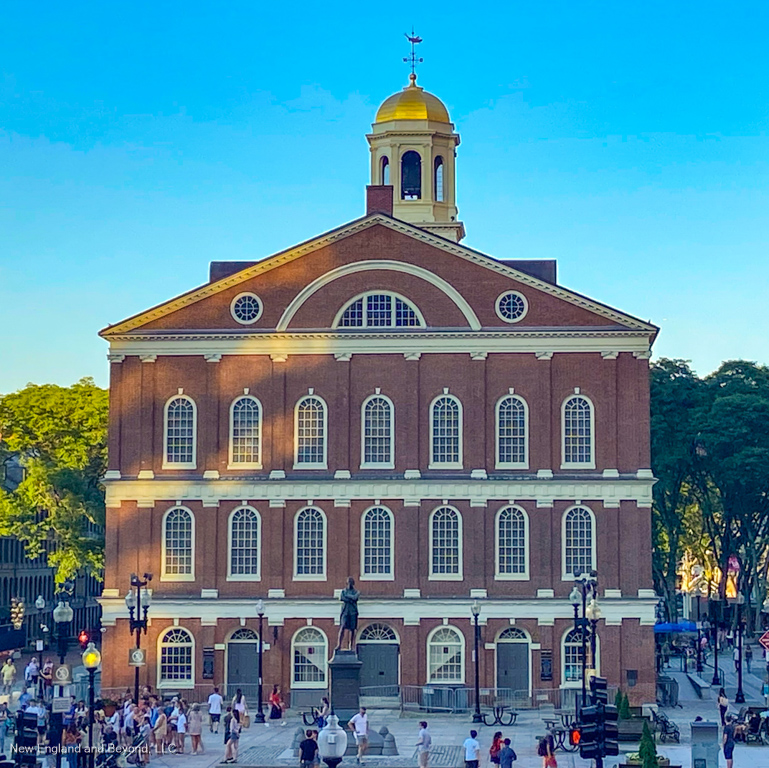
Built in 1742, Faneuil Hall is a four-story brick building which was a gift to Boston from wealthy merchant Peter Faneuil . It served as a marketplace and meeting hall where colonists protested British authority and taxes.
Faneuil Hall played an important role in history. It is considered to be America’s first town meeting hall and was known as the “ Cradle of Liberty ”. It is here where James Otis and Samuel Adams gave impassioned speeches against the Stamp Act, coining the slogan, “ No Taxation without Representati on”.
Today, Faneuil Hall is one of four historic buildings which make up Faneuil Hall Marketplace , also commonly known as Quincy Market .
If you look on top of the cupola , you will see the famous “ Golden Grasshopper ” weather vane. It is said to be a replica of one at the Royal Exchange in London.
Stop inside the Faneuil Hall Visitor Center to visit the free museums or browse the gift shop. You can also visit the Great Hall on the second floor when not in use and the Ancient and Honorable Artillery museum on the fourth floor. Public restrooms are located downstairs.
Top 10 Must Do Activities When You Visit Faneuil Hall
Insider Tip: Faneuil Hall is a great place to take a break and grab a snack or lunch at one of the many restaurants in the area. But if you are looking for some great Italian food, definitely hold off and continue to the North End.
#12: Paul Revere House
From Faneuil Hall you will follow the trail into the North End to the quaint little North Square , where you will find a small wooden house where Paul Revere once lived.
On this leg of the trail, keep an eye on the brick path as it gets a bit confusing, especially if the sidewalks are crowded in the North End.
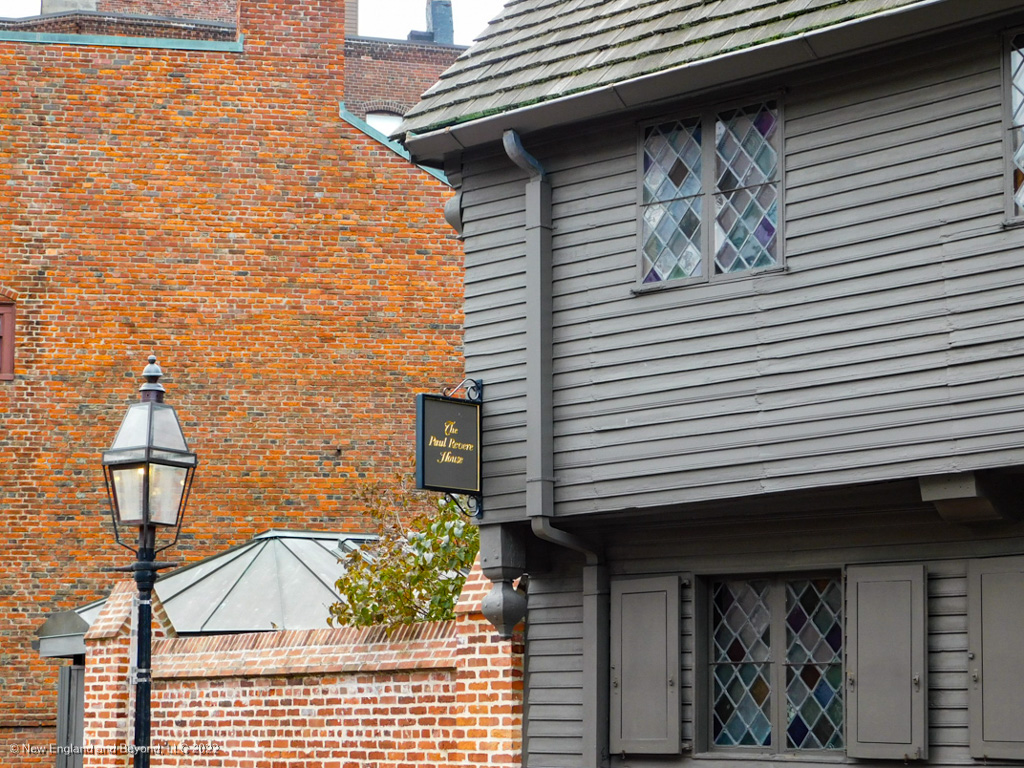
On the night of April 18, 1775, Revere left this house for his famous Midnight Ride .
Revere owned this house from 1770 until 1800. After being sold, it was used for a boarding house for sailors, an immigrant rooming house. Later it housed a variety of shops, including an Italian bank, candy store, cigar company and fruit and vegetable business.
In 1902, Revere’s great-grandson purchased the house back and renovated it. The house was opened back up as a museum in 1908 .
Tour Info: You can tour the inside of the house daily during the spring, summer and fall. Closed Mondays January-March. Admission is $6.00. There is a reduced cost for students and seniors. Children ages 5-17 can visit for the bargain price of $1.
#13: Old North Church
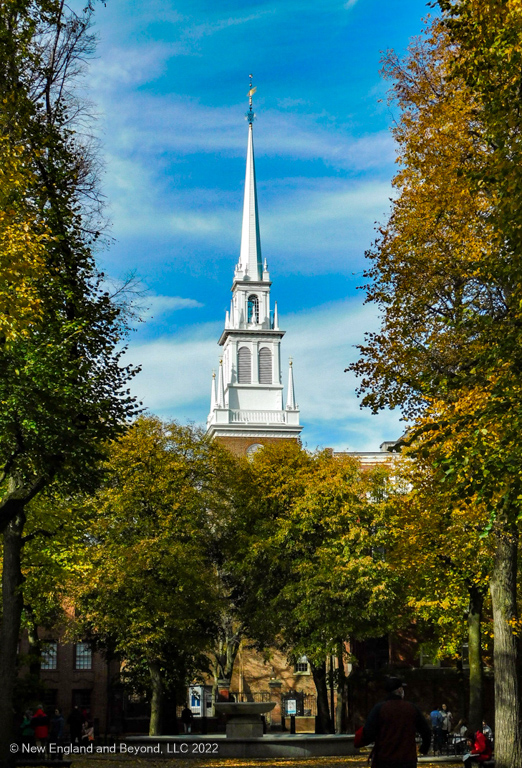
The Old North Church is Boston’s oldest church and most famous for its role it played in the start of the Revolutionary War.
On April 18, 1775, Paul Revere instructed Robert John Newman, a fellow Patriot and the church’s sexton, to hang two lanterns in the bell tower. The lanterns were to signal the Charlestown Patriots that the British soldiers were heading to Lexington and Concord by way of the Charles River.
Paul Revere then crossed the Charles by boat and set off on his famous midnight ride to warn Patriot leaders John Hancock and Samuel Adams and the people of Concord that the British were coming. Revere was ultimately captured outside of Lexington , before making it to Concord.
- While Paul Revere is the most famous rider, there were actually five riders sent out that night : Paul Revere, Samuel Prescott, Israel Bissell, William Dawes, and Sybil Ludington.
- The phrase, “ one if by land, two if by sea ” was coined from Henry Wadsworth Longfellow’s poem “ The Midnight Ride of Paul Revere ”.
- The lanterns on display in the church are only replicas. The original lanterns can be viewed at the Concord Museum .
Tour Info: The Old North Church is one of the Freedom Trail’s most visited historical sites and is open to visitors Tuesday – Saturday from 10:00 am – 5:00 pm and Sunday from 12:30 pm – 5:00 pm. Entry fee $5.00. You can tour the house, its courtyards, gardens and the gift store located in the chapel.
#14: Copp’s Hill Burying Ground
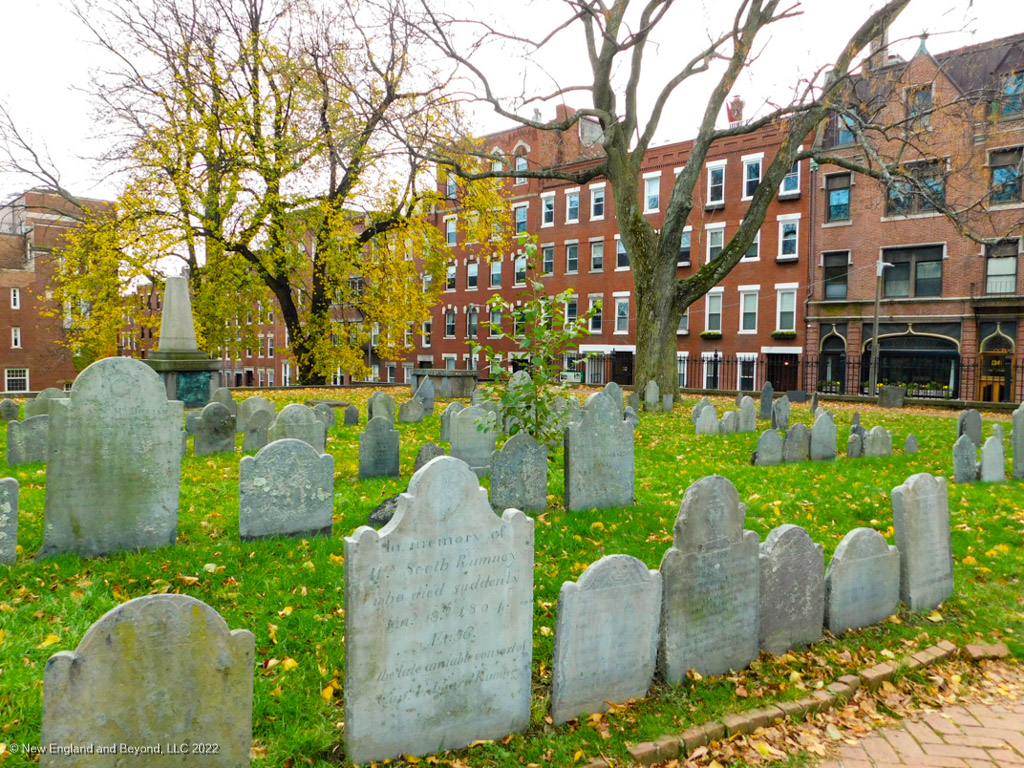
Overlooking the Harbor, just a block away from the Old North Church is the Copp’s Hill Burying Ground , the final resting place of more than 10,000 early merchants, artisans, and craftspeople.
It is believed that the British used the tombstones for target practice during the Revolutionary War while awaiting the Battle of Bunker Hill.
Across the street from the cemetery is the “ Spite House “, the skinniest house in Boston which was created out of Spite.
Insider Tip: The next site is a 20-30 minute walk across the Charlestown bridge to the Charlestown Navy Yard. Currently, there is a temporary walkway while construction of a new bridge is underway. Depending on the time, you may want to consider saving this leg of the trail for another day as there is lots to do and see at the Navy Yard. There is also a Ferry that runs from Long Wharf to the Navy Yard if you prefer not to walk.
#15: USS Constitution
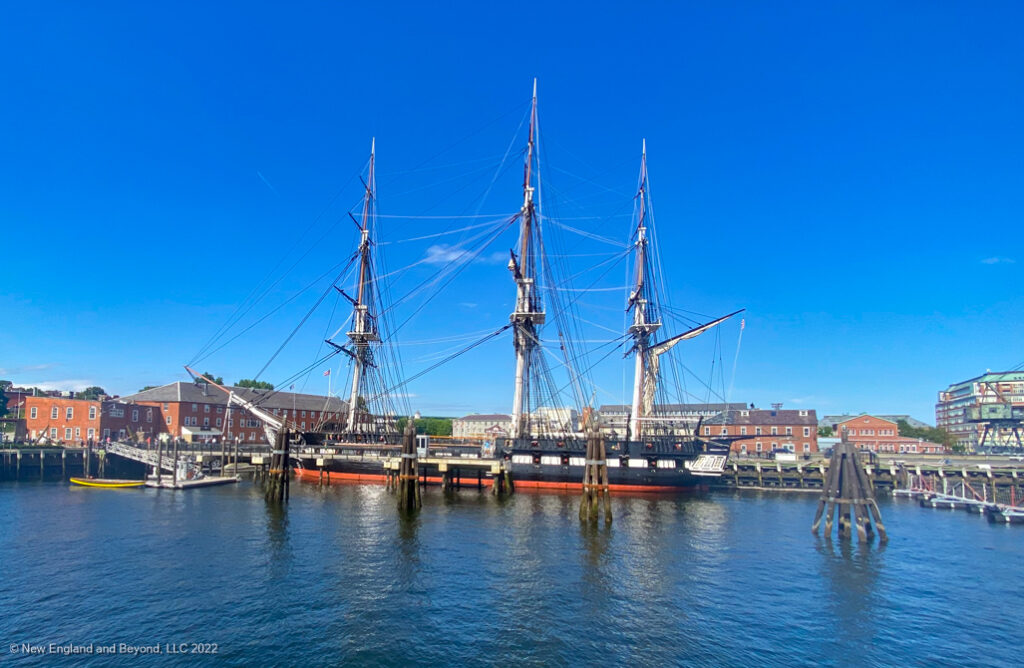
As you enter the Charlestown Navy Yard you will be welcomed by the USS Constitution , the world’s oldest commissioned warship still afloat . This magnificent 204 foot-long wood-hulled ship, known as “Old Ironside” was one of six ships commissioned by George Washington in 1794.
The ship was built at Hartt’s shipyard, right in the North End. After two failed attempts, the ship finally launched into Boston Harbor on October 21, 1797.
The historic 18th century frigate served as a warship in the War of 1812 , fighting in several battles. During the Civil War, the US Naval Academy used the ship for training and the ship was retired in 1881. Old Ironsides has been docked at the Navy Yard since 1897 and in 1907 was designated as a museum.
- The ship earned its nickname “ Old Ironsides ” when sailors noticed several cannonballs bouncing off the ship’s side during a battle with a British ship.
- In 1830, the historic frigate was slated to be demolished as it was no longer seaworthy. Upon learning about the ship’s fate, Oliver Wendell Holmes wrote the poem “Old Ironsides ” which rallied the public to petition against its demise.
- Each 4th of July , the ship makes her annual turn-around cruise in Boston Harbor , where she will sail to Fort Independence on Castle Island, give a 21-gun salute and then turn around and go home to the Navy Yard. A lottery is held and 150 lucky people and a guest get to take the ride.
Tour Info: Visitors are welcome to tour the first 3 floors of the ship throughout the year Friday – Sunday, 10:00 am – 6:00 pm. Across from the Constitution is the USS Cassin Young , a 374 foot navy destroyer which you can also explore. Admission to the Constitution and USS Cassin Young is free.
All visitors must pass through a security check and anyone 18 and older must present a valid government issued photo ID. Wheelchairs, walkers, scooters, and strollers are not allowed on board.
Be sure to stop into the Constitution Museum as it does a great job telling the history of the Constitution through its exhibits and interactive activities and is well worth the visit. There is a voluntary suggested entrance fee of $5-15.
#16: Bunker Hill Monument

The last stop on the Freedom Trail is the Bunker Hill Monument which is a 10-15 minute walk from the Charlestown Navy Yard.
Located on Breed’s Hill, a 221 foot granite obelisk stands to commemorate “ The Battle of Bunker Hill ” which was fought on the site on June 17, 1775. Although commonly referred to as the Battle of Bunker Hill, most of the fighting really occurred on Breed’s Hill.
This battle is considered one of the bloodiest battles of the American Revolution. The Patriots were able to hold back the British through two battles while killing or wounding half of the 2200 Redcoats in less than two hours of fighting. The Patriots finally succumbed and surrendered after running out of ammunition. While the battle was lost, the Patriots gained a well-needed morale victory.
Construction of the monument first started in 1827 but it was not completed until 1842. The statue in front of the obelisk of Colonel William Prescott , was erected in 1881. Prescott is known for the famous saying “ Don’t fire until you see the whites of their eyes .”
The monument has 294 steps with an observation deck at the top where you can enjoy stunning views of Cambridge and Boston.
The Bunker Hill Monument is open to climb again following Covid-19. Only 20 people are allowed in the Monument at a time and the last climb is 30 minutes before closing. Visit the National Park Service for Bunker Hill Monument and Museum hours . Due to renovations, there may be potential unexpected closures through the end of 2023.
Don’t forget to stop by the Bunker Hill Museum across the street.
Insider Tip: Consider walking the Freedom Trail backwards, starting at Stop 16 – Bunker Hill. This will get the long walking stretch out of the way early when you are not so tired. If the monument is open, you can also climb the to the top. If you complete the entire trail you will end up at the Boston Common and Boston Public Garden where you can relax.
The Bottom Line
The Boston Freedom Trail is one of the best ways to explore Boston and learn about its history. There are so many ways to experience it. Take one of the many tours or explore on your own. No matter what you choose, you are sure to enjoy learning about the history of this incredible city.
If you have time, take a tour or visit the museums along the Freedom Trail .
- The Old South Meeting House and Old State House both have museums open to the public. Tickets are available through Revolutionary Spaces $15 to visit both The Old State House (206 Washington St.) and Old South Meeting House (310 Washington St.).
- Faneuil Hall Visitor Center has museums on several floors and all are Free
- Paul Revere House – Walk through the house to see life in 1770’s – $6.00
- Constitution Museum – Learn all about Old Ironsides through interactive exhibits – Donation suggested
- Bunker Hill Museum – Learn about the Battle of Bunker Hill and the monument – Free
Visit the National Park Service for the latest information on site schedules and closures.
Explore More…
Ultimate Guide to Boston for First Time Visitors
Ultimate Guide to Getting Around Boston
Which New England State is Best to Visit?
Leave a Reply Cancel reply
Your email address will not be published. Required fields are marked *
This site uses Akismet to reduce spam. Learn how your comment data is processed .
Travel Guides
- Ultimate New England Travel Guide
Recent Posts
- Best Things To Do in Newport RI in the Springtime
- Amazing Ideas for a Girls Weekend in New England
- Guide to the Reenactments of the Battles of Lexington and Concord
- Why You Need to Visit Castle Hill on the Crane Estate
- Discover the Best Things To Do in Ipswich, MA
- I agree to receive emails from New England and Beyond, LLC
- New England
- Connecticut
- Massachusetts
- New Hampshire
- Rhode Island
Stay Connected:
Useful Links
- About New England and Beyond!
- Privacy Policy
- Terms of Use
- Back to Home

Get Inspired to Explore More!
- I agree to receiving emails from New England and Beyond, LLC

The Freedom Trail In Boston: Everything You Need to Know From A Local
Table of Contents
Hi everyone and happy September! It’s currently Labor Day weekend and I spent today exploring my home city, Boston, with my Dad! I’ve lived outside of Boston my entire life and have walked along the famous red bricks aka the Freedom Trail, countless times, but have never actually walked the entire trail start to finish. Today I was determined to do that. Whether you’re a Boston local or not, I recommend everyone walks the Freedom Trail at least once! If you do decide to walk the Freedom Trail, here’s everything you need to know from a local!
Disclaimer: This blog post is sponsored by AmazingCo! AmazingCo is an Australian-based company that creates unique and super fun experiences that brings people closer to together. They’re known for their Mystery Picnic packages, which my family got to enjoy together in the Boston area. As always, all opinions stated below are my own.
This post contains affiliate links. If you click and book through any of these links, I will earn a small commission at no additional cost to you. Thank you so much for reading and supporting my little corner of the internet!
Before You Begin…
Before we begin, here are some basic Freedom Trail facts. First, what is the Freedom Trail? The Freedom Trail is a 2.5 mile long (it’s actually more like 3.5 miles) path through downtown Boston, Massachusetts that passes by 16 significant Revolutionary War sites. It’s marked by a winding red brick path that passes through downtown Boston, the North End, and Charlestown. The trail begins at the Visitor’s Center in the Boston Common and ends at the Bunker Hill Monument in Charlestown.

I recommend beginning at the Boston Common Visitor’s Center, located at 139 Tremont St, Boston, MA 02111. Here you can purchase a map and begin the official trail. And no, maps aren’t free. This building is also where most tours begin, including my BRAND NEW Airbnb tour!
As an Airbnb Experience host, I’ll be bringing groups on a walking tour along the Freedom Trail ! The tour is about 3.5 hours long and covers 3 miles. We will begin at the Boston Common Visitors Center and end near the Old North Church. If you’re interested in booking my Freedom Trail History & Photo Tour , you can find more information here .
Here’s our route:

Freedom Trail Stops #1 & #2: Boston Common & State House
From the Visitor’s Center make your way through the historic Boston Common, America’s oldest public park, to the Massachusetts State House. This has been the seat of the Massachusetts government since its opening in 1798.

Freedom Trail Stop #3: Park Street Church
The next stop is Park Street Church, which sits at the corner of Tremont and Park Street. This church was founded in 1809 and was originally the site of Boston’s public grain storage, or granary. This leads us to the next stop, the Granary Burying Ground.

Freedom Trail Stop #4: Granary Burying Ground
This burying ground was established in 1660 and houses some of America’s most notable revolutionists, including Paul Revere, Samuel Adams, and John Hancock.

Freedom Trail Stop #5: King’s Chapel & Burying Ground
Across the street is King’s Chapel, Boston’s first Anglican church, and another burying ground. This burying ground is the oldest English one in the city. It’s full of graves from Mayflower voyagers, including the first woman who was believed to step off the ship.

Freedom Trail Stop #6: Boston Latin School & Benjamin Franklin Statue
Next, walk down School Street to the site of the Old Boston Latin School, the first public school in the United States! This school offered free education to boys, and is well-known for having Benjamin Franklin, John Hancock, and Samuel Adams as students. The Benjamin Franklin statue and Old City Hall can be found here.

Freedom Trail Stop #7: Old Corner Bookstore
Further down this road you’ll hit the Old Corner Bookstore. It’s now a Chipotle.

Freedom Trail Stop #8: Old South Meeting House
Across the street you’ll find the Old South Meeting House. Once a church, the tea tax debates occurred here in 1700s. This building gained fame for being the organizing point for the Boston Tea Party on December 16, 1773.
Pro-tip: Don’t want to tour the entire Freedom Trail? This duel ticket will give you access to Boston’s Old State House and the Old South Meeting House museums.

Freedom Trail Stops #9 & #10: Old State House & Boston Massacre
From here, walk down Washington Street to the Old State House ! This site is famous for two main reasons. First, this building is the oldest surviving public building in Boston. It’s also where the Declaration of Independence was first read off the balcony. Second, this is the site of the Boston Massacre, which occurred on March 5, 1770. Five Bostonians lost their lives as they fought for their freedom against the British Redcoats.

Freedom Trail Stop #11: Faneuil Hall
Next up is Faneuil Hall! Walk down Congress Street until you hit this historic, tourist hotspot. Faneuil Hall once hosted America’s first town hall meeting and is known for being the “Home of Free Speech”. Today, Faneuil Hall Marketplace comprises of the building itself, Quincy Market, North Market, and South Market. These buildings are full of restaurants and shops. I recommend strolling through Quincy Market and eating at one of the many food stalls located here!
Pro-tip: Don’t want to walk the entire Freedom Trail? You can also visit Faneuil Hall on Boston’s Hop-On, Hop-Off Trolley .

Continue along the red brick path as you make your way into the North End! I was most excited for the second portion of the Freedom Trail since it covers the North End and Charlestown, two of the lesser explored areas for me. As a local, I’m in downtown Boston often, but never really these places. Faneuil Hall marks about halfway along the trail (about 1.5 miles done). There are less sites in the second half and they’re more spread out.
Let’s do the last mile or so, shall we!
Once you arrive in the North End you’ll walk down Hanover Street. This is the hub of the neighborhood and where you’ll find the best Italian restaurants and bakeries. My personal favorite is Mike’s Pastry . If you like cannolis, grab one here!
Walking the Freedom Trail and grabbing a bite to eat in the North End is one of the top things to do in Boston during the summer months.
Freedom Trail Stop #12: Paul Revere House
You’ll want to turn onto Richmond Street to see the Paul Revere House at North Square. As the name suggests, this home was owned by Revere from 1770-1800 and is the oldest remaining structure in downtown Boston! You can pay to enter the home and museum if you wish.

Freedom Trail Stop #13: Old North Church
Further down Hanover Street you’ll hit the Paul Revere Mall and Statue. This was my first time here and I enjoyed walking around! At the end of the mall is the Old North Church. Built in 1732, this is Boston’s oldest church! This is also the site that launched Boston into the Revolutionary War. It’s in this bell tower that lanterns signaled that the British were coming, marking the start of Paul Revere’s march to Lexington/Concord for the battle.

Freedom Trail Stop #14: Copp’s Hill Burying Ground
The last stop in the North End is Copp’s Hill Burying Ground. From here, you’ll walk over the North Washington Street Bridge into Charlestown! The Freedom Trail splits here in two directions, forming a loop, so you can choose whether you’d like to see Bunker Hill Monument or the USS Constitution first. We did Bunker Hil.

Freedom Trail Stop #15: Bunker Hill Monument
Bunker Hill is a scenic hilltop in Charlestown providing views of the Boston skyline, and the site of the Bunker Hill Monument. This monument commemorates the Battle of Bunker Hill which occurred on June 15, 1775. This was the first major battle of the Revolutionary War.

Freedom Trail Stop #16: USS Constitution
From Bunker Hill we walked a short way to the Charlestown Naval Yard where we saw the USS Constitution. This ship is the oldest commissioned warship afloat in the WORLD! Pretty cool. There is also a museum here, and you can walk onboard the ship!

This marks the end of the Freedom Trail! The brick walkway claims to be 2.5 miles, but I ended up walking over 4 miles. Either way, this is a GREAT way to see the city of Boston and to learn a lot about the Revolutionary War in a short period of time. I didn’t actually go inside any buildings – to do this, you’ll have to pay. The entire trail took me about 2.5 hours to complete. If I visited some of the buildings, it would probably take 4 hours.
Pro-tip: Thirsty? Head to the Anchor Bar for a drink to celebrate the end of the Freedom Trail! This outdoor bar is super trendy (they have swings and bean bag chairs trendy) and the best frose!

About AmazingCo
As mentioned above, the sponsor of this post is AmazingCo , an Australian-based lifestyle and events company that specializes in experiences around the world. They’re best known for their Mystery Picnic packages which can be enjoyed in Boston, along with cities such as Austin, Chicago, Las Vegas, Orlando, Portland, San Diego, and Seattle! Each picnic experience lasts for about 3-4 hours and requires light walking.
Aside from enjoying tasty local food, AmazingCo will provide you with facts and tips about the city you’re exploring, so you can learn on the go! Each picnic starts by solving personally curated clues and riddles that will take you on a journey to collect your special gourmet picnic food bit by bit. Each clue you solve will lead you closer to your next picnic food pickup and even closer to your final stunning picnic location. My family and I enjoyed a cheese board, salads, sandwiches, and cookies on our Mystery Picnic and had a blast getting to know the area more! I highly recommend you check out AmazingCo for yourself and book an experience for your next date night or family day. Thank you to AmazingCo for sponsoring this blog post!

Want more New England content? Check out my Ultimate New England Bucket List !
Like this post? Pin it to save it for later and share with others!

You may also enjoy:
How to spend one day in rome, 15 most instagrammable places in boston, adjusting to study abroad in australia (& blue mountains visit), alaska cruising guide: everything you need to know about the …, leave a reply.
Your email address will not be published. Required fields are marked *
Where I’ve Been In The World

Where I’ve Been In The USA

Looking for Something?
- Top Stories
- Photo Reprints
- Express Login
- Email Updates
- Turn off Notifications
- Capitol Report
- Announcements
- Today in History
- Red Zone Hall of Fame
- Hit the Paws Button
- Columns and Op-eds
- Matter Of Laugh Or Death
- Reflections
- What’s for Dinner
- Open Houses
- Dining Guide
- Newspaper Ads
Special Sections
- Social Marketplace
- Merchandise
- Pets & Animals
- Real Estate for Rent
- Real Estate for Sale
- Transportation – Autos
- Rec Vehicles
- E-Edition Log In
- Subscriber Verification
- Citizens News
- Beatles vs Stones
- Advertising
- Newspaper Delivery
- Your Internet History
- Terms of Use
- Commenting Rules
- Vacation Stop
- Letters to the Editor
- Editorial and Opinion
- News Article
- Sports Department
- Website Issues
- Home Delivery Subscription
- Activate Access
- Purchase a Digital Subscription
- Single-Day Access
- Digital Sub Account Info

Service for Waterbury’s third stop on the Connecticut Freedom Trail to be held Tuesday

WATERBURY — The next stop on the Connecticut Freedom Trail will be on the front lawn of Silas Bronson Library. A service will be at 5:30 p.m. Tuesday in front…
SUBSCRIPTION REQUIRED
REGISTER to access your 5 FREE ARTICLES a week.
ACTIVATE Home Delivery Access
PURCHASE a Digital subscription
Connect With
Username or Email Address
Remember Me
Register | Lost your password?
Purchase a Subscription and Register
- Repeat Password *
- I allow the website to collect and store the data I submit through this form. *
Processing. Please wait…

Latest News
- All time popular
New law requires all Louisiana public school classrooms to display the...
Police credit new yorkers for suspect’s arrest in the rape of..., survivors of new hampshire motorcycle crash that killed 7 urge a..., scorching temperatures, humidity making life miserable for millions from midwest to..., climate protesters arrested over spraying orange paint on stonehenge monument, chamber business directory 2023, homestyle spring 2024, town guide 2022, celebrating downtown 2023, summer almanac 2022.
- Community News
- Barkhamsted CT
- Beacon Falls CT
- Bethlehem CT
- Bridgewater CT
- Burlington CT
- Cheshire CT
- Colebrook CT
- Cornwall CT
- Falls Village CT
- Harwinton CT
- Litchfield CT
- Middlebury CT
- Naugatuck CT
- New Britain CT
- New Hartford CT
- New Milford CT
- Plymouth CT
- Prospect CT
- Salisbury CT
- Simsbury CT
- Southbury CT
- Southington CT
- Terryville CT
- Thomaston CT
- Torrington CT
- Washington CT
- Waterbury CT
- Watertown CT
- Woodbury CT
Huzzah! Due to the Celtics' champions parade on Friday, June 21, the Foundation's Freedom Trail Tours at 10 am, 11 am and 12 pm will depart from the ArtsBoston Booth at Faneuil Hall. Select historic sites will be closed, including Granary and King's Burying Grounds and King's Chapel.
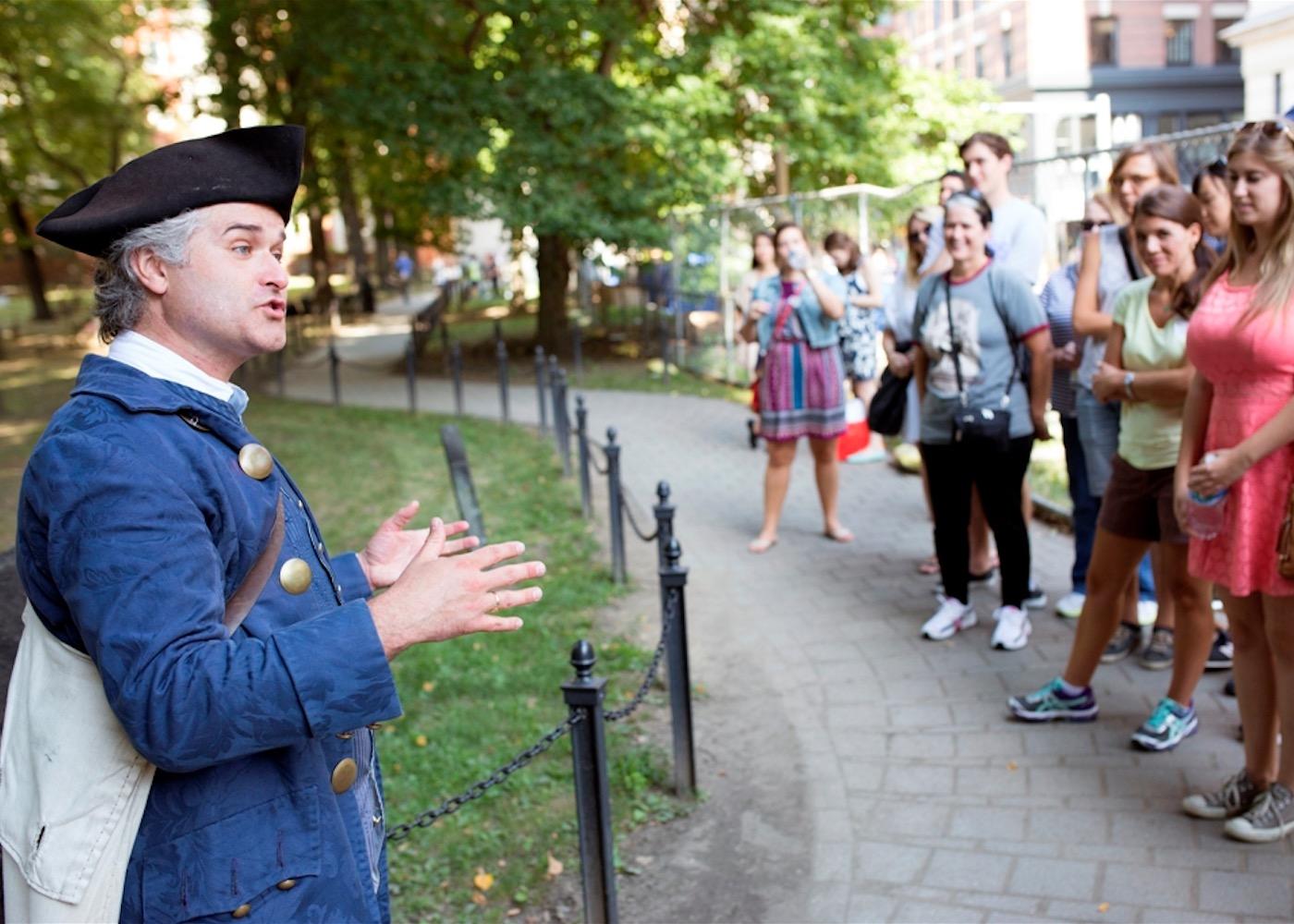
Walk Into History®
Boston Common Visitor Information Center 139 Tremont Street Boston, MA 02111
Daily, 10 am, 11 am, 12 noon, 1 pm & 2 pm (plus 3 pm Sat. & Sun.) ( Starting July 1, plus 3pm & 4pm, Daily and 4:30 pm, Fridays - Sundays) Purchase Tickets
About This Tour
Boston's official Freedom Trail tours! The Freedom Trail Foundation's most popular, introductory, tours highlight the diverse history that took place at 11 of the 16 official Freedom Trail historic sites, featuring Boston Common, Massachusetts State House, Park Street Church, Granary Burying Ground, King's Chapel & King's Chapel Burying Ground, Boston Latin School site/Benjamin Franklin statue, Old Corner Bookstore, Old South Meeting House, Old State House, Boston Massacre site, and Faneuil Hall. Experience stories of the American Revolution, as well as the history of traditionally underrepresented peoples spanning from the 16 th – 21 st centuries.
*Boston Town Crier Tours - Endorsed by the Freedom Trail Foundation, however Foundation-led tour tickets are not valid to use on Boston Town Crier-led tours.
Group Tour Information
School, private, or corporate groups may request specific tour dates and departure times here or by calling (617) 357-8300.
General Information
Chair rental, public transit, what people are saying, yelp review.
The Freedom Trail is one of the iconic touristy things to do in Boston, and there's a reason for that. I did the full trail many, many years ago but decided to go with this shorter, more compact trail with our family. The 1.5 hour length is the right duration for kids, and our guide, Jeremiah Poope (his actual last name!), kept it interesting the entire time. He has been a tour guide in Boston for many years, and he had a ton of interesting stories and facts beyond the typical revolutionary war factoids.
The Freedom Trail Walking tour presents full of historic knowledge and our guide, Parker, provides us the best experience for this amazing learning adventure. That is to say, in this tour you can also learn about the myth and the truth of the history we learned from our textbooks. I would recommend anyone who visit Boston and is interested in learning history or simply just want to listen to funny stories
TripAdvisor Review
We only had 1 day to explore downtown Boston, and this tour was a great way to see several different sites, learn about history, and get a bit of walking in. We were a few minutes late for the start of the 1pm tour but easily able to catch up and join in.. Our tour guide was fantastic! One member of my group uses a wheelchair, and the guide was great about leading the WHOLE tour through accessible entrances to sites and to sidewalks with curb cuts so that all of us could participate without feeling singled out.
Email Review
We had a wonderful time and your guides were wonderful. They were energetic, informed, and brought history to life. Thank you once again!
Great tour with Isaiah Thomas! Great local guide who was very engaging and a walking encyclopedia of Boston history. It was a nice 1.5 hr walking tour hitting most of the south end Freedom Trail points of interest. For the money, it’s hard to beat!
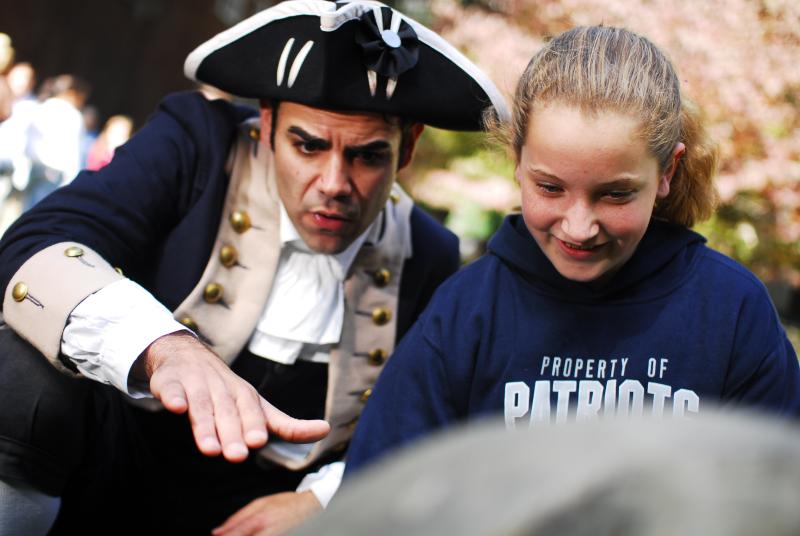
Freedom Trail Store
The Freedom Trail store offers tour ticket discounts, books, such as the Freedom Trail Walking Guide and A Kid's Guide to the Freedom Trail, in addition to other student-friendly and grown-up intriguing books, audio guides, and other Freedom Trail related items.
Hot Rod Power Tour 2024 is here and visiting two Kentucky cities. What to know about the routes

The Hot Rod Power Tour, a long-standing national traveling car show featuring over 6,000 custom vehicles for its 30th year, is making two stops in Kentucky this week as part of a five-city cruise. Here's what we know about the events and driving routes.
Hot Rod Power Tour 2024 Hot Rod Power Tour is coming to two Kentucky cities. What to know about schedule, route, tickets
2024 Hot Rod Power Tour stops in 5 cities in Kentucky, Indiana, Ohio, Tennessee
The Hot Rod Power Tour is visiting five cities this week:
- Monday, June 10: Beech Bend Raceway Park near Bowling Green.
- Tuesday, June 11: Nashville Superspeedway in Lebanon, Tennessee.
- Wednesday, June 12: L&N Federal Credit Union Stadium in Louisville.
- Thursday, June 13: National Trail Raceway in Hebron, Ohio.
- Friday, June 14: Lucas Oil Indianapolis Raceway Park in Indianapolis, Indiana.
Hot Rod Power Tour route from Bowling Green to Nashville Superspeedway
The tour is passing through Rockfield, Orlinda, Springfield and more before reaching the Nashville Superspeedway on Tuesday.
Hot Rod Power Tour route from Tennessee to Louisville
The Hot Rod tour is passing through Scottsville, Munfordville, Elizabethtown and more before reaching L&N Federal Credit Union Stadium in Louisville on Wednesday.
Hot Rod Power Tour travels from Louisville to National Trail Raceway
The Hot Rod Power Tour will travel through LaGrange, Florence, Obetz, Ohio and more before reaching the National Trail Raceway on Thursday.
Hot Rod Power Tour route from Ohio to Indianapolis
The 2024 Hot Rod Power Tour will pass through Springfield, Ohio, Cambridge City, Indiana; Knightstown, Indiana and more before reaching the Lucas Oil Indianapolis Raceway Park Friday.
From Florence to the Beaches of Nice: How to Watch the 2024 Tour de France
This year’s edition starts in Italy and features one of the toughest opening stages ever, a 206-kilometer ride from Florence to Rimini taking riders through the heart of the Apennine mountains.

Gear-obsessed editors choose every product we review. We may earn commission if you buy from a link. How we test gear.
How to Watch the Tour de France in the U.S.
How to watch the tour de france in canada, what happened last year, riders to watch, tour de france history.
The Tour de France was first raced in 1903 when journalist (and former bike racer) Henri Desgrange organized the event to promote L’Auto-Vélo, a French sporting newspaper that he edited–and is known today as L’Equipe. The newspaper was actually printed on yellow paper, which fuels one of the narratives surrounding the origins of the maillot jaune . That year’s Tour covered 2,428 km (1,509 mi) spread over just six stages–the average stage length was about 405 km (251 mi)–and only 21 of the original 60 starters finished the inaugural event.
Despite the low number of finishers, the event was an overwhelming success, and the Tour has since become one of the largest sporting events in the world, an event for which teams with multi-million dollar budgets spend years trying to win. For the riders, just a single stage win or day in the yellow jersey is a career-defining achievement. Riders who win the overall title–even just once–go down in history.
This year’s race covers 3,492 km (2,165 mi) spread over 21 stages, with eight days for the sprinters, two individual time trials, seven mountain stages, and about four stages for the punchy opportunists who head up the road in search of “do-or-die” breakaway stage victories–we love those guys.
Here’s everything you need to know about the 2024 Tour de France:

The route of the 2024 Tour de France is unlike any we’ve ever seen, mainly because it’s bookended by two of the biggest “firsts” in the event’s 110-year history: it’s the first to begin in Italy and the first to end outside of Paris (in Nice).
The Tour begins in Florence on Saturday, June 29th, the first of three-and-a-half stages in Italy. And we’re expecting fireworks right away: Stages 1 and 2 are two of the toughest opening stages we’ve ever seen, even harder than the opening stages of last year’s Tour, which took place in the hilly Basque region of northern Spain.
After a day for the sprinters on Stage 3, Stage 4 begins in Pinerolo and brings the race back into France via the 2,642m Col du Galibier. The second-highest climb in this year’s race, the first rider to the summit will win a cash prize given each year in honor of Degrange. By the end of one of the earliest mountain stages in Tour history, the GC battle will be in full swing.
The sprinters will then get two more chances as the race heads north. But the GC battle will resume on Friday, July 5th, with Stage 7, the first of two individual time trials in this year’s Tour. The first week ends with Sunday’s Stage 9, an exciting stage featuring 14 sections of white gravel roads through France’s Champagne region. This will be the first gravel stage in the history of the men’s Tour de France–the women completed a gravel stage of their own through the region in 2022.
After the Tour’s first Rest Day, the race resumes on Tuesday, July 9th, and begins a southwesterly trip–through the Massif Central, which hosts a rugged finish to Stage 11–toward the Pyrenees. Along the way, the sprinters will have a few more opportunities to win a stage before the high mountains return over the weekend.
And they return in a big way, with back-to-back hors categorie (“beyond category”) summit finishes in the mountains that form the border between France and Spain. Saturday’s Stage 12 takes the riders over the Tourmalet–which Desgrange first thought was too hard for the Tour de France–and ends with a finish at the Pla d'Adet ski resort, while Sunday’s Stage 13 ends on the Plateau de Beille–after almost 198km of racing.
As if the mountains aren’t enough cause for excitement, it’s also a holiday weekend: Sunday is Bastille Day–July 14th–so expect the roads on both days to be packed with “festive” fans. By the end of the day, the list of riders capable of winning the 2024 Tour de France will be much shorter than it was a week prior.
The Tour’s third and final week takes the race back east, where an Alpine finale looms. In all, the riders will spend four days in the mountains during the third week, first in the high Alps–with summit finishes at the end of Stage 17 ( at Superdévoluy) and Stage 19 (at Isola 2000). And don’t snooze on Thursday’s Stage 18, a saw-toothed stage from Gap to Barcelonnette that’s filled with short, jagged climbs and could be the perfect place for an ambush–or a Hail Mary–before the final weekend.
But this year’s final weekend is not what we’ve come to expect from Tours of the past. With the Summer Olympics beginning in Paris just five days after the end of the race, this year’s Tour skips its traditional finish on the Champs Elysees and instead finishes in Nice–after the hardest final weekend we’ve seen in decades.
The weekend opens on Saturday, July 20th, with Stage 20, a short but intense stage through the maritime Alps featuring four categorized ascents, including a summit finish on the Category 1 Col de la Couillole.
And just in case that doesn’t settle things, Sunday’s Stage 21 certainly will, as–for the first time in 35 years–the Tour de France ends with an individual time trial. And it’s a hard one: a 33.7 km race against the clock that takes the riders over the Col d'Èze, a tough Category 2 ascent that always features in the final stage of March’s Paris-Nice, an 8-day stage race that Tour contenders often use to build form during the first part of their seasons.
This might bode well for American fans–for two reasons. First, the last time the Tour de France ended with an individual time trial, American Greg Lemond defeated France’s Laurent Fignon–who entered the day wearing the yellow jersey–to win the Tour by eight seconds.
And this year’s winner of Paris-Nice–which finished with a stage over the Col d'Èze–was American Matteo Jorgenson (Visma-Lease a Bike), a 24-year-old from Idaho who took the yellow jersey on that final stage. Jorgenson will be lining up at this year’s Tour; could history repeat itself? We can’t wait to find out.
When it comes to watching the Tour de France, you’ve got lots of options. NBC’s Peacock ($5.99/month or $59.99/year) streams all events organized by A.S.O., which means you can watch the Tour de France now and then the Tour de France Femmes in August. (And if you’re looking for ad-free coverage, you’ll need a subscription to Peacock Premium Plus, which runs $11.99 per month or $119.99 for the year.)
The Peacock app is available on Roku, Apple devices, Android and AndroidTV devices, Google platforms, Chromecast, Xbox consoles, PlayStation 4 and 5 consoles, VIZIO SmartCast TVs, and LG Smart TVs. You can also watch online via the Peacock website.
If you have a good cable package and prefer conventional viewing on your television, you’re in luck: NBC will offer the race to cable subscribers via the USA Network and CNBC. Live coverage often starts around 7 a.m. EDT, so 9-to-5ers will likely need to record each stage and watch later. (Check the full schedule for details.)
If you’re in Canada, FloBikes ($29.99/month CDN) is the best way to watch the Tour de France. All 21 stages are available live and on-demand on FloBikes.com, the FloSports iOS app, and the FloSports app for Amazon FireTV, Roku, and Apple TV.
Denmark’s Jonas Vingegaard (Jumbo-Visma) won the 2023 Tour de France, defeating Slovenia’s Tadej Pogačar (UAE Team Emirates) to defend his title from 2022. The two champions engaged in a tense battle during the first two weeks of the race and entered the second Rest Day separated by just ten seconds on the Tour’s General Classification.

But Vingegaard exploded at the start of the third week, crushing Pogačar in an individual time trial on Stage 16 and then dropping him in the Alps on Stage 17. In just two stages, the Dane’s lead went from ten seconds to more than seven minutes. Pogačar saved face by winning Stage 20, but for the second year in a row, the winner of back-to-back Tours in 2020 and 2021 was forced to settle for second place–and the white jersey as the Tour’s Best Young Rider. Pogačar’s teammate, Great Britain’s Adam Yates–won Stage 1 and wore the Tour’s first yellow jersey–finished third overall.
Belgium’s Jasper Philipsen (Alpecin-Deceuninck) was without question the Tour’s best sprinter. The Belgian won four stages and ran away with the green jersey as the winner of the Tour’s Points Classification. Italy’s Giulio Ciccone (Lidl-Trek) won the polka dot jersey as the Tour’s King of the Mountains.
Jonas Vingegaard-Hansen (Visma-Lease a Bike)

At this point in time, we’re waiting to hear if Vingegaard will even be starting this year’s Tour de France. The defending champion was one of several Tour favorites taken down in a massive crash at the Tour of the Basque Country in early April. The Dane spent twelve days in the hospital after breaking several bones and suffering a punctured lung in the fall and only resumed training a few weeks ago. Visma-Lease a Bike recently said he has a 50-50 chance of starting the race, but only will do so if the team feels he’s 100% ready to challenge for a third consecutive victory.
Tadej Pogačar (UAE Team Emirates)

The uncertainty surrounding Vingegaard’s participation makes Pogačar the top favorite. The Slovenian won back-to-back Tours in 2020 and 2021 and scored back-to-back second-place finishes behind the Dane in 2022 and 2023. He’s been training since winning six stages and the General Classification at the recent Giro d’Italia and looks on track to become the first rider since Italy’s Marco Pantani (in 1998) to win the Giro-Tour double.
Primož Roglič (BORA-hansgrohe) and Remco Evenepoel (Soudal–Quick-Step)
Vingegaard wasn’t the only Tour contender who went down in that terrible crash at the Tour of the Basque Country: Slovenia’s Primož Roglič–who was leading the race at the time–and Belgium’s Remco Evenepoel were victims as well, and both riders immediately abandoned the race. Roglič injured his knee–but suffered no major injuries–but Evenepoel needed surgery after breaking his clavicle and scapula.
Unlike Vingegaard, both riders were able to get back to training relatively quickly, and they both competed at the recent Critérium du Dauphiné . Roglič won two stages and the General Classification despite almost cracking at the end of the final stage. Evenepoel won the Dauphiné’s only individual time trial, but showed he still has some room to improve after fading in the mountains. He finished the race in seventh place overall.
Carlos Rodríguez (INEOS Grenadiers)
Rodríguez, who won a stage and finished fifth in last year’s Tour de France, won the final stage and finished fourth overall at the Dauphiné, the latest in a series of high-stage race finishes for the 23-year-old. He’ll likely be joining Colombia’s Egan Bernal (who won the Tour in 2019) and Great Britain’s Geraint Thomas (Who won the Tour in 2018) on the starting line in Florence to form one of the deepest eight-rider line-ups in this year’s race.
Matteo Jorgenson (Visma-Lease a Bike)
If Vingegaard proves unable to start the Tour, don’t be surprised if Visma-Lease a Bike turns to Matteo Jorgenson to lead the team in his place. After winning Paris-Nice and Dwars door Vlaanderen in March, the American spent much of April and all of May at training camps, building form for the summer.
Well, it must’ve worked, as the 24-year-old nearly snatched the Dauphiné from Roglič after riding away with Rodríguez at the end of the final day. In the end, he lost the race by only eight seconds–another interesting coincidence given Lemond’s margin of victory at the Tour in 1989.
The American has never captained a team at the Tour de France, but he raced the French grand tour in 2022 and 2023–so he at least knows what the Tour’s pressure-cooker atmosphere feels like. And he should benefit from the presence of his teammate Sepp Kuss , the American who shockingly won last year’s Vuelta a España and played a pivotal role in each of the six grand Tours won by the team prior to his own victory at the Vuelta last September.

.css-1t6om3g:before{width:1.75rem;height:1.75rem;margin:0 0.625rem -0.125rem 0;content:'';display:inline-block;-webkit-background-size:1.25rem;background-size:1.25rem;background-color:#F8D811;color:#000;background-repeat:no-repeat;-webkit-background-position:center;background-position:center;}.loaded .css-1t6om3g:before{background-image:url(/_assets/design-tokens/bicycling/static/images/chevron-design-element.c42d609.svg);} Tour de France

Tom Pidcock’s Tour de France Plans

Can Cavendish Win a 35th Tour de France Stage?

Pidcock to Race Crans-Montana XCO Ahead of Tour

Vingegaard Hits Mallorca for Tour de France Prep

Van der Poel Opts Out of Olympic Mountain Biking

Vingegaard Still May Not Be Tour de France Ready

The Kings and Queens of Cycling’s Iconic Climbs
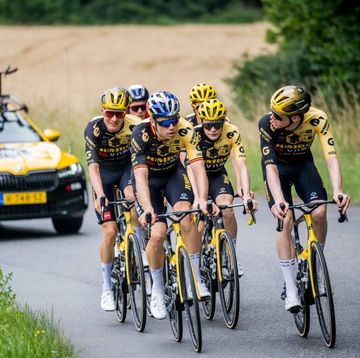
How Pros Tackle Recovery During Tour de France

The Fastest Men and Women of the Grand Tours

What Do Riders Eat During the Tour de France?

How Fast Do the Pros Ride in the Tour de France?

What to expect on the General Election campaign trail on Thursday
Here is your guide to the main developments in the General Election campaign on Thursday:
– Follow the leaders
York is the latest stop on the televised General Election debate tour for four of the party leaders.
The BBC Question Time special will run between 8pm and 10pm and see each leader appear one by one to face questions from the audience.
Prime Minister Rishi Sunak will appear for the Conservatives, Sir Keir Starmer for Labour, Scotland’s First Minister John Swinney for the SNP and Sir Ed Davey for the Liberal Democrats.
But there is no spot for Reform UK’s Nigel Farage, who previously demanded a place given his party’s strong showing in the opinion polls.
The BBC responded by insisting Mr Farage and Reform have received coverage across BBC outlets, adding: “The Ofcom guidance gives ‘greater weight on the actual performance of a political party in elections over opinion poll data’ taking into account the ‘greater uncertainty associated with support in opinion polls’.”
The BBC later confirmed an additional Question Time Leaders’ Special, featuring representatives from Reform UK and the Green Party, will be broadcast on June 28.
Mr Farage is expected to hit the campaign trail elsewhere on Thursday.
– Home is where the heart is
Ahead of the BBC leaders’ special, housing policy is the focus of the day for the Conservatives and Labour.
Outgoing Communities Secretary Michael Gove, who is not standing for re-election, is leading the attack on Labour’s approach to the issue.
The Tories claim that Labour not matching their commitments will amount to a “first-time buyer tax” for those trying to get on the property ladder.
Labour countered by saying: “This reeks of desperation from the Tories.”
The party added that it intends to “get Britain building” and help working families onto the housing ladder.
Separately, Labour pledged that renters will be “better off” as they intend to ban so-called no-fault evictions, seek to end rental bidding wars and put in place other protections.
The Renters Reform Bill was making its way through Parliament but then someone – Mr Sunak – called a General Election and it failed to progress. The Tories want to revive the Bill if they continue in government.
– It’s all gone to pot
Some might suggest elements of the Lib Dems’ campaigning efforts have been a little bit potty given the number of stunts undertaken by leader Sir Ed.
But the party switches its attention to the “pothole postcode lottery”, as they insist £300 million should be spent over the next parliament to fill 1.2 million potholes a year.
Will Sir Ed be seen wearing an astronaut outfit as he pretends a pothole is akin to a crater on the moon? It is not possible to rule anything out at this stage given wheelbarrow racing and rollercoasters are among the things to already feature on the campaign trail.
– A green future?
The Scottish Greens will propose a “transformative vision” to deliver a green economy when they launch their 54-page manifesto in Edinburgh.
Co-leader Lorna Slater said she plans to send “shockwaves” through politics by securing a record Scottish Green vote at the General Election.
Meanwhile, the Scottish Conservatives will tell farmers that they will be “on their side”, as the party sets out its rural General Election manifesto at the Royal Highland Show in Edinburgh.
Rachael Hamilton, the party’s rural affairs spokeswoman, said the sector has been “shamefully neglected” by the Scottish Government.


IMAGES
VIDEO
COMMENTS
Due to the Celtics' champions parade on Friday, June 21, the Foundation's Freedom Trail Tours at 10 am, 11 am and 12 pm will depart from the ArtsBoston Booth at Faneuil Hall. Select historic sites will be closed, including Granary and King's Burying Grounds and King's Chapel. Click To Open.
Welcome to Boston's Freedom Trail, a 2.5-mile, red-lined route that leads to 16 historically significant sites — each one an authentic treasure. Explore museums and meetinghouses, churches, burying grounds and more. Learn about the brave people who shaped our nation. Experience over 250 years of history, and discover the rich history of the.
Freedom Trail Map and Self Guided Tour. The Freedom Trail at the center of historic Boston is a red brick path through the city leading visitors to many of the city's historic sites. This self-guided tour and map will cover the entire 2.5 miles (4 km) and 16 Freedom Trail stops.
Experience the Freedom Trail Now (Visitor Resource) Access Information. Directions & Parking. Maps . Foreign Language - Resources. Sample Itineraries & Resources. Hotel Packages. ... Freedom Trail Tour App. Tour Start. Boston Common Visitor Information Center 139 Tremont Street Boston, MA 02111. Directions. Schedule. Any time! Duration. 120 ...
Freedom Trail Stop 16: Bunker Hill Monument. The Freedom Trail stops at Bunker Hill Monument. How poetic is it that the Freedom Trail ends where the Revolutionary War began. The Battle of Bunker Hill on June 17th, 1775 was the first major battle of the Revolutionary War. Although the British ultimately won the battle, it came at a hefty price.
Walk the Freedom Trail. Boston National Historical Park. Originally conceptualized in the 1950s, the Freedom Trail ® is an iconic symbol of Boston. Its red brick line snakes through some of the oldest parts of the City, navigating visitors to some of the most significant historic sites in the Downtown, North End, and Charlestown neighborhoods ...
Tour of the Freedom Trail. Boston Common Visitor Center. (978) 741-1170. Tour of the Freedom Trail by The Histrionic Academy offers walking tours of Boston and the freedom trail using costumed historical interpreters as guides. These historians/tour guides are available for both public and private events.
Maximum tour attendees permitted: 16; If you are looking for a tour that covers the entire Freedom Trail, this is it! This is the most comprehensive tour of the Freedom Trail you will find and includes all stops, including actually visiting Bunker Hill and the USS Constitution. The Freedom Trail connects sixteen locations in historic Boston.
The last four stops, from Old North Church to Bunker Hill, comprise the final 1.5 miles of the trail. It's free to walk the Freedom Trail, but some sites have entry fees to go inside. If you paid for admission for all of the ticketed attractions on the Freedom Trail, it would cost $34-$39 per adult.
See below for a step-by-step guide to the Freedom Trail's 16 stops, as well as our additional bonus stops for treats, photo ops, and more! Enjoy! ... Your tour culminates at the Bunker Hill Monument, erected in 1825 to commemorate the American Revolution's Battle of Bunker Hill, fought June 17, 1775.
The 2.5 mile red-brick tour of the Freedom Trail follows along the streets of Boston and is packed with historical landmarks, sites, and burial grounds of famous Revolutionary War Patriots. There are seventeen major landmarks on the Freedom Trail that can take an entire day to traverse by foot depending upon your speed and the size of your ...
Aubrey Higgins 2021-05-27. Table of Contents. Follow us along all 16 stops on Boston's Freedom Trail, a 2.5 mile (4 km) red brick trail through Boston's historic neighborhoods, beginning with Boston Commons in downtown Boston and ending with Bunker Hill Monument in Charlestown. Founded in 1951, the trail tells the story of the American ...
View Highlights. Stroll the Freedom Trail's ancient streets, past historic cemeteries and colonial stone houses, and hear tales of rebellion, war, and a nation's independence. It's the epic story of Boston's rise and America's birth. Excellent Free Tours by Foot Walking Tours 4.7 ★ ★ ★ ★ ☆ Based on 212 reviews from See all reviews ...
Where Does the Freedom Trail Start. The start of the Freedom Trail is Boston Common. The length of the trail is 2.5 miles (4.0 km) and takes about 90 minutes to complete, but if you want to visit the sites along the way, it can be a whole day affair. The end of the trail is at the USS Constitution Museum.
Due to the Celtics' champions parade on Friday, June 21, the Foundation's Freedom Trail Tours at 10 am, 11 am and 12 pm will depart from the ArtsBoston Booth at Faneuil Hall. Select historic sites will be closed, including Granary and King's Burying Grounds and King's Chapel. Click To Open. Main menu.
First Stop on the Freedom Trail: Boston Common. Massachusetts State House. Park Street Church. Granary Burying Ground. King's Chapel. Boston's Latin School & Ben Franklin's Statue. Old Corner Bookstore. Old South Meeting House. Old State House.
Travel 5 must-see stops on Boston's Freedom Trail, according to a local guide There are 16 historic spots on the 2 ½-mile trail. The USS Constitution in Charlestown, part of the Freedom Trail.
Boston's Official Freedom Trail Walking Tour departs from the visitor center and covers stops 1-11. Boston Common Visitor Center - 139 Tremont Street. ... The last stop on the Freedom Trail is the Bunker Hill Monument which is a 10-15 minute walk from the Charlestown Navy Yard.
Where does the Freedom Trail Start The Freedom Trail starts at Boston Common ( map ). The Freedom Trail is 2.5 miles (4 km) long and to walk it will likely take you an entire day. Plan on it taking longer if you have children or want to spent more time at any of the sites.
A group tour that walks the Freedom Trail from Boston Common to deep in the North End. See all of the highlights of the Freedom Trail, and many extra sites besides! ... including official Freedom Trail stops, and our favorite hidden gems along the way! Departing from the Boston Common Visitor Center, this walking-only tour ensures an intimate ...
Here's our route: Freedom Trail Stops #1 & #2: Boston Common & State House. From the Visitor's Center make your way through the historic Boston Common, America's oldest public park, to the Massachusetts State House. This has been the seat of the Massachusetts government since its opening in 1798. Freedom Trail Stop #3: Park Street Church
The Portland Freedom Trail is a self-guided walking tour of Portland, Maine.Established in 2007, its 2-mile (3.2 km) course passes through the city's oldest and most historic areas, including those related to its African American population, and features thirteen points of interest. Most of the stops are in the Old Port and Arts District.The Abyssinian Meeting House, the third-oldest African ...
WATERBURY -- The next stop on the Connecticut Freedom Trail will be on the front lawn of Silas Bronson Library. A service will be at 5:30 p.m. Tuesday in front of the library, when the area where ...
What People Are Saying. The Freedom Trail is one of the iconic touristy things to do in Boston, and there's a reason for that. I did the full trail many, many years ago but decided to go with this shorter, more compact trail with our family. The 1.5 hour length is the right duration for kids, and our guide, Jeremiah Poope (his actual last name ...
As part of Maywood's 2024 Juneteenth National Freedom Day Celebration, the West Town Museum of Cultural History will host an African American Heritage Trail Tour. ... home to a stop on the ...
The Hot Rod Power Tour, a long-standing national traveling car show featuring over 6,000 custom vehicles for its 30th year, is making two stops in Kentucky this week as part of a five-city cruise.
10 a.m. to 4 p.m. - Space and the Tate House Museum are putting on a Juneteenth community day with free admission and tours of Ashley Page's "Imagining Freedom" exhibit at the museum. The ...
Here's everything you need to know about the 2024 Tour de France: The Route . A.S.O. Route of the 2024 Tour de France. The route of the 2024 Tour de France is unlike any we've ever seen ...
York is the latest stop on the televised General Election debate tour for four of the party leaders. The BBC Question Time special will run between 8pm and 10pm and see each leader appear one by ...